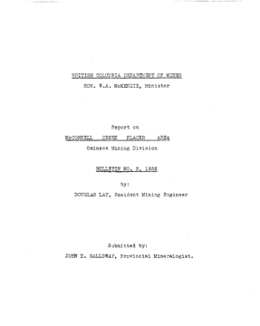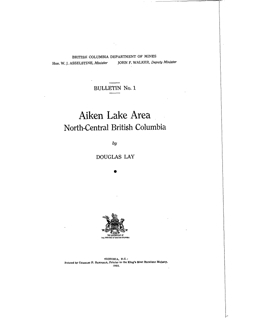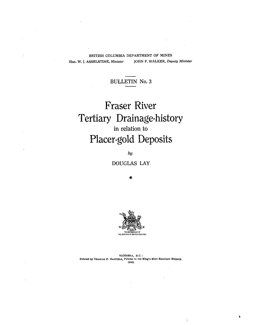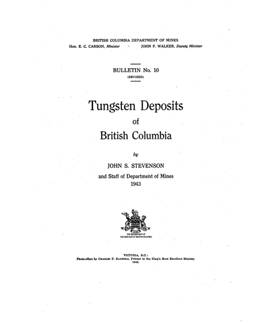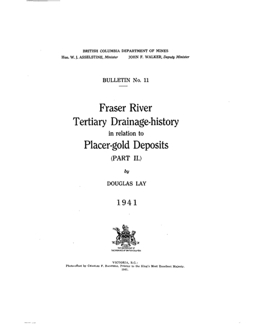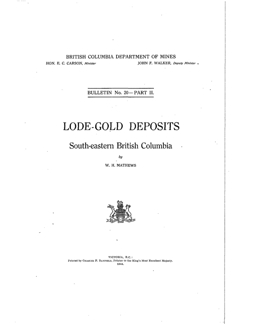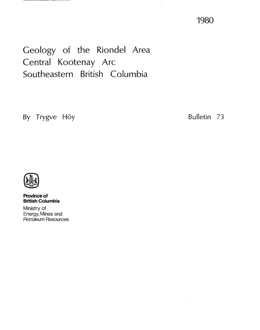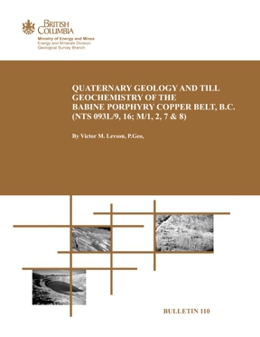Bulletins
The Bulletin series was started in 1896 for formal publications of the British Columbia Geological Survey. Because of increasing digital delivery of publications, this series has been retired.
Jump to: 1890-1915 | 1916-1940 | Bulletin 1-25 | Bulletin 26-50 | Bulletin 51-75 | Bulletin 76-100 | Bulletin 101-111
1890-1915
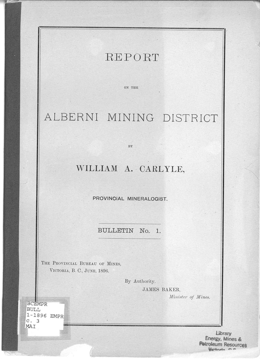
W.A. Carlyle
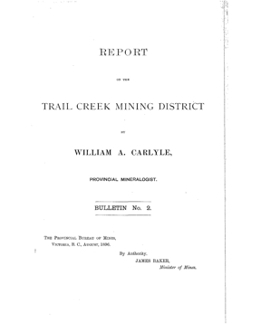
W.A. Carlyle
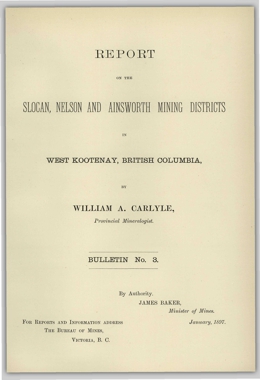
W.A. Carlyle
W.A. Carlyle
Not available
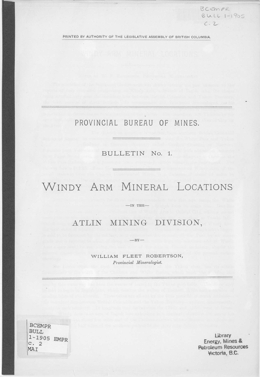
W. Fleet Robertson
H. Carmichael
Not available
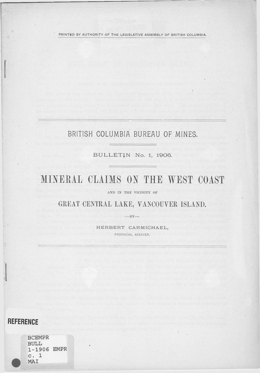
H. Carmichael
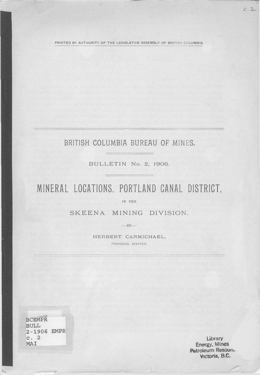
H. Carmichael
W. Fleet Robertson
Not available
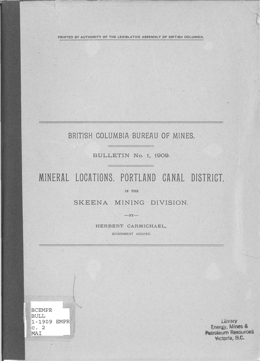
H. Carmichael
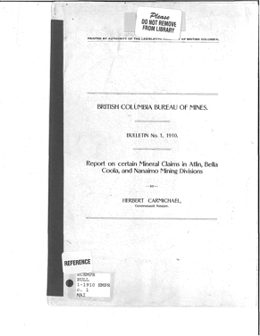
H. Carmichael
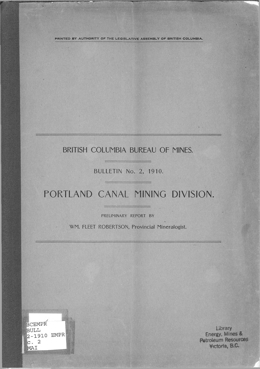
W. Fleet Robertson

Department of the Interior, 17 maps in 22 pp
W. Fleet Robertson
Not available
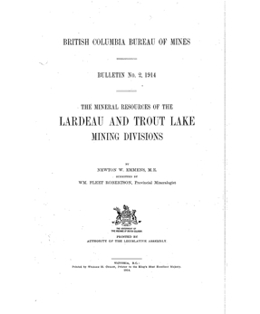
N.W. Emmens
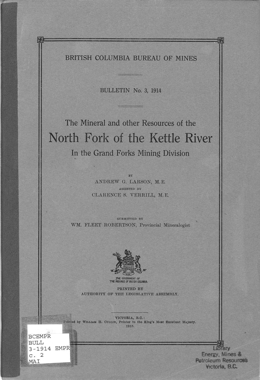
A.G. Larson and C.S. Verrill
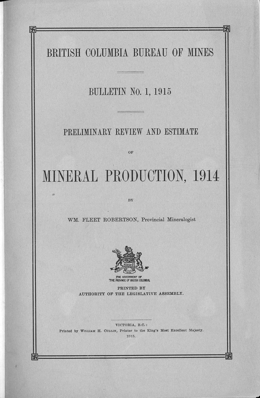
W. Fleet Robertson
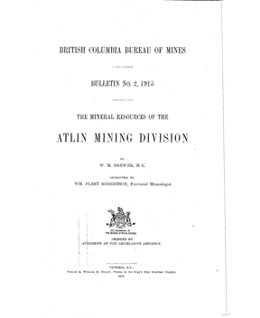
W.M. Brewer
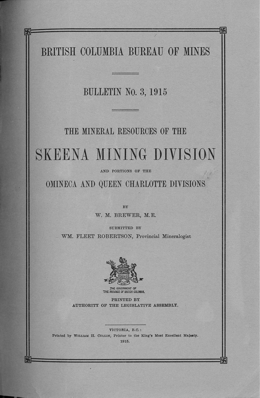
W.M. Brewer
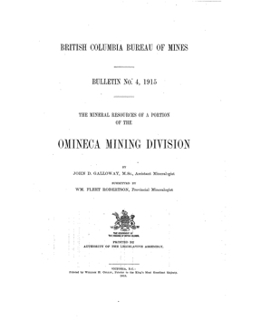
J.D. Galloway
1916-1940
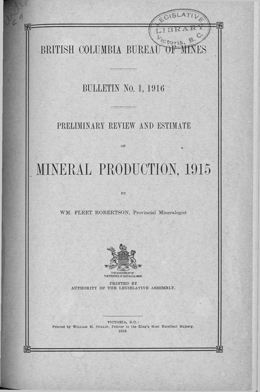
W. Fleet Robertson
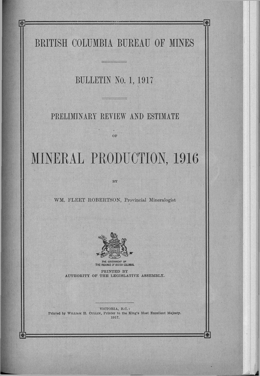
W. Fleet Robertson
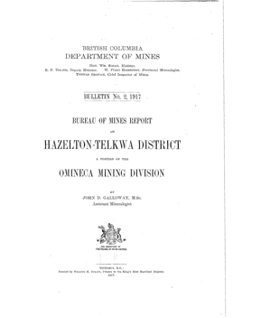
J.D. Galloway
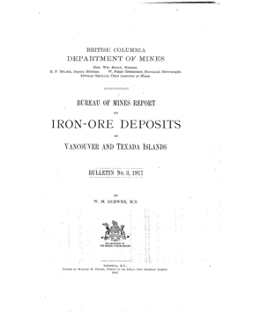
W.M. Brewer
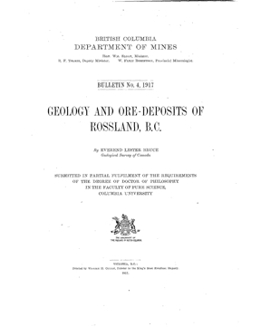
E.L. Bruce
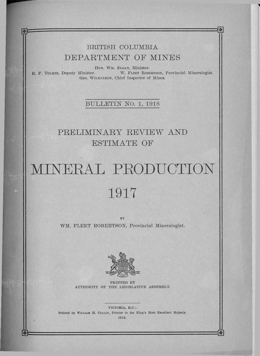
W.F. Robertson
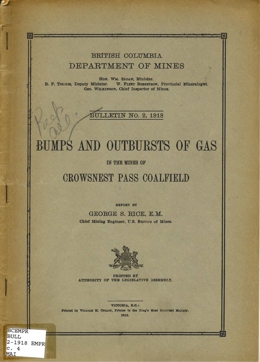
G.S. Rice
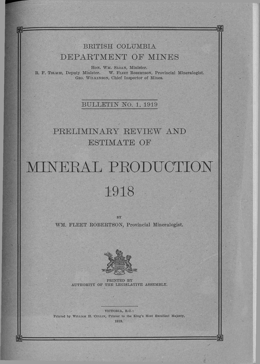
W. Fleet Robertson
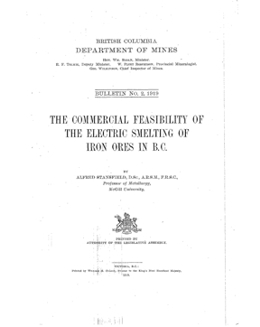
A. Stanfield
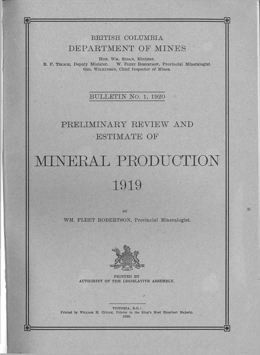
W. Fleet Robertson
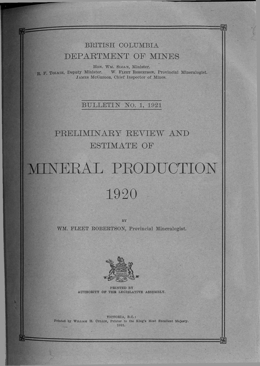
W.F. Robertson
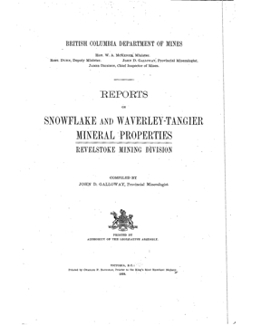
J.D. Galloway
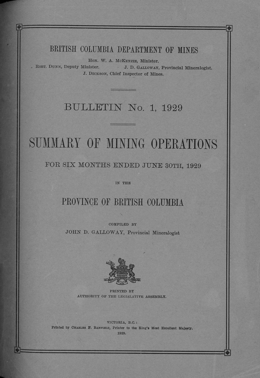
J.D. Galloway
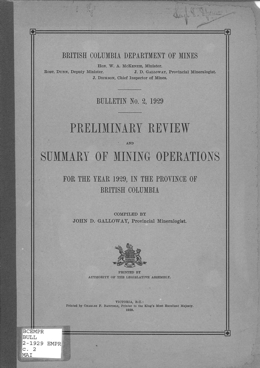
J.D. Galloway
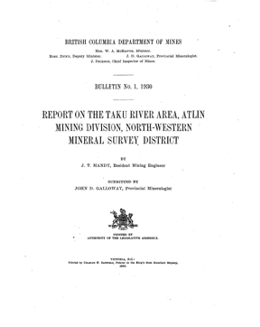
J.T. Mandy
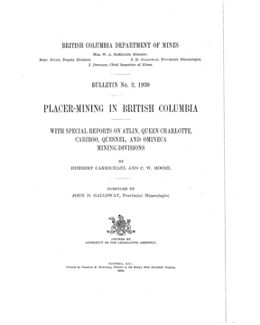
H. Carmichael and C.W. Moore
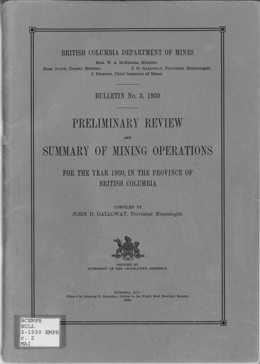
J.D. Galloway
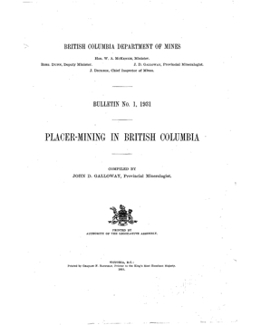
J.D. Galloway
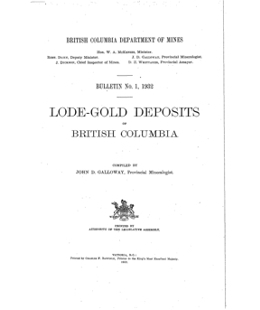
J.D. Galloway
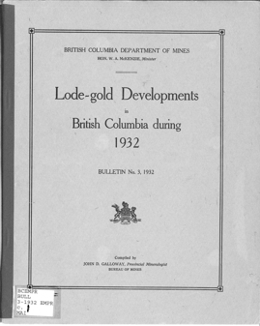
J.D. Galloway
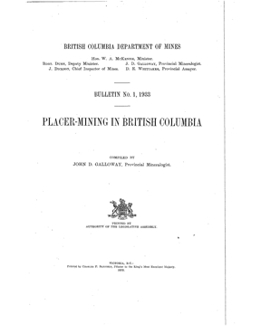
J.D. Galloway
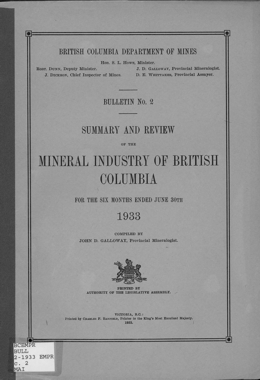
J.D. Galloway
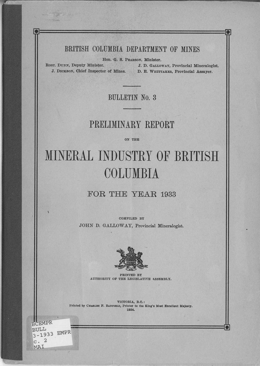
J.D. Galloway
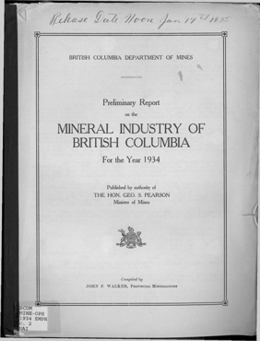
A.M. Richmond
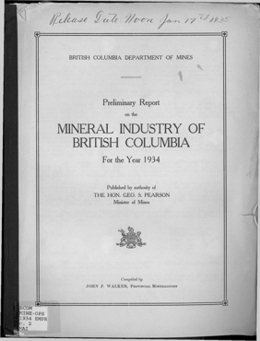
J.F. Walker
1940 onwards
Bulletin 1-25
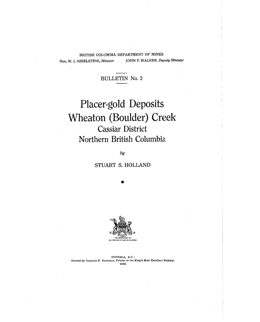
S.S. Holland
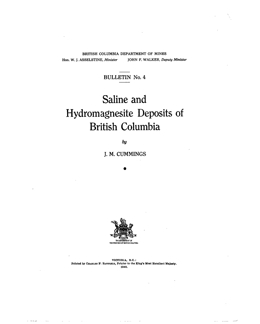
J.M. Cummings
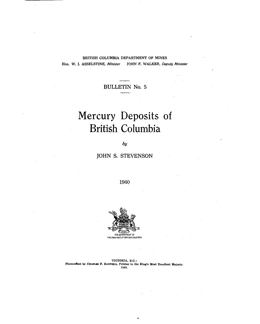
J.S. Stevenson
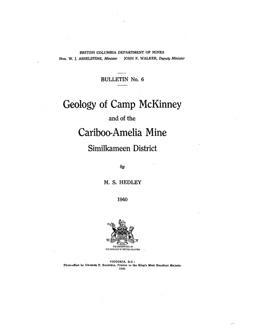
M.S. Hedley
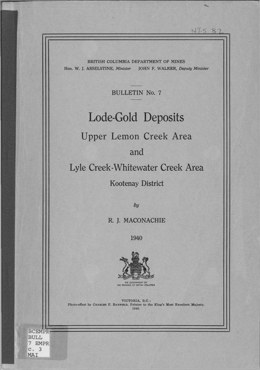
R.J. Maconachie
Bulletin 7 discusses lode-gold deposits of the Upper Lemon Creeks area and Lyle Creek-Whitewater Creek area, Kootenay District. Fieldwork in the area adjacent to the headwaters of Lemon Creek, undertaken during the 1939 season, was complementary to similar work completed on the lower reaches of the creek during the previous year.
Similar conditions prevail generally throughout these two entirely arbitrary subdivisions and reference to the Annual Report, Minister of Mines BC, 1938, which contains data on conditions farther down the creek, will probably be of assistance and permit a broader conception of the region as a whole. The sketch map which accompanied the 1938 report (Figure 1) together with Figure 2 (which accompanies this report), cover Lemon Creek for its entire length. Lemon Creek joins the Slocan River about 6 miles south from Slocan City.
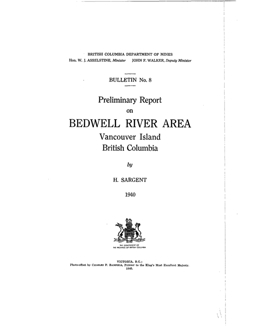
H. Sargent
H. Sargent
See Bulletin 8
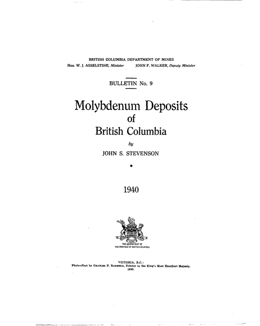
J.S. Stevenson
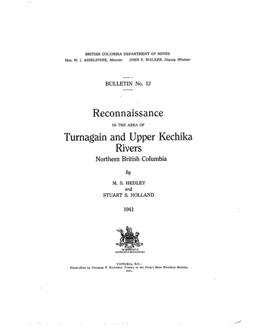
M.S. Hedley and S.S. Holland
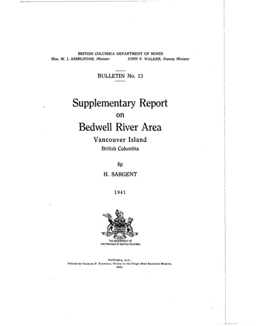
H. Sargent
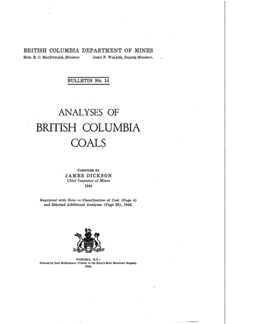
J. Dickson
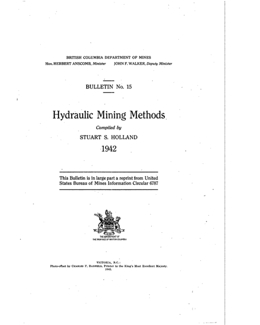
S.S. Holland
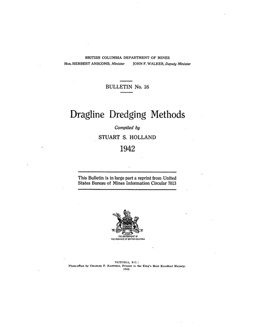
S.S. Holland
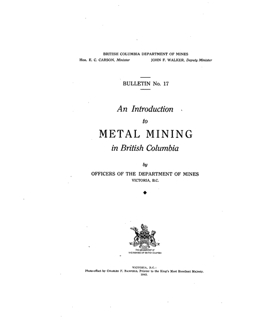
Officers of the Department of Mines
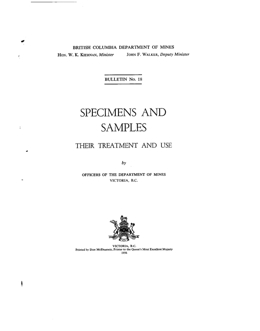
Officers of the Department
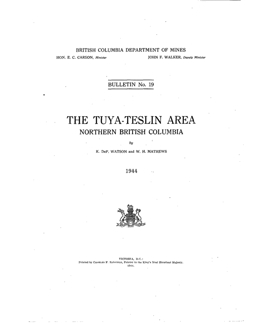
K. DeP. Watson and W.H. Mathews
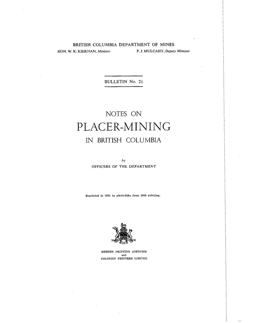
Officers of the Department, 1946, 42 pp. Revised 1947, 43 pp.
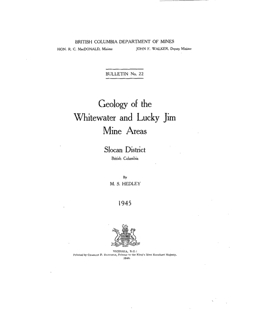
M.S. Hedley
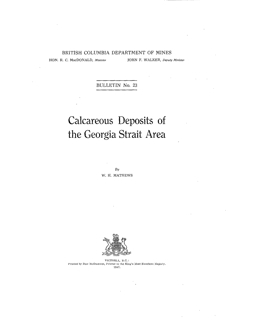
W.H. Mathews
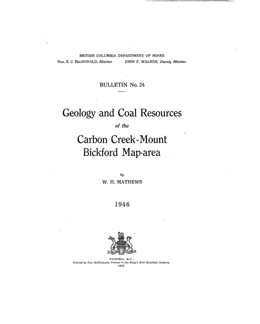
W.H. Mathews
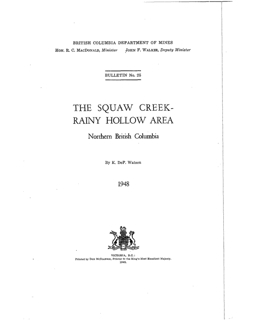
K.D.P. Watson
Bulletin 26-50
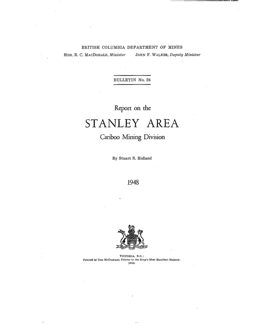
S.S. Holland
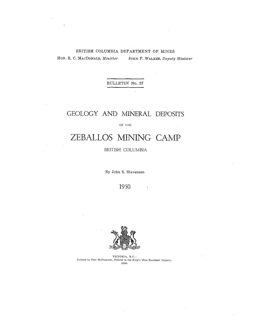
J.S. Stevenson
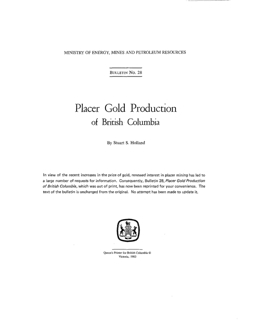
S.S. Holland, 1950 (reprint)
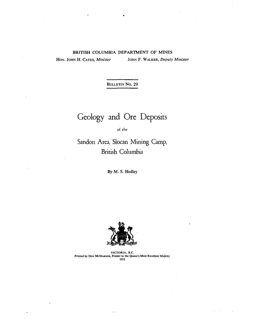
M.S. Hedley
Bulletin 29 covers the geology and ore deposits of the Sandon area, Slocan Mining Camp, British Columbia. Sandon has been a centre of production of silver-lead-zinc ores for sixty years. Mines in the area have contributed approximately half the entire output of silver and lead of the Slocan Mining Division. Mining activity has fluctuated widely with the condition of the metal market, and interest in the area has been renewed with the most recent rise in prices.
The area is 2 miles north of the northern boundary of the Nelson batholith and is underlain by sediments of the Slocan series, intruded by dykes and small stocks.
The Slocan series is of great thickness, only part of which is exposed within the Sandon area. In the area, tuff occurs in the upper part of the geologic column. The sediments are mainly argillites, quartzites, and limestones, or intimate admixtures of these rock types. For the most part the sediments are silty, estuarine deposits with rapid alternations in character; some are rhythmically banded. Cross bedding and evidence of turbulent deposition are common in many parts of the geologic column. The rocks are locally slaty.
Intrusive bodies are for the most part sill-like and some stocks are elongated with the structure. The general rock type is a quartz diorite, with a highly variable texture. Lamprophyres of the same general composition, but relatively rich in biotite, are common and grade into the quartz diorites.
Metamorphism of contact type is not marked. The principal product, which occurs locally, is a brownish rock produced by the development of biotite in some of the argillite. Silicification is widespread, affecting the rocks patchily and chiefly in the southern and western parts of the area. The rock most affected is limestone, which may be converted to a product very similar in appearance to quartzite. Silicification is not related to the lodes but to the general process of intrusion, and is only locally related to specific dykes or sills.
The structure is of a type not heretofore described. It is more Alpine than has previously been recognized in British Columbia and has far-reaching regional implications, although the implications are not considered in this bulletin. Certain details of the structure are believed to be closely related to the emplacement of the Nelson batholith but, as time has prevented study of the batholith itself, the relationship has not been proved.
The folding of the Slocan sediments is of recumbent type, the individual folds having axial planes with little or no dip and axial lines with little or no plunge. The entire assemblage is involved in one huge recumbent fold, striking northwesterly, which is open or concave to the southwest. This is termed the Slocan fold, and includes many smaller folds of various sizes and degrees of complexity.
The large complex Slocan fold is wrapped round the northeastern end of the Nelson batholith, east of the Sandon area. South of the area, and also east of it, the rocks deviate markedly from the northwesterly strike along the general east-west course of the batholith. The folded rocks swing through a right angle in strike in a huge crumple that is termed down buckling, and ultimately meet the batholith tangentially. This folding of folded rocks is a modification of the Slocan fold structure, and there is no evidence that it was produced by a second period or separate generation of orogeny; rather, it is believed to have resulted from a progressive change in stress application during late stages of the Slocan folding. A further modification of the Slocan fold is a broad cross-warp that extends across the entire structure from the vicinity of Idaho Peak to the vicinity of Retallack. The cross-warp is anticlinal, with low regional plunges to northwest and southeast on either side of it. It extends through the main productive belt of the Slocan mining camp.
Drag folds of all sizes are developed in characteristic relation to the large folds. The geometry of recumbent folding is such that all upper beds have moved relatively downward, the reverse of the movement observed in upright folds. Cleavage is developed locally, and in the main Whitewater and Payne slate belts it is produced at least in part by excessive interbed slippage which amounts to shearing. Axial-plane cleavage and shear cleavage cannot be differentiated except by structural reference, and some cleavage is of dual origin.
There are many faults, all of which are related to the structural complex and the forces that produced it. Two general classes of faults are recognized: tangential and crosscutting. The tangential faults are parallel in strike to the formation and commonly are bedded. The crosscutting faults cross the regional strike at large angles. The two classes are closely related in time of origin. All faults appear to be normal, and most have a lateral as well as a normal component of movement. The displacement on the tangential faults is a consequence of the folding and bears the same relative movement as the interbed slippage of which the faults are, in a sense, an extreme expression. The crosscutting faults are tear faults with a component of underthrusting.
The lodes are almost without exception crosscutting faults, of small and large size. In the Sandon area they cut across the structure but, immediately to the south in the valley of Silverton Creek, they are tangential to the down-buckled strata. It is believed that the larger faults of this class originated parallel with the down-buckled rocks as an extreme of this late phase of folding and in partial relief of the stresses that produced it. The larger faults or lodes stemmed from a focal area in lower Silverton Creek with steep dips to the northwest, rolled with the down buckle to a southeasterly dip and, in the zone of maximum curvature, continued across the northwesterly striking rocks.
Most of the lodes are complex, inasmuch as they represent zones of rupture with more than one locus of movement. They are to a considerable extent influenced by the structure they cross, in both strike and dip. They are zones of both fracture and shear.
Orebodies are related to zones of fracture rather than of shearing and as a rule occur in places of decreased confining pressure. The factors that may be said to have controlled ore deposition are many, and most orebodies were formed as a result of the conjunction of a number of favourable circumstances.
Metal distribution within the area and within individual lodes is of great importance. Factors which might limit the occurrence of ore at depth and which might produce lateral or vertical segregation are vital to considerations of development. No marked pattern of zoning or segregation is recognized, except for the fact that the margins of orebodies are relatively richer in zinc than in lead. The control of ore deposition is structural, and temperature and load pressure due to depth are of minor importance. The most important single factor was probably that of local confining pressure in a structurally complex environment.
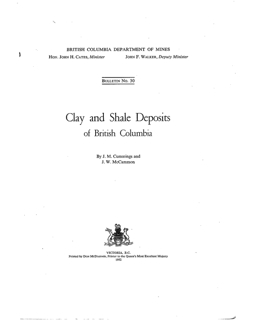
J.W. McCammon and J.M. Cummings
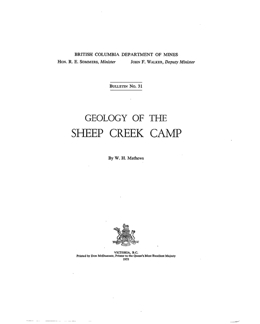
W.H. Mathews
Bulletin 31 describes the geology of the Sheep Creek camp, which has produced almost two-thirds of the lode gold credited to the Nelson Mining Division. Although the camp is currently non-productive, it ranks as the sixth camp in British Columbia in terms of total lode gold produced to the end of 1951.
The production of the camp has come from quartz veins that to the end of 1951 have yielded a total of 736,000 ounces of gold, 365,000 ounces of silver, 377,000 pounds of lead, and 312,000 pounds of zinc from 1,720,000 tons of ore. The production recorded year by year for the camp is set forth in Table VI on page 51. The accumulated gross value of the gold amounts to more than $24,000,000. Dividends paid from the profits of mines in the camp, mainly in the period 1935 to 1943, have amounted to $5,400,000.
Two main periods are recognizable in the productive history of the camp. The first began in 1899, reached its peak immediately before World War I, and ended in 1916. The second began in 1928 when a new vein on a new property, the Reno, was brought into production. In the next few years conditions became very favourable for mining gold, and the former producers, the Kootenay Belle and the Queen (Sheep Creek Gold Mining Limited), and a new producer, the Gold Belt, were equipped with modern mills. Production reached its peak in 1937 and was maintained at more than 135,000 tons a year until 1942. Thereafter production was mainly from the property of Sheep Creek Gold Mines Limited, which was shut down in 1951 after seventeen years of production. The camp is now inactive except for minor leasing-type operations. Both main periods ended in times that were unfavourable for gold mining, the mines being closed after ore that had been developed under more favourable conditions had been entirely or almost entirely exhausted.
The output of the camp has come almost entirely from oreshoots in quartz veins cutting folded quartzites that are part of a thick succession of Lower Cambrian and Precambrian (?) sedimentary rocks. A very small part of the total gold production has been recovered from narrow high-grade veins in limestone. The sediments are intruded by several stock-like granitic bodies, by an elongate swarm of quartz porphyry sills, and by numerous lamprophyre dykes. The granitic bodies are believed to be older than the ore and most of the lamprophyres to be younger. The quartz veins strike northeasterly across the axes of the folded sediments and generally dip steeply.
The Sheep Creek gold camp is within a district that contains numerous mining camps. Adjoining and nearby areas are important sources of tungsten and of silver, lead, and zinc. Several camps have contributed lode gold in varying quantities. Properties in the several camps of the district have yielded up to 120,000 ounces of gold each. The occurrences of gold in the district are dealt with briefly in Bulletin 20. Part 1, Lode Gold Deposits, Southeastern British Columbia, by W.H. Mathews, British Columbia Department of Mines, 1944. Interest in lead-zinc replacement deposits in areas adjoining the Sheep Creek camp has increased greatly since the field work for this bulletin was undertaken. Similar lead-zinc deposits have not been discovered within the boundaries of the area treated in the present report.
The sedimentary rocks in the Sheep Creek camp had been highly folded prior to the intrusion of the igneous rocks, and two tight northerly trending anticlines with an intervening syncline make up the major structures of the camp. Faults belonging to four sets cut across the folded structures (1) A group of northeasterly trending, south-easterly dipping, right-hand strike-slip faults with a small normal component of movement contain all the productive veins, (2) a very few northwesterly trending left-hand strike-slip faults, (3) several northerly trending normal faults; and (4) flat faults along which the hangingwalls have been thrust westward with respect to the footwalls.
The veins occupy the northeasterly trending faults and consist of quartz with minor amounts of pyrite and still smaller amounts of pyrrhotite, chalcopyrite, galena, sphalerite, and gold. The quartz in the veins is probably derived in large part by recrystallization of quartzite walls. Visible gold is rare. The ore is almost without exception confined to parts of the fault zones in which one or both walls are made up of quartzite, and the orebodies are, therefore, found where the veins intersect certain stratigraphic units, notably the quartzite units referred to as Upper Nugget and Upper Navada. The Motherlode member, also quartzitic, is for some unexplained reason almost completely lacking in orebodies. The Reno formation, predominantly argillaceous, is almost devoid of ore except in the Reno mine, where the rocks have been conspicuously metamorphosed. In the veins, the ore occurs in shoots; the other parts of the veins are either too thin, or too low in grade, or both, to justify stoping. In any one vein the profitable oreshoots have been found within a vertical range of not more than 1,600 feet. This vertical range for successive veins lies within a depth zone that slopes regularly from the northern to the southern end of the camp. At the northern end it is 5,500 to 7,000 feet above sea level and at the southern end of the camp, 4 miles distant, it lies entirely below the 3,000 foot level. Above this zone the vein fracture may persist, but at least within the quartzites, the veins are too narrow to contain orebodies. At the bottom of the zone, the veins persist and may be even wider than within the zone. A few veins have been explored at depths of not more than 250 feet below the bottoms of the deepest stopes. Although these veins are of good width, the parts rich enough in gold to constitute oreshoots were too small and too widely scattered to encourage further exploration and development. Within the favourable wallrocks and within the favourable depth zone, those parts of the veins striking most nearly east are more likely to contain ore.
Displacement on vein fractures is variable, and in any one vein, other things being equal, the width increases with the amount of displacement. However, the vein filling is not necessarily wide in vein fractures on which displacement has been large, nor narrow in those on which displacement has been small.
The grade of vein matter is exceedingly variable, patches of high-grade ore being distributed apparently at random within a vein. The area of such a patch measured in the plane of the vein is rarely more than a few hundred square feet and commonly is much less. In general patches of ore of which the grade exceeds 5 ounces of gold per ton are larger and more common in the upper part of the productive zone than at greater depths.
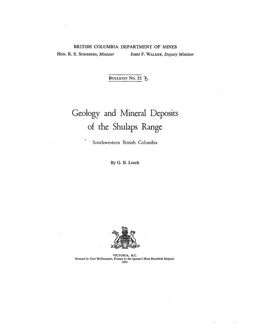
G.B. Leech
Bulletin 32 describes the geology and mineral deposits of the Shulaps Range on the northeast flank of the Coast Mountains in south central British Columbia. This study focused on the ultramafic rocks in the core of the Shulaps Range and only a narrow strip of the surrounding rocks was mapped. Most of the Shulaps Creek drainage basin and much of the west flank of the Range are underlain by pre-Upper Triassic argillite, chert and greenstone with local limestone layers. Their age is uncertain. Along the west flank and north of Liza Lake, argillaceous and tuffaceous sediments, impure sandstones and conglomerates with lesser amounts of dark cherty strata and limestone of the Hurley Group predominate. Chert pebble and cobble conglomerates and associated rocks of the Taylor Group underlie the area of Quartz Mountain and northward to Noaxe Creek. A greenstone-gabbro complex underlie an area southeast of Liza Lake.
The Yalakom fault zone, along the eastern side of the Shulaps Range, marks the eastern limit of the ultramafic complex. East of the fault zone, greywacke, argillite, siltstone, grit and conglomerate of Triassic or earlier age and Lowe Cretaceous greywacke, shale, conglomerate, limestone and chert.
The Shulaps complex contains gabbro, diopside pyroxenite, and variably fresh to serpentinized or carbonatized ultrabasic rocks, dominantly peridotites but including dunite and harzburgite.
In the most important mineral deposit type, gold occurs in quartz veins. Underground development has been performed on both gold and mercury occurrences in the area. Other targets are manganese, chromium and magnesite. The gold bearing quartz fissure veins cut dioritic porphyries that intrude peridotite. Mercury mineralization, described in Bulletin 5, occurs in andesitic lavas interbedded with volcanic breccias within the Yalakom fault zone. The rocks are highly fractured and locally ankeritized. It is laced with stringers containing dolomitic carbonate and quartz. Cinnabar occurs in part of the intensely ankeritized zone as stringers, blebs and disseminated grains and fracture coatings.
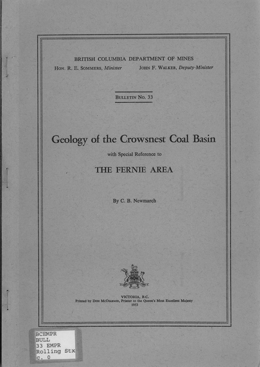
C.B. Newmarch
Bulletin 33 describes the geology and coal resources of an area surrounding the Fernie coal mines in southeastern British Columbia. Fieldwork on this project was carried forward under the auspices of the British Columba Department of Mines during the field seasons of 1946, 1947 and 1948.
It was prepared by C.B. Newmarch as a dissertation for presentation to the Faculty of Princeton University in candidacy for the degree of doctor of philosophy. The bulletin includes descriptions of the Michel strip mines and of a method proposed to assist in correlation of coal seams by use of spectrochemical analyses of the ash from coal samples.
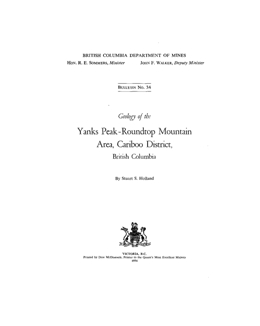
S.S. Holland
Bulletin 34 discusses the geology of the Yanks Peak-Roundtop Mountain area, Cariboo District, British Columbia. Characteristic features are:
- The Yanks Peak-Roundtop Mountain area lies at the head of several well-known placer creeks and contains numerous gold-bearing quartz veins.
- The recorded gold production of the immediately surrounding district is 69,237 ounces of crude placer gold and 5,204 fine ounces of lode gold.
- The area is underlain by a succession of schistose sedimentary rocks of late Precambrian and (or) Cambrian age known as the Cariboo group.
- Formerly the Cariboo group was subdivided into the Richfield, Barkerville, and Pleasant Valley formations. These formational names have been abandoned, and the rocks of the Cariboo group now are divided into the Cunningham limestone, Yankee Belle, Yanks Peak quartzite, Midas, and Snowshoe formations.
- The few intrusive rocks are dykes of diabase, diorite, rhyolite porphyry, and lamprophyre.
- The rocks of the area are involved in a major syncline flanked by two overturned anticlines and in detail are intricately folded. The original structural interpretation of Bowman and Uglow of a broad, simple anticlinorium involving huge thicknesses of rock must be abandoned.
- The rocks are cut by northerly and northeasterly striking normal faults. Some faults have a lateral displacement of 800 feet, and in most instances the eastern block has dropped downward.
- The area contains several centres of gold mineralization.
- The localization of veins is dominantly the result of structural rather than stratigraphic factors.
- The numerous quartz veins are grouped according to their strike into:
- Northerly striking veins occupying faults or shears.
- Northeasterly striking veins occupying tension fractures that may have formed originally as extension joints but which were reopened subsequently by tensional forces resulting from movement along the northerly faults.
- Easterly striking veins occupying shear fractures related to the northerly striking faults.
- Most quartz veins are associated in one way or another with northerly striking faults; either they occupy the fault, or they occupy northeasterly or easterly striking fractures that are related to it. The three vein directions represent fracture directions that are genetically related, being two complementary directions of shear and the associated direction of tension.
- The quartz mineralization of the three vein directions was essentially contemporaneous.
- Ankerite is a common gangue mineral of the quartz veins. Sulphide mineralization is generally sparse and consists of pyrite, galena, and sphalerite. Scheelite, arsenopyrite, and tetrahedrite have been found.
- Gold is associated with pyrite, and in outcrops becomes visible when the pyrite has been leached.
- The gold mineralization is considered to be post-Jurassic in age.
- The most productive placers were on Keithley, Little Snowshoe, Cunningham, and Harvey Creeks just beyond the limits of the area.
- The erosion of veins within the area is thought to have contributed placer gold to local accumulations, but the chief placer stretches derived their gold from bedrock sources outside the area and closer to the placers.
- In recent years several new mineral discoveries have been made, but future lode prospecting must be largely devoted to the finding of veins that are covered with overburden. The association of gold-bearing veins with northerly striking faults should provide a basis for close prospecting.
- It is unlikely that placer prospecting will result in the finding of placer deposits better than small unworked remnants suitable for individual sniping or small-scale operation.
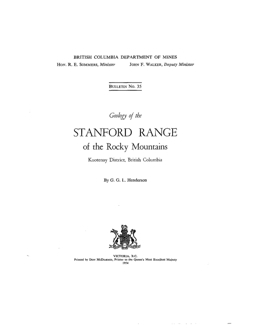
G.G.L. Henderson
Bulletin 35 covers the geology of the Stanford Range of the Rocky Mountains, Kootenay District, British Columbia. Features that characterize the area are:
- The Stanford Range is one of the western ranges of the Rocky Mountains lying between the Rocky Mountain trench and the Kootenay River, about midway between Cranbrook and Golden.
- The range has a maximum relief of over 6,000 feet and an average local relief of about 3,000 feet. Although it contains no glacial erosion features, the presence of erratics at high elevations indicates that at one time at least it was covered with ice.
- All the rocks in the Stanford Range are sedimentary. They range in age from Late Precambrian to Middle Devonian and consist mostly of limestones, dolomites, argillaceous limestones, and limy shales. The remainder of the section, about 30 per cent, is made up of black shales, quartzites, argillites, slates, conglomerates, and rock gypsum.
- The industrial mineral gypsum occurs in a thick section interbedded with occasional calcareous members, and the whole comprises a new formation for which the name Burnais is proposed. The age of the Burnais formation is between Middle Silurian and Middle Devonian.
- A unique metamorphic rock, resembling a phyllite, is developed within a mile-wide zone of shearing that follows the Kootenay and White Rivers on the northeastern side of the map area. This shearing is associated with a regional longitudinal fault named the White River break, and remains within the limits of McKay group strata throughout its exposed length.
- The Stanford Range is divided into three fault blocks by two longitudinal faults, the Redwall and Stanford, which extend throughout the length of the range. The fault blocks are named the Eastern, Central, and Western, and each contains distinct types of structures.
- The Eastern fault block, between the Kootenay River (White River break) and the Stanford fault, contains the lower limb of a southwesterly overturned, almost recumbent fold, which is locally contorted into large nappe-like drag folds.
- The Central fault block, between the Stanford and Redwall faults, is characterized by upright, inclined, and overturned anticlines which arc separated from each other by faulted synclines.
- The Western fault block, between the Redwall fault and the Rocky Mountain trench, contains complex, longitudinal trending folds that are intricately dissected by a network of faults. In addition, a large area is underlain by obliquely trending, imbricate thrust structures. These are indicative of shortening of the range along an axis almost parallel with its trend.
- The Redwall and Stanford faults, as well as many of the other faults in the range, are characterized by wide red- or brown-coloured breccia zones. The movement on the Redwall fault is large and is mostly strike-slip. Strike-slip movement may also have occurred on the Stanford fault, but, unlike the Redwall fault, this cannot be proved.
- Metamorphism in the Stanford Range is generally restricted to areas of tight folding and the border zones of major faults. With the exception of the intense alteration of McKay group rocks along the White River break, the effects of metamorphism are limited to those usually attributed to low-grade dynamic metamorphism.
- The Rocky Mountains at this latitude are composed of four separate structural sub-provinces for which the following names are proposed: Foothills sub-province, Front Ranges sub-province, Main Ranges sub-province, and Western Ranges sub-province. Each of these contains distinct structure, stratigraphy, and topography.
- The Stanford Range forms part of the Western Ranges sub-province, which is distinct from the other sub-provinces inasmuch as the folds are overturned toward the southwest instead of the northeast, the structures are a great deal more complex, and the structural trend is about 10 to 15 degrees oblique to the trend of the Rocky Mountains and the Rocky Mountain trench.
- The Western Ranges sub-province is separated from the Main Ranges sub-province by a major longitudinal fault zone that extends from Blaeberry southeastward along the Beaverfoot, Kootenay, and White Rivers for at least 120 miles. The name White River break is proposed for this fault. The sub-province is bounded on the southwest by the Rocky Mountain trench.
- The White River break separates the southwesterly overturned structures of the Western Ranges sub-province from flat to gently folded strata of the Main Ranges sub-province. It also marks a distinct break in the stratigraphic continuity of the western Rocky Mountains.
- The White River break appears to dip southwest. It is interpreted as a thrust fault of younger age than the southwesterly overturned structures of the Western Ranges sub-province, which are believed to have been formed by a major wedge uplift of the Main Ranges sub-province.
- Gypsum of commercial grade occurs in enormous quantities within the map-area, particularly along Windermere Creek and the Kootenay River. It is in the form of sedimentary rock gypsum, and the evidence of primary origin is conclusive.
- A preliminary graph is presented showing the stability relationships of gypsum and anhydrite as functions of temperature and pressure. Under average thermal conditions, gypsum appears to be metastable at depths below 3,500 feet, and in the presence of a water solution should be converted to anhydrite. In the presence of a salt solution, transformation should occur at shallower depths.
- The thickness of the known strata overlying the primary gypsum suggests that there was no post-Middle Devonian deposition in this part of the Western Rocky Mountains.
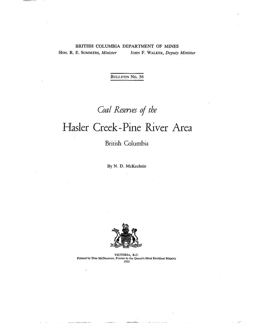
N.D. McKechnie
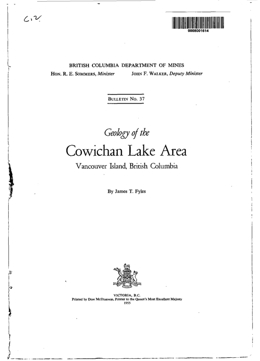
J.T. Fyles
Bulletin 37 describes the geology of the Cowichan Lake Area of British Columbia. The area referred to in this report as the Cowichan Lake area includes about 280 square miles of mountainous country on southern Vancouver Island lying mainly north and northwest of Cowichan Lake.
Fault-line scarps and fault-controlled valleys are the most prominent physiographic features of the region. The north side of Cowichan Lake is a fault-line scarp; and Rift Creek, the west fork of Cottonwood Creek, and the upper part of South Nanaimo River flow in fault controlled valleys. The continental ice-sheet covered the entire region. The ice appears to have moved southward.
The oldest rocks in the area belong to the Sicker group. They include thin-bedded, cherty, argillaceous, and feldspathic tufts; limestones; coarse and fine breccias; and minor intercalated amygdaloidal basalt flows. Crinoidal limestones at the top of the Sicker group contain Lower Permian fossils. The Sicker group is conformably or disconformably overlain by the Vancouver group.
The lower part of the Vancouver group is made up of a thick sequence of massive, pillow, and amygdaloidal basalt flows and related sills, dykes, and irregular bodies of diabase. The intrusive masses are equivalent to the Sicker gabbro-diorite-porphyrite described by Clapp. The upper part of the Vancouver group includes the Sutton limestone, which contains Upper Triassic fossils, and an overlying sequence of clastic sediments.
Rocks of the Sicker and Vancouver groups are highly deformed into northwesterly trending folds, many of which are overturned with both limbs dipping southwestward.
Plutons of Saanich granodiorite belonging to the Coast intrusions cut the Sicker and Vancouver groups. They are dominantly quartz diorite and granodiorite, but a roof facies of granite and aplogranite occurs near the top of Mount Buttle. The plutons are mainly steeply dipping, elongate bodies that are less than 2 miles wide and several miles long. In cross-section they cut across structures in the pre-granitic rocks; in plan, long axes are parallel to fold axes in the older rocks.
Close to plutons of granodiorite the pre-granitic basaltic rocks have been metamorphosed, exhibit granoblastic textures, and contain minerals characteristic of the granodiorite. Farther from granodiorite plutons, pre-granitic rocks have undergone a low grade of regional metamorphism that appears to be spatially related to the granodiorite.
Erosional remnants of Upper Cretaceous detrital sediments belonging to the Nanaimo group unconformably overlie the Saanich granodiorite and pre-granitic rocks. The Nanaimo group has been gently folded and displaced by steeply dipping faults. Most of the movement on the faults appears to be parallel to the dip, and the dip slip on several is more than 1,000 feet.
Small irregular masses of gabbro, possibly of Tertiary age, intrude rocks of the Sicker group and t he Saanich granodiorite.
Copper has been shipped from the Blue Grouse property on the south side of Cowichan Lake, and manganese from the Hill 60 deposit 4 miles east of Lake Cowichan. Copper occurs in chalcopyrite-skarn deposits at the Blue Grouse property and on the divide between Widow Creek and Chemainus River.
Quartz veins near bodies of granodiorite commonly contain molybdenite. On the Allies property on Mount Buttle, quartz-molybdenite veins have been prospected by trenches and open pits.
Shear zones in massive volcanics of the Vancouver group on El Capitan and the northeast slopes of Mount Service contain sulphides and gold. They have been explored by underground workings on the Silver Leaf and El Capitan properties.
At many places cherty rocks of the Sicker group contain manganese silicates, mainly rhodonite and manganese garnets. Within a few feet of the surface the silicates have been oxidized, and siliceous manganese oxides have been mined at the Hill 60 deposit.
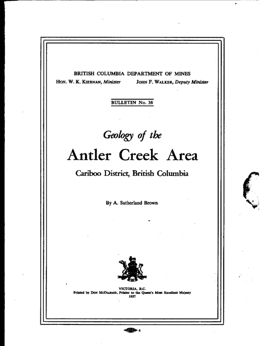
A. Sutherland Brown
Bulletin 38 describes the geology of the Antler Creek area in the Cariboo District of east central British Columbia about halfway between the northwesterly and southerly flowing parts of the Fraser River. The area adjoins the Roundtop Mountain-Yanks Peak area on the north.
The area is in a region transitional between the Interior Plateau to the west and the Cariboo Mountains to the east. A mountain ice-sheet covered the entire area at least once and, although the ice must have been almost static, some movement to the southwest occurred.
The geology is complex and there have been a number of interpretations of the structure and stratigraphy of the Cariboo group. The Cariboo group underlies the greater part of the area. Characteristic rocks of the group are phyllite, micaceous quartzite, and limestone. The group is divided into five formations, which are, from oldest to youngest, the Cunningham limestone, Yankee Belle formation of brown phyllite and lesser amounts of fine quartzite, Yanks Peak quartzite, Midas formation of black phyllite and metasiltstone, and the Snowshoe formation of micaceous quartzite, phyllite, and lesser amounts of limestone.
No fossils have been found in the group within the area, but just beyond it an Early Cambrian fauna has been collected from the Cunningham limestone. The Cariboo group is overlain with unconformity and great structural discordance by the Slide Mountain group of Carboniferous age.
The Slide Mountain group is composed dominantly of conglomerate, argillite, chert, and diabasic pillow laws and flow breccias. The group is divided into two formations-the basal Guyet formation, composed of conglomerate, flow rocks, argillite, and minor crinoidal limestone, and the Antler formation, composed of chert, argillite, and pillow lavas. The chert of the Antler formation appears to have originated by more than one process and the silica originated from more than one source.
Small acid dykes, the Proserpine dykes, cut the Cariboo group but not the Slide Mountain group. Basic intrusive rocks, the Mount Murray intrusions, cut both groups but are rare in the Cariboo group except adjacent to the Slide Mountain group. Sills in the latter group are composed of spilitic diabase, which is related spatially, texturally, and chemically, and hence probably also in age and origin, to the flow rocks of the group.
A great difference in manner and intensity of folding of Cariboo and Slide Mountain groups exists. The Cariboo group has been closely compressed into northwesterly trending complex folds, which are overturned toward the southwest in the Antler Creek area. A regional secondary foliation is developed in the Cariboo group essentially parallel with axial planes. Component grains have been flattened parallel to the schistosity. Fold structures of the Wells mining camp are asymmetrical and complex and cannot be mapped without interpretation. In contrast, the Slide Mountain group has been folded into simple, upright, and open structures parallel to folds in the Cariboo group. The rocks are neither schistose nor greatly deformed.
The Antler Creek area is an important source of lode and placer gold. The Cariboo Gold Quartz and Island Mountain mines at Wells have produced more than 32 million dollars in bullion from 1932 to the end of 1953. Placer mining has probably produced an equivalent amount, although only 15 million dollars is officially recorded because accurate statistics were not kept until thirteen years after the original gold rush of 1861. Current yearly lode-gold production (1954) has a value greater than 1.5 million dollars, whereas current placer-gold production ranges between one-tenth and one-fiftieth of this figure. This report is limited to lode. Placer was not studied because Bowman’s maps of the placer creeks (1895) and Johnston and Uglow’s report are accurate and thorough, and little could be added to them.
The lode deposits of the Antler Creek area are gold-bearing pyritic quartz veins and bedded replacements. These two types of orebodies are related in origin. Lodes have been found only within the Cariboo group. Replacement deposits have been found to date only in the Wells camp, and only at limited horizons and localities. Most deposits are in the Baker limestone beds of the Snowshoe formation, between the Rainbow fault and the northwest boundary of the Island Mountain property. Other thin limestone members intercalated in the Snowshoe formation are common, but have not yet been very productive. Some rare bedded orebodies replace argillaceous rocks.
Quartz veins are common and are widely distributed in the Cariboo group. Although some veins are very large, most are small and in some places are closely spaced. In general the sulphide content is low, but in certain areas they contain a fairly consistent quantity of pyrite with attendant gold.
The replacement deposits consist of massive fine-grained pyrite, which has entirely or selectively replaced the rock. Coarse grey ankerite commonly forms an envelope surrounding a deposit and may occur as streaks within it. Siliceous replacements and other sulphide minerals are rare. Replacement orebodies may be pencil-shaped or tabular, the form depending chiefly on the fold structures of the host rock.
The mineralogy of the quartz veins and replacement bodies is similar. Gold is the mineral of value. Silver is relatively unimportant because the ratio by weight of gold to silver in both types of ore is approximately 10 to 1. The precious metals are chiefly contained in pyrite, the dominant and commonly the sole sulphide mineral. A number of other minerals occur in minor amounts, including galena, sphalerite, cosalite, bismuthinite, scheelite, pyrrhotite, arsenopyrite, and chalcopyrite.
The gold mineralization is believed by the writer to be later than the formation of quartz veins. The veins are later than most of the northerly fault movement because they are concentrated beside the northerly faults, they occur in a conjugate set of fractures related to the faults, and they actually occur within the faults themselves. The major faulting and the vein formation took place later than the major folding of the Cariboo group and after the deposition of the Slide Mountain group. The mineralization is older than the gold-bearing Tertiary gravels. Therefore, on the evidence in the map-area the gold mineralization may have occurred between the Carboniferous and Early Tertiary. Outside the map-area auriferous quartz veins occur in the Quesnel River group (Late Triassic to possibly Early Cretaceous). It is not unlikely that those of the map-area are of Mesozoic age.
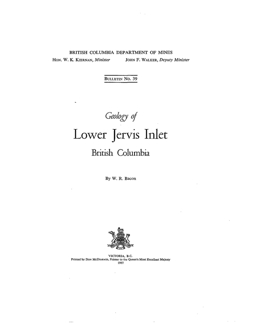
W.R. Bacon
Bulletin 39 notes that the flanks of the Coast Mountains have long been recognized as favourable prospecting ground and the eastern flank, which is entirely in Canada, has proved to be particularly favourable, with the discovery of the Tulsequah, Granduc, Premier, Alice Arm, Bridge River, and B.C. Nickel deposits. In contrast, the core has failed to receive comparable attention.
It is difficult to estimate the possibilities of finding new ore deposits in the core of the Coast Mountains because large areas are completely unmapped and the regional geology is relatively unknown. Nevertheless, the available information provides some basis for cautious optimism.
Within the area under appraisal important mineral deposits have been found in four localities: Howe Sound (Britannia mine), Observatory Inlet (Hidden Creek mine), Ecstall River, and Princess Royal Island (Surf Inlet mine).
The Surf Inlet deposits were gold-bearing quartz veins that averaged 0.39 ounce of gold per ton and 0.3 per cent copper for 1,012,067 tons mined. They proved sufficiently productive to sustain a profitable operation for many years. The veins occur largely in quartz diorite, but it is probable that the shear zone in which the veins occur was localized by a narrow septum of older rock.
Gold-bearing quartz veins have been found elsewhere in the granitic rocks. In addition, minor amounts of chalcopyrite, magnetite, molybdenite, and scheelite have been found but, generally speaking, developments to date have yielded little to encourage exploration of the granitic rocks, except along contacts with rocks that they intrude.
The copper-bearing sulphide deposits of Howe Sound, Observatory Inlet, and Ecstall River occur in roof remnants of layered rocks that are surrounded in plan by younger granitic rocks. The deposits of Observatory Inlet and Howe Sound have each yielded more than 100 million dollars in mineral wealth, and the Ecstall River deposits are known to contain at least 8,000,000 tons of similar ore but of lower grade. It is thus apparent that the rocks in which these large sulphide deposits occur are worthy of some scrutiny, and it is therefore important to consider what proportion of the core of the Coast Mountain is composed of them.
From existing maps it would appear that there is definitely a higher proportion of granitic rocks in the Vancouver-Skeena River interval of the Coast Mountains than in the Skeena River-Portland Canal interval. A recent estimate (Bostock, 1948, p. 82), however, that more than nine-tenths of the Coast Mountains core south of Skeena River is composed of granitic rocks would appear to be too high. An interpretation of the latest geological map of British Columbia (Geol. Surv., Canada, Map 932A, 1948) is that, at shoreline, at least 15 per cent of the region south of Skeena River is composed of non-granitic rocks. Moreover, it is perhaps reasonable to expect that, at higher altitudes, a greater percentage of these rocks will be found. Furthermore, the work in Jervis Inlet has shown that small areas of older rock have been overlooked in the rapid coastal survey, and that stretches of coast barren of outcrop are more likely to be under-lain by sedimentary or volcanic rocks than by the more durable granitic rocks. Thus, although a great deal more work is required before an accurate estimate can be made, it is probable that as much as 20 per cent of the Coast Mountains core south of Skeena River is composed of non-granitic rocks.
It has been shown that in Lower Jervis Inlet the non-granitic rocks occur largely in narrow, steeply dipping belts that persist over a vertical range of several thousand feet with little change in width. This generalization, applicable to an area chosen at random, demonstrates that the septum or deep remnant is not unique to Britannia or Ecstall River. It should not be assumed, however, that all the roof remnants persist to depths of several thousand feet. The Caren Range body of the Sechelt Peninsula is regarded as a true roof pendant, and other remnants probably occur with essentially the same shallow irregular form. The point, however, is that certain of the remnants do persist to depths of several thousand feet with little evidence of diminution in size and, because they do, there is no justification for a generalization that most deposits found in the older rocks will necessarily bottom in granitic rocks at depths of a few hundred feet.
The remnants of older rock found in the core of the Coast Mountains are small compared to their very productive counterparts in the Canadian Shield. Nevertheless, they are of sufficient size to accommodate very large ore deposits. For example, at Britannia the remnant in which eight very productive orebodies have been found is much smaller in area than some of the other known remnants in the Coast Mountains.
In summary, several points have been presented as a basis for appraisal of the economic potential of the interior of the Coast Mountains. They are:
- Three localities are known in which large sulphide deposits occur.
- The sulphide deposits are of similar type; in all, copper is an important constituent.
- The sulphide deposits occur within remnants of the eroded roof.
- Probably 20 per cent of the core of the Coast Mountains south of Skeena River consists of roof remnants; the proportion of roof rocks in the Skeena River-Portland Canal interval is considerably higher.
- Some of the remnants persist to depths of several thousand feet and should not be regarded as roof pendants in the usually accepted sense of that term.
- Some of the remnants are of sufficient size to accommodate large deposits.
The logical conclusion is that, pending evidence to the contrary; roof remnants in the Coast Mountains are definitely worthy of consideration in the search for new deposits of mineral, particularly copper.
Prospecting in the area has shown that rocks of the Jervis group contain small deposits of copper, zinc, lead and gold. Very small amounts of copper and gold have been found in the batholithic rocks; in addition, occurrences of molybdenite were observed southeast of Sakinaw Lake. Nothing has been found, however, to suggest that the granitic rocks of the map-area warrant further attention by prospectors.
Readily accessible dolomitic limestone, in sufficient quantity to be of potential economic importance occurs on the Cambrian Chieftain property.
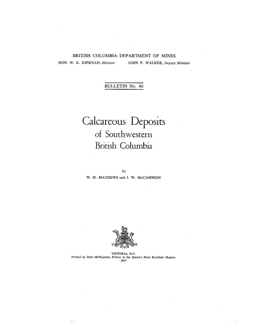
W.H. Mathews and J.W. McCammon
Bulletin 40 discusses the calcareous deposits of southwestern British Columbia, which exist mainly on Vancouver and Texada Islands. The origins, possible modifications to and weathering of limestones affect their economic potential. The composition and impurities are critical elements in the value and uses of the limestone. Common impurities are magnesium, silica, iron, sulphur and carbon.
Quarrying and Processing is influenced by the presence of impure beds and igneous bodies. Topography controls stripping ratio that strongly impacts on quarrying costs. Distance from market and nearness to tidewater are also vitally important. Further, marketing expertise is needed. Typical uses are in the building industry (Portland Cement, Builders' Lime and Building stone), agriculture, metallurgy and the pulp and paper industry.
Field criteria for recognizing calcium- and magnesium-rich limestones, sampling techniques and chemical analysis are discussed.
Deposits occur in the Cascade Mountains, on Texada Island and on Vancouver Island. Triassic host rocks are the most productive, but marl, travertine and shell deposits in younger rocks have been investigated. Limestone bodies enclosed in granitic rocks also have potential. The Texada Island deposits in the Marble Bay formation have been very important and production there began in the late 1890s.
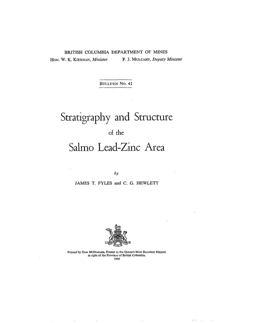
J.T. Fyles and C.G. Hewlett
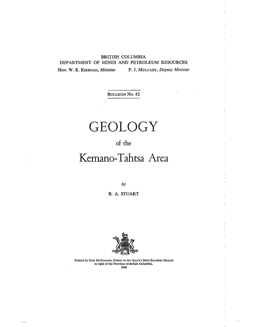
R.A. Stuart
Bulletin 42 describes the geology and engineering geology in a panel along the route of the Kemano hydroelectric tunnel in the Kemano-Tahtsa area built to provide power for the Aluminum Company of Canada’s Kitimat smelter. The area is 110 miles southeast of Prince Rupert in northwestern British Columbia. Work was done during construction of the tunnel. The surface geology of a 40 square mile area along the route of the tunnel was mapped at 1 inch to ¼ mile scale and an additional 140 square miles at 1 inch to ½ mile. Underground workings were surveyed at scale 1 inch to 50 feet.
The oldest exposed rocks comprise the pre-Middle Jurassic Tahtsa igneous complex, which consists of hornblende diorite and quartz diorite cut by quartz monzonite stocks, granodiorite dykes and basic dykes that is exposed as a window in the Hazelton rocks around the west end of Tahtsa Lake. The area is underlain in large measure by Middle to Lower Jurassic(?) Hazelton Group volcanic and sedimentary rocks and their metamorphic equivalents that unconformably overlie the Tahtsa complex. Volcanics, mainly andesitic lavas, breccias and tuffs, dominate Hazelton stratigraphy in the east. To the west, and lower in the section, these are joined by lenticular limestone beds and metamorphosed argillites and siliceous sediments. Metamorphic grade varies from greenschist to amphibolite facies. In the easternmost part of the area, Lower Cretaceous marine sandstones and shales overlie Hazelton volcanics. These form a 5000 foot section in a monoclinal panel. The contact is probably structural rather than an unconformity.
The Coast intrusions are post-Middle Jurassic and occupy the northern and western parts of the map area. They also form dykes and stocks in the older rocks. Intrusive types are gabbro, diorite, quartz diorite, granodiorite and an albite granite stock on Tahtsa peak. Intrusions range to batholithic dimensions. The Kemano gneiss, a zone of mixed granites and gneisses along the Kemano river, crosscut and metamorphose Hazelton strata. The Horetzky diorite and quartz diorite dyke varies from 4000 to 8000 feet in width and dips steeply. It intrudes the Tahtsa complex and Hazelton Group rocks. This dyke is important because more than half the hydroelectric tunnel is within it.
From an engineering perspective, rocks of the Coast intrusives were the most satisfactory and those of the Hazelton Group the least satisfactory and Tahtsa complex rocks more variable. The tunnel penetrated the Hazelton rocks near the footwall contact of the dyke, where they are sheared and fractured, which likely accounts for these results.
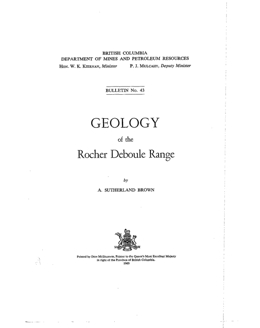
A. Sutherland Brown
Bulletin 43 describes the geology of the Rocher Deboule Range in west central British Columbia and forms part of the Hazelton Mountains. The range is elliptical in plan, 20 miles by 15 miles, and is isolated by wide valleys from adjacent mountain masses. The range is highly dissected with a total relief of 7,400 feet. During the glacial maxima the high peaks of the range probably rose above the general level of the Cordilleran ice-sheet.
The Rocher Deboule Range is underlain entirely by rocks of the Hazelton group and the Rocher Deboule stock of the Bulkley intrusions, but the adjacent valley contains in addition some Tertiary rocks. Only the upper two divisions of the Hazelton group occur in the map area. They are here named the Red Rose formation and the Brian Born formation.
The Red Rose formation includes 7,500 to 8,000 feet of marine and non-marine sedimentary rocks of the greywacke suite. In the map area the formation is divided into four members as follows:
Member / Lithology / Thickness / Feet
D Conglomerate. greywacke, and shale: partly marine 50-500
C Alternating greywacke, siltstone, and shale: partly non-marine 1000-1200
B Shale and siltstone; probably marine 4,000
A Alternating greywacke, siltstone, and shale with some pebble beds and coal; non-marine 2,500+
The Brian Boru formation includes 5,000 to 6,000 feet of purple, green, or grey porphyritic andesite breccias and massive flows with minor homblende porphyry andesite flows and some pyroclastic rocks. The ages of these formations are not known accurately, but the Red Rose formation is probably of latest Jurassic and earliest Cretaceous age and the Brian Boru formation of early Cretaceous age.
The Hazelton rocks are intruded by the Rocher Deboule stock, which underlies 27 square miles in the north central part of the range. The stock is formed of two phases, a slightly porphyritic granodiorite that underlies 24 square miles and a fine-grained quartz monzonite that underlies 3 square miles at the north end of the stock. The quartz monzonite appears to be the younger phase, but closely related in age and origin to the granodiorite. Fortuitous exposure reveals the upper part of the stock to be elongate in shape, a composite of two domes with a connecting saddle, oriented north 25 degrees west.
Jointing throughout the stock is pronounced, regular, and patterned. Three sets of joints form an orthogonal system, one set parallel to the contact, a second set striking normal to the contact and radial, and a third set dipping normal to the contact and intersecting it horizontally. The joints are believed to have resulted from cooling contraction of the stock. The Rocher Deboule stock was emplaced passively after the folding of the Hazelton group, between mid-Lower Cretaceous and late Upper Cretaceous. The mode of emplacement may have been by piecemeal stoping.
Rocks of the Hazelton group have been thermally metamorphosed by beat from the Rocher Deboule stock and a hornfelsic aureole has been created, with increasing grade toward the stock. The most pervasive new mineral is a purpled brown biotite, which occurs in a zone that is 2,000 to 5,000 feet wide horizontally. Higher-grade minerals such as zoisite, amphibole, pyroxene, garnet, sillimanite, and axinite are more erratically distributed than biotite and do not form concentric high-grade zones between the biotite line and the granodiorite contact.
In the Bulkley Valley several hundreds of feet of poorly lithified non-marine Paleocene greywacke and shales occur that are intruded and overlain by about 200 feet of columnar andesite flows.
The Rocher Deboule Range is a fairly homogeneous structural unit. Folding is moderate, with bedding dips as a rule less than 45 degrees, but details of the pattern are complicated. The major fold is a large scoop-shaped syncline with diverging limbs and an axis trending about north 55 degrees east and plunging 10 to 20 degrees northeast. This fold is less noticeable than the subsidiary folds parallel to the diverging limbs. Fold axes in the Hazelton and Skeena Mountains swing in a large smooth curve, from east in the southwest through northeast at Rocher Deboule, to northwest in the Skeena Mountains in the northeast. The Rocher Deboule Range represents a point of major flexure in this curve.
The range is cut by three large, northerly trending normal faults that raise the centre of the range as a horst. The rocks of the range are dropped in relation to neighbouring mountain masses. Faults in the valleys that isolate the range may form a complete elliptical system. The youngest Hazelton rocks, the volcanic breccias and flows of the Brian Boru formation, are preserved within the range and essentially nowhere else. The fundamental structure of the range may be a volcano-tectonic depression.
Ores worth eight million dollars have been produced from the range, chiefly tungsten and copper ores. The known mineral showings are concentrated peripherally about the stock, particularly around the northern dome of porphyritic granodiorite. They are chiefly veins filling minor shears which are extensions of joints of the orthogonal system. The veins have been mineralized in three stages. The first stage is primarily pegmatitic and characterized by hornblende with scheelite and ferberite; the second stage is primarily sulphide characterized by chalcopyrite, arsenopyrite, and cobalt-nickel sulpharsenides; the third stage is characterized by milky quartz with sphalerite, tetrahedrite, galena, and chalcopyrite, forming entities which distinctly cut mineralization of the first two stages. The veins probably owe their origin to the stock and their distribution to factors resulting from its cooling history, including the evolution of the joint system, minor shearing forces, and thermal control of deposition.
The principal producing properties are the Rocher Deboule copper mine and the Red Rose tungsten mine. These mines and the other prospects are described.
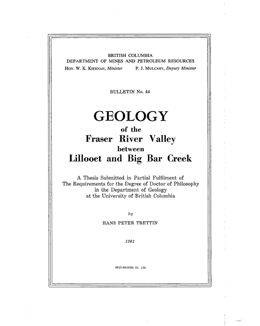
H.P. Trettin
Bulletin 44 describes the geology and mineral deposits of a 550 square mile area between Lillooet and Big Bar, British Columbia. The area was mapped at a scale of one mile to the inch.
In the southern part of the Bowman Range four members are recognized in the Middle (?) and Upper Permian Marble Canyon formation, which is partly composed of reefal limestone. This formation forms a northwesterly trending anticlinorium overturned to the northeast. The cherts, argillites, limestones and volcanic rocks west of the Bowman Range, originally referred to the Permo-Pennsylvanian Cache Creek group, are shown to be Permo-Triassic and are here assigned to the Pavilion group, a new group that is made up of two divisions. Microscopic and stratigraphic evidence is given that the cherts of this group are of radiolarian origin.
The Lower Cretaceous Lillooet group here is subdivided into three units. Divisions A and B are shown to form a northwesterly trending anticline.
Three members are now recognized in Division A of the Lower Cretaceous Jackass Mountain group.
The Lower Cretaceous Spences Bridge group is subdivided into several local and stratigraphic units. Two units previously assigned to the Spences Bridge group are correlated with the Kingsvale group on the basis of new fossil collections.
Some volcanic and sedimentary rocks originally referred to the Miocene Kamloops group are here correlated with Miocene to Pleistocene rooks of the Quesnel map area.
West of Lillooet a belt of serpentinite was mapped that has structural and lithological similarities to the Upper Triassic ultrabasic intrusions of the Shulaps Range. Granitic rocks of three ages are recognized and range from early Lower Cretaceous or older to mid Lower Cretaceous.
It had earlier been shown that the Fraser River fault zone consists of several normal faults with relative downward movement to the east. East of these faults the author recognizes another fault with relative downward movement to the west. Lower Cretaceous and early Tertiary rocks thus occupy a graben between Permo-Triassic units to the northeast and to the southwest. This graben probably controlled the deposition of Divisions B and C of the Jackass Mountain group. The faulting may be related to the isostatic rise of adjacent granitic masses. Evidence is given that the latest movement on one of the faults took place in mid Tertiary time.
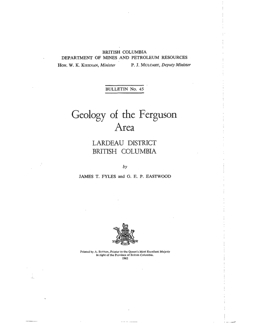
J.T. Fyles and G.E.P. Eastwood
Bulletin 45 describes the geology of the Ferguson Area, Lardeau District, British Columbia, which is in southeastern British Columbia, about 40 miles southeast of Revelstoke and 80 miles north of Nelson. The area is near the north end of the Kootenay arc, a curving belt of complexly deformed sedimentary', volcanic, and metamorphic rocks extending from Revelstoke southeast and south across the International Boundary.
This report is primarily a study of the structure and stratigraphy of part of the Kootenay arc and is one phase of a broader study of the arc that is continuing.
The area lies within the Selkirk Mountains. The highest summits have elevations just over 9,000 feet; the lowest point in the area, Trout Lake, has an elevation of 2,345 feet. The valleys of Gainer, Ferguson, Lardeau, and Wilkie (Trout) Creeks, which cut across the formational strike, provide good structural and stratigraphic cross-sections.
The area contains a thick sequence of highly deformed sedimentary and volcanic rocks intruded by small masses of diorite. Most of the rocks belong to the Hamill group, Badshot formation, and Lardeau and Milford groups. The Badshot is probably Lower Cambrian, though no fossils have been found in it. Rocks of the Milford group contain Mississippian fossils.
The oldest rocks are found in the northeastern part of the map area. They strike northwest and are complexly folded into tight and isoclinal synclines and anticlines with low plunge. The folds produce a cumulative dip to the southwest, and regionally the stratigraphic top is to the southwest.
The stratigraphic succession as exposed northeast of Trout Lake is summarized in a table of formations on page 13. This report gives the first detailed account of the succession within the Lardeau group.
Little is known of the stratigraphy and correlation of rocks in the area southwest of Trout Lake. Most of the area contains a succession of grey argillites, phyllites, and grits that are complexly folded and contain no distinctive markers. Two distinctive units, a light-grey dolomite and a green volcanic rock, are exposed along the southwestern edge of the map area.
The structure of the Ferguson area is dominated by complex folds. The folds are isoclinal in phyllitic rocks below the Ajax formation and are asymmetric or overturned in the overlying more competent formations. Northeast of Trout Lake, fold axes plunge at low angles both to the northwest and southeast and axial planes dip steeply. Southwest of Trout Lake fold axes plunge 20 to 40 degrees to the northwest, axial planes are essentially vertical, and many of the folds are isoclinal. The largest folds in the area are an anticline and complementary' syncline known as the Silvercup anticline and Finkle Creek syncline. The anticline is southwest of the syncline and separated from it by a series of strike faults named the Cup Creek fault zone.
The Silvercup anticline and the Finkle Creek syncline, though complicated in detail, have a general cross-sectional shape looking northwest of a letter "N." Southwest of the anticline and northeast of the syncline, the folds have the same general form and are smaller than the anticline and syncline. The pattern of folding implies a relative movement of the southwest side upward and over the northeast.
The principal mineral deposits in the area contain silver, lead, and zinc. Most deposits were discovered before 1900, and a great deal of the exploration and mining was done before 1920. Total production amounts to 44,259 tons. Gross contents: Gold, 6,941 ounces: silver, 2,205,383 ounces; copper, 5,439 pounds; lead, 9,056,174 pounds; zinc, 435,033 pounds.
As early as 1903, it was recognized that the mineral deposits in the Lardeau district fall into three belts - the lime dyke belt, the central mineral belt, and the southwest mineral belt. The most common deposits in the lime dyke belt contain galena in siderite, which has replaced limestone. In this belt are the Molly Mac, Index, White Quail, and Silver Chief properties, which are in the Lade Peak limestone and limestones in the Index formation. More than 85 per cent of the ore mined in the Ferguson area has come from the central mineral belt. The polymetallic veins of the Silver Cup, Triune, Nettie L, and True Fissure mines account for most of the production. These deposits and others from which there has been little or no production are veins and lodes containing galena, argentiferous tetrahedrite, sphalerite, and locally chalcopyrite. They are southwest of the Cup Creek fault zone and near the crest of the Silvercup anticline. Descriptions of many of the deposits within the area and their relationship to the regional structure and lithological types are given in Chapter 1V.
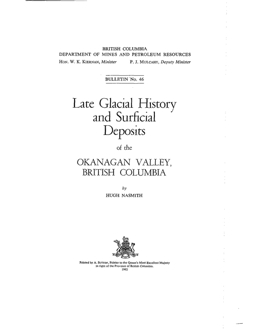
H. Nasmith, 1962 (reprinted, 1981 maps in pocket black and white)
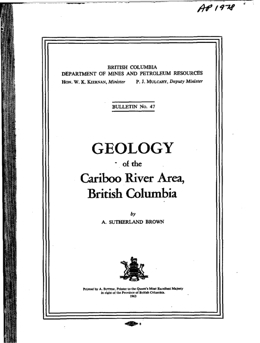
A. Sutherland Brown
Bulletin 47 discusses the geology of the Cariboo River Area, British Columbia, which includes about 1,000 square miles of dissected plateau of the Quesnel Highlands and alpine peaks of the Cariboo Mountains in east central British Columbia.
The area is underlain by three groups of stratified rocks. The Kaza Group is a thick succession (17,000+ feet) of gritty feldspathic micaceous quartzites and silvery green schists of Late Proterozoic age. It is overlain conformably by the Cariboo Group of Cambrian, Ordovician (?), and later age. This group is composed of 7,000 to 9,000 feet of phyllites, micaceous quartzites, and limestones and is divided into six formations. Carbonate and fine elastic rocks are dominant in the lower part of the group, whereas coarser elastic rocks are dominant in the upper. The Slide Mountain Group is composed of at least 5,000 feet of basal conglomerate, pillow basalts, and bedded chert, and is probably of Mississippian age.
Tectonism rose to a peak toward the end of Kaza deposition, but stable shallow marine conditions persisted throughout early Cariboo deposition. Tectonism increased again erratically but progressively toward the close of Cariboo deposition. Folding and metamorphism preceded deposition of the Slide Mountain Group.
The structure of the region culminates in a broad northwest-trending anticline, the Lanezi arch, which exposes the Kaza Group. This fold is flanked on the northeast by the Isaac Lake synclinorium, a system of moderately tight folds and parallel normal and thrust faults. Individual folds are overturned to the southwest, and the intensity of overturning and compression increases toward the Lanezi arch (southwest). The synclinorium exposes chiefly Cariboo Group and some Kaza Group. The Lanezi arch is flanked on the southwest by a folded belt of Cariboo Group, and this is overlain in part by the trough of the Slide Mountain Group. Folds in the Cariboo Group are gentle on the flank of the Lanezi arch but increase in overturning and compression to the southwest, becoming isoclinal toward the Little River. All folds plunge gently northwestward.
A system of strike faults is related to folds of the Isaac Lake synclinorium. Northerly and northeasterly normal faults are widely distributed and compensate in part for the northwestward plunge of folds.
All elastic rocks except those of the Slide Mountain Group are schistose, but the degree varies widely with locality and rock type. Schistosity is generally related to fold axial planes. In the Lanezi arch it is related to the axial planes of some of the larger secondary folds of the flanks, but progressively changes to bedding schistosity toward the main axis.
In general, Kaza rocks are in the biotite-chlorite subfacies and Cariboo rocks in the muscovite-chlorite subfacies of the greenschist facies. Toward the southwest, Cariboo rocks have been raised locally to amphibolite facies in association with a belt of small plutons at the edge of the area.
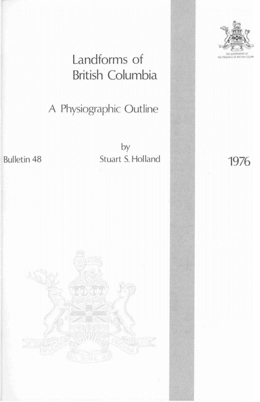
S.S. Holland, 1964 (revised 1976)
This bulletin is an authoritative account of the major land subdivisions of British Columbia. It defines the boundaries of the various mountain, plateau, or plain areas, many of them for the first time. Agreement has been reached with the Canadian Permanent Committee on Geographical Names, with Provincial Government officials, and with geologists and the various sorts of map-makers whose knowledge of the Province is most thorough.
The form of presentation, and much of the subject-matter, is a reflection of the mind and the interests of the writer, who was a field geologist with a broad knowledge of the Province. Concluding are five short essays that are written to clarify the text, and complete glossary of terms.
In 2009 Mitch Mihalynuk, a project geologist with the BC Geological Survey, digitized the PDF map, and the Manifold map and Shape files are provided with this publication. The Manifold map includes the B.C. border and symbolized boundaries between physiographic regions.
See also: Mathews, W.H., 1986. Physiographic Map of the Canadian Cordillera. Geological Survey of Canada, "A" Series Map 1701A, Scale 1:500,000.
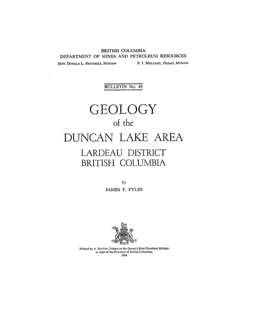
J.T. Fyles
Bulletin 49 covers the Duncan Lake area, which includes about 200 square miles in southeastern British Columbia containing Duncan Lake and the north end of Kootenay Lake. The area straddles the Purcell trench, the western part lying along the eastern slope of the Selkirk Mountains and the eastern part lying in the Purcell Mountains. Rocks of the area form part of the Kootenay arc, a curving belt of complexly deformed sedimentary, volcanic, and metamorphic rocks extending from Revelstoke southeast, south, and southwest across the International Boundary. This report is primarily a study of the structure and the structural setting of lead-zinc deposits developed recently at the Duncan mine.
Rocks in the area belong to the Hamill and Lardeau Groups and are highly deformed sedimentary and volcanic rocks. The lithology and stratigraphy are summarized in the table on page 32. They are very similar to rocks of the Ferguson area 50 miles to the northwest, with which they have been correlated. Many of the formations can also be readily correlated with rocks in the Salmo area, 150 miles to the south, and the Rogers Pass area, 100 miles to the northwest. Though no fossils have been found in the Duncan Lake area, the rocks are known to be pre-Mississippian, and the Badshot Limestone, a prominent marker in the area, elsewhere contains Lower Cambrian fossils.
Sills of felsite, which are common in the southwestern part of the area, dykes of lamprophyre, and small sill-like bodies of amphibolite constitute the only intrusive rocks.
Within the area the grade of regional metamorphism increases from low grades characteristic of the northwesterly trending part of the arc northwest of Duncan Lake to garnet and higher grades characteristic of rocks along Kootenay Lake. The garnet isograd trends north from near the northwest corner of Kootenay Lake to the northern end of Duncan Lake.
Complex folds dominate the structure of the area. Several stages of folding are recognized, which probably all belong to one orogenic period, thought to be Mesozoic. The oldest folds recognized, called Phase I folds, are isoclinal and plunge at low angles to the north. Most of these folds cannot be seen, and are reconstructed from studies of the distribution of rock sequences and the mapping of formations. The limbs and axial planes of these folds are curved and have been folded by Phase II folds.
The principal Phase I folds are, from east to west, the Howser syncline, the Duncan anticline, the St. Patrick syncline, and the Meadow Creek anticline. Phase II folds are more open than Phase I folds. The folds plunge mainly to the north and northwest at angles as great as 30 degrees, but most plunge between north 15 and 25 degrees west at 5 to 10 degrees. Phase II folds are clearly visible in many outcrops and are defined by the layering of the rocks and by the attitudes of the formations.
Strike faults, many of which are parallel to the cleavage planes in Phase II folds, are common. Some faults are related and subordinate to the folding; others are superimposed on it.
The most important mineral deposits in the area are relatively low-grade zones of lead-zinc mineralization that have been developed recently but not mined. They are referred to as the Duncan type of deposit, from the Duncan mine. Essentially all the deposits of the Duncan type are in the Badshot Formation on the Duncan anticline. Some 15 to 20 mineralized zones of this type are known within the map area.
They consist of pyrite, sphalerite, galena, and minor pyrrhotite disseminated in dolomite and siliceous dolomite. They are lenticular zones with gradational but, in general, well-defined margins. The attitude is essentially parallel to that of the enclosing formations; the largest dimension is parallel to the strike, and the intermediate dimension is parallel to the dip. The longest axes of the mineralized zones plunge at low angles to the north, parallel to the axes of Phase II folds. The greatest plunge length found so far is more than 3,000 feet . The height may be as great as 500 feet, and the thickness is generally a few tens of feet but may be as much as 100 feet. The average grade is less than 10 per cent combined lead and zinc, and the grade of the zinc is greater than that of the lead.
Dolomite and siliceous dolomite in which The Duncan type of deposits are found are dark-grey rocks with mottled, flecked, and banded textures resulting from deformation. The mineralized zones appear to be structurally controlled replacements of the dolomite. Relatively thick and continuous dolomite layers on the Duncan anticline have localized mineralization.
The only production from mines in the area has been from a number of silver-rich lead-zinc deposits of various types. Total production from the area amounts to 2,100 tons from five properties. Four of these properties are veins and replacements in limestone and dolomite. The fifth property contains quartz veins carrying tetrahedrite.
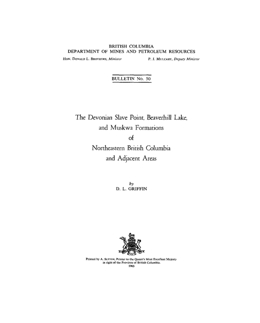
D.L. Griffin
Bulletin 51-75
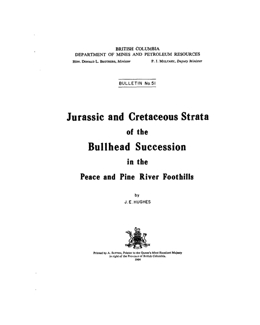
J.E. Hughes
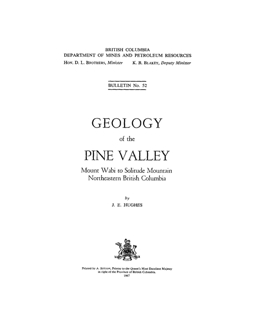
J.E. Hughes
Bulletin 52 describes the geology of the Pine Valley area from Mount Wabi to Solitude Mountain in Northeastern British Columbia.
The map area covers the Pine Valley, in the Rocky Mountain Foothills or northeastern British Columbia, from latitude 55 degrees 30 minutes to latitude 55 degrees 45 minutes north. The exposed rocks are Triassic, Jurassic, and Cretaceous in age. The succession (Ladinian to Cenomanian) is between 10,000 and 20,000 feet thick, and mostly of marine deposition. Most stratigraphic units thicken westward.
In the Triassic, the Grey Beds contain limestones, dolomites, siltstones, and sandstones; and the overlying Pardonet Formation, argillaceous limestones with fossil shell beds of Halobia and Monotis.
The Fernie Group of Jurassic age consists of: thin limestone, interbedded shales and siltstones with cherty banding, the Nordegg Beds; followed by the Middle Shales; and in the upper part, interbedded shales, siltstones, and sandstones, the Transition Beds, which mark the change to Beaudette deposition. The Beaudette Group of late Jurassic to early Cretaceous age has three formations; the Monteith, thick sandstones mostly, and with quartzites in the upper third part; the Beattie Peaks, interbedded shales, siltstones, and sandstones; and the Monach Formation, sandstones, with or without quartzite beds at the top. Facies changes and incomplete outcrops make it advisable to map Beaudette strata as an undivided unit to the west.
Coal measures overlying Beaudette strata are described by the term Crassier Group. The group is a continuous sequence of deposits in the field. They have a complex lithology: shales, mudstones, siltstones, sandstones, grits, conglomerates, and coals, laid down in cyclic repetition. The sequence is undivided to the west. Eastward it can be divided into the Brenot, Dresser, and Gething Formations, according to their sand/shale ratios, the nature of the cyclothems, and the distribution of the coarser clastics.
The Fort St. John Group contains alternations of shale formations, the Moosebar in the lower part, the Hasler, and the Cruiser, with sandstone formations, the Commotion, and the Goodrich. These units are largely marine, with the exception of thin non-marine beds and coal measures in the Commotion Formation. The Dunvegan strata are mostly non-marine, and they form the youngest formation of the Cretaceous in the map area.
The sedimentary rocks were deformed and uplifted in the Rocky Mountain orogeny, one phase of the Laramide revolution. The Rocky Mountain Foothills in the Pine area are in two parts: the Inner (or Western) Foothills and the Outer (or Eastern) Foothills. The structures of the Inner and Outer Foothills represent different tectonic styles. Close folding and thrusting prevailed in the Inner Foothills, and the deformation resembles that of the Rocky Mountains on the west. The Outer Foothills contain long anticlines separated by wide synclines, and here the deformation was restricted to the anticlinal folding, and faulting along the anticlines. The Outer Foothills belong to the orogenic foreland. Their structures can be ascribed to block faulting in the basement, though positive evidence is lacking.
Folding in the Foothills is of parallel type. The fold forms are concentric, or angular. The angular folds (that is, parallel folds of non-concentric form) include those of cuspate and lambdate forms, in the writer's classification. Two types of concentric folds are distinguished-those of low and high fold amplitude respectively.
Concentric anticlines of low fold amplitude occur in the Outer Foothills. The Commotion anticline is the only example that has been drilled to depth. Its surface and subsurface structures differ considerably, and they are separated by a low angle thrust, or décollement, or a zone of complex folding and shearing. High-amplitude concentric anticlines have fold centres at shallow levels, and may be underlain by cuspate and angular folds, as well as décollements. Concentric folds of high amplitude, cuspate, and angular folds occur together in the Inner Foothills.
According to the writer's view, cuspate anticlines developed by replacing concentric anticlines during the folding compression. Lambdate folds are not specially related to concentric folds, and the few examples noted lie close to fault planes.
The structures of the Pine Valley area form part of a larger tectonic frame-work, which includes: the junction of the northern and southern parts of the Rocky Mountains; and in the Plains, the junctions of three tectonic units of the foreland, the Halfway block, the Fort St. John arch, and the Alberta syncline. The junction of tectonic units of the foreland now occupy the site of the Peace River embayment, a paleotectonic basin of differential subsidence and sedimentation lying transversely to the former miogeosyncline along the site of the Rocky Mountains and Foothills.
Observations, and analyses of structural geology presented here, are of use in exploring for petroleum and natural gas. Natural gas has been discovered in the Pine River anticline. Important reserves of coal occur in the Pine Valley.
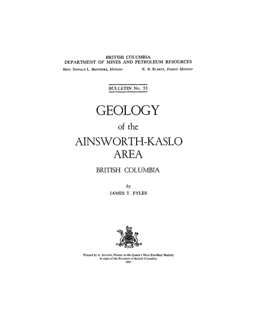
J.T. Fyles
Bulletin 53 covers the geology and mineral deposits of the Ainsworth-Kaslo Area, which is along the western side of Kootenay Lake 40 to 60 miles northeast of Nelson in British Columbia. It is in the central part of the Kootenay Arc, a curving belt of complexly deformed sedimentary, volcanic, and metamorphic rocks extending from Revelstoke southeast, south, and southwest across the International Boundary. The map area is in the northerly trending part of the arc adjacent to the eastern margin of the Nelson batholith.
This report is primarily a study of the structure and the structural setting of lead-zinc deposits in the Ainsworth mining camp.
The rocks of the area range from Lower Cambrian to Upper Triassic and include medium- and fine-grained mica schists, limestones and marbles, homblende schists and quartzites. They are intruded by sills and lenses of fine-grained granite, granite pegmatite, the Nelson granitic batholith, and by lamprophyre sills and dykes. Details of the lithology are summarized in the report and tentative correlations are shown. The rocks belong to the Lardeau, Milford, Kaslo, and Slocan Groups.
The grade of regional metamorphism increases toward the east, from biotite near the Nelson batholith to sillimanite grade along the shore of Kootenay Lake. Throughout the area the rocks, which are strongly foliated, dip at moderate angles to the west and are split by strike faults essentially parallel to the foliation. In each fault slice, isoclinal folds are the oldest structures recognized and are referred to as Phase I folds. They have a low plunge, dominantly to the north, and mainly west-dipping curved axial planes. More open folds, called Phase II, are also found in each fault slice. They have a low plunge to the north and have axial planes with a low to moderate dip to the west. In general they cause the west-dipping foliation to steepen upward. They have the form in profile of a modified S when viewed from the south. Late folds, which in general plunge at moderate angles to the west and northwest, and have steeply dipping axial planes that strike between west and northwest, are found locally. Phase I and Phase II folds are tentatively correlated across the fault slices and with the same sort of structures in the Duncan Lake area 20 miles to the north.
The Ainsworth Camp contains more than 50 properties from which silver-lead-zinc has been produced. In addition, there are many other showings from which there has been no production. Total production since the first shipment in 1889 has amounted to 763,858 tons of ore to the end of 1964.
The deposits are mainly simple quartz carbonate veins containing shoots and lenses of galena, sphalerite, pyrite, and locally pyrrhotite. The veins form three fairly well defined systems and two or three clusters, or poorly defined systems. The vein systems are zones of faulting. The Florence trends north 70 to 75 degrees west and dips 45 degrees to the south. The Highland strikes northwest and dips steeply to the southwest, and the Highlander strikes north and dips 45 degrees west parallel to the foliation. The attitudes of the veins and mineralized fractures are summarized in Figure 8.
The vein fractures are normal faults with a maximum displacement of a few hundred feet. In veins that transgress the foliation, sulphides tend to be concentrated (a) where the veins pass from one rock type to another, (b) where the veins branch or split, and (c) where the veins have tended to open by displacement during mineralization. Commonly these situations are combined. In the veins parallel to the foliation, the control of mineralized shoots is more difficult to determine.
Individual orebodies are small. The largest stoped areas are about 600 feet along the strike, 800 feet parallel to the dip, and 4 to 6 feet wide. Judging from production figures, grades of more than 50 per cent lead and 20 per cent zinc were obtained in ore sorted for direct shipping, whereas grades of about 5 per cent lead and 2 per cent zinc were obtained in ore mined in quantity for milling. The silver content amounts to one-half to one-third of an ounce per ton for every unit of lead.
Replacement deposits of galena, sphalerite, pyrite, and pyrrhotite in fractures in the Ainsworth limestone and Early Bird Formation constitute the largest known reserve in the camp. They are geologically like the Bluebell deposits on the eastern shore of Kootenay Lake directly across from the north end of the Ainsworth Camp. On the Lakeshore property in the Ainsworth Camp, where this type of deposit has been extensively explored by Cominco Ltd., five groups of fractures along which sulphides have replaced the lower Ainsworth limestone strike between north 65 and 75 degrees west and dip steeply to the south. Replacement mineralization has spread out from the fractures a few inches to a few feet along the foliation at several horizons within the limestone.
This study of the Ainsworth-Kaslo area has shown that the fault and fracture system containing the Ainsworth deposits is superimposed on a complexly folded group of rocks. The fracture system itself and its subsequent history controlled the distribution and attitude of the veins and oreshoots.
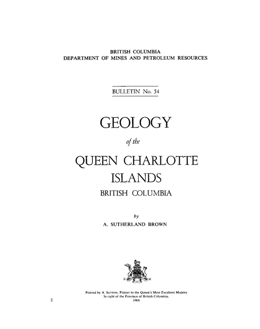
A. Sutherland Brown
Bulletin 54 discusses the geology and mineral deposits and considers the exploration potential of the Queen Charlotte Islands, which are at the western edge of the continental shelf seaward of central British Columbia. The islands have a land area of about 3,840 square miles, which is divided into three main physiographic units: the Queen Charlotte Ranges on the southwest, Skidegate Plateau in the centre, and Queen Charlotte Lowlands on the northeast. In the Pleistocene the islands were intensively glaciated.
The fundamental structural unit of the Queen Charlotte Islands is a thick (15,000+ feet) pillowed basalt of Late Triassic age. The basalts are separated by a flysch-like sequence of Latest Triassic and Early Jurassic age from an explosive porphyritic andesite of Middle Jurassic age and largely marine deposition. Two Cretaceous sedimentary units, the first flysch-like and the second mollasse-like, were deposited and are successively less involved in deformation. A final Early Tertiary period, largely of subaerial volcanism, deposited some 18,000 feet of intercalated columnar alkali basalt floods and sodic rhyolite ash flows. These are gently warped, eroded, and overlain by up to 6,000 feet of Mio-Pliocene sands and shales. Large lineal bodies of hornblende diorite to quartz diorite were emplaced in the Mid to Late Jurassic and a more varied sequence of quartz diorite to soda granite in the Early Tertiary, mostly along major lineal faults.
Crustal fracturing has been the dominant mechanism of deformation, controlling volcanism, sedimentation, intrusion, and secondary folding. Major north westerly lineal faults form a pattern related to the Queen Charlotte fault. The trace of the latter is along the continental slope. The major northwesterly faults have been active since at least the Early Cretaceous, and generally they combine right-hand wrench movement with normal east-block-down displacement.
The mineral resources of the islands are extensive. At present pyrometasomatic iron-copper deposits are the most important by several orders of magnitude but the potential for gold mineralization is high. Mineable reserves have a gross value of about $200 million. Production has come from two main properties-Tasu and Jedway.
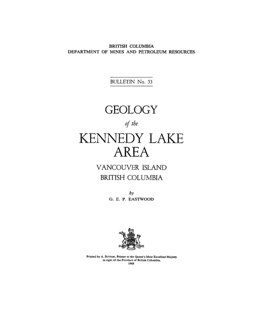
G.E.P. Eastwood
Bulletin 55 describes the geology of the Kennedy Lake area, Vancouver Island, British Columbia, which includes a land area of about 27 square miles around the main part of Kennedy Lake, on the west coast of Vancouver Island. It includes parts of the Estevan Coastal Plain and the Vancouver Island Mountains.
The northwest half of the area is largely underlain by andesite lavas of the Karmutsen Group, and the southeast half by batholithic intrusive rocks of intermediate composition. Sedimentary rocks of the Quatsino Formation and mainly pyroclastic rocks assigned to the Bonanza Group form a relatively narrow belt trending northeast through the middle of the area, largely separating the Karmutsen and batholithic rocks. A roof pendant or large inclusion of the Quatsino sedimentary rocks occurs in the batholithic rocks in the eastern part of the area, and is host to the magnetite orebodies of Brynnor Mines Limited. Some Quatsino limestone is infolded in the Karmutsen lavas in the northwest part of the area.
The Quatsino Formation overlies the Karmutsen Group and underlies the Bonanza Group. In the Kennedy Lake area it comprises a lower Limestone member, at least 2,000 feet thick, a middle argillite member, 800 feet thick, and an upper limestone member, 350 feet thick. The contacts are gradational. The limestone members contain few impurities and are thick bedded to massive. The argillite is feldspathic and probably tuffaceous. It is thin bedded and commonly markedly banded by the alternation of beds of contrasting colour. The formation is of Upper Triassic age.
The sedimentary and volcanic rocks have been successively intruded by andesite, an Older Porphyry, the batholithic rocks, a Younger Porphyry, and basalt and gabbro. With the exception of the batholithic rocks, these rocks occur mostly as narrow dykes and sills; a few small stocks of andesite, Older Porphyry, and gabbro are present. The andesite is particularly common in the lower limestone. The batholithic rocks include diorite and tonalites, which appear to be contemporaneous, and granodiorite-quartz monzonite, which intrudes the diorite. A minor part of the diorite, and possibly part of the mafic tonalite, apparently resulted from recrystallization and metasomatism of andesite, but most of the batholithic rocks were evidently intruded as magma. A potassium-argon date of 167 million years was obtained from the granodiorite. The diorite and tonalites are older by from a few thousand to a few million years . A potassium-argon date of 121 million years was obtained from a dyke of Younger Porphyry.
The sedimentary and volcanic rocks were folded about northeast- to north-trending axes. The best-defined folds are a syncline through Salmonberry Mountain, just south of Kennedy Lake, and an anticline in the pendant of Quatsino rocks in the east part of the area. For the most part, these folds plunge gently southwest, but at the mine the anticline is buckled sharply downward and backward. This down-buckle is probably a later structure superimposed on the primary folding.
The rocks have been broken by many faults of small displacement, and by several with displacements measurable in miles or fractions of a mile. The largest strikes north along the foot of Salmonberry Mountain and displaces the Karmutsen-Quatsino contact between 1 and 2 miles to the left. It appears to branch under Kennedy Lake, and to the south it curves away to the southwest. Almost all the displacement took place prior to batholithic intrusion, although granodiorite has been sheared adjacent to the fault by renewed movement. Lesser faults have offset the Salmonberry Mountain syncline and truncated an infold of limestone west of the lake. A fault in the open pit appears to have displaced the limestone-argillite contact about 200 feet.
The only economic mineral in the area is magnetite, and of seven occurrences described, only the Brynnor mine deposit is commercially significant. It comprises two irregular orebodies that more or less follow the down-buckled faulted contact between the lower limestone and the argillite. The upper orebody, west of the fault, has been mined by open-pit methods. The lower orebody, east of the fault, was partly developed for underground mining before the project was abandoned.
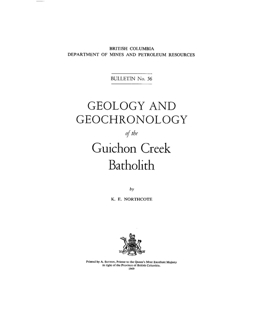
K.E. Northcote
Bulletin 56 describes the geology and geochronology of the Guichon Creek area. Mapping is done at the one inch to two mile scale (1:126 720).
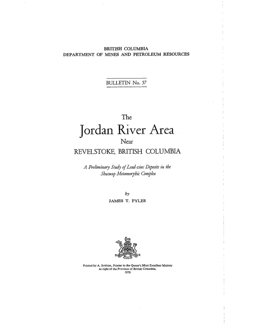
J.T. Fyles
Bulletin 57 describes the structure and lithology of rocks associated with conformable lead-zinc deposits in the Shuswap Metamorphic Complex northwest of Revelstoke, British Columbia. This type of deposit contains large reserves of lead and zinc, but, to date, none of the deposits has been mined. The most important properties include the Big Ledge northwest of Nakusp, the Wigwam 20 miles southeast of Revelstoke, the Cottonbelt 30 miles northwest of Revelstoke, the Ruddock Creek property 60 miles north of Revelstoke, and the King Fissure in the Jordan River area. The Jordan River area is about 15 miles northwest of Revelstoke on the southeastern flank of the Frenchman Cap gneiss dome.
Rocks within the area include quartzite, mica schist, quartz-feldspar, and calc-silicate gneiss, and minor amounts of marble in the amphibolite facies of regional metamorphism. The lithological succession is given in Table I, page 14. Nepheline-syenite gneiss and syenite gneiss form concordant layers within calcsilicate gneiss. Granitic gneiss intrudes the metasedimentary rocks and undeformed lamprophyre dykes follow a system of northerly trending fractures.
Granitic gneiss of uncertain origin forming the core of the Frenchman Cap dome occurs along the northern edge of the area. Schist, quartzite and paragneiss lie above the granitic gneiss, and these metasedimentary rocks contain the lead-zinc deposits.
Rocks of the Jordan River area are complexly folded. Three phases of deformation are recognized. The oldest or Phase 1 folds are isoclinal, recumbent, similar folds with warped axial planes and axes which plunge at various angles dominantly to the southwest, west, and east. Phase 2 folds are overturned with axial planes dipping southwest and south.
The style and plunge of the folds varies in relation to the position of the folds on the curving flank of the Frenchman Cap dome. A broad curvature of the foliation around the southeastern corner of the dome is referred to as a Phase 3 fold. The lead-zinc layer and the nepheline-syenite gneiss have been deformed by all three phases of folding.
The lead-zinc sulphide layer occurs in a group of rocks known as the lead-zinc sequence, which consists of a quartzitic part lying structurally beneath a calcareous part. The calcareous part contains mica schist, calcareous mica schist, calc-silicate gneiss, and at least three distinct layers of marble, each a few feet thick. The sulphide layer is a few tens of feet from the quartzitic part of the sequence. It is very closely confined stratigraphically; it ranges from less than an inch to 25 feet thick but is normally less than 10 feet thick. It consists of fine-grained pyrrhotite, sphalerite, galena, and pyrite with lenses of quartz and locally barite and marble in a calc-silicate gneiss.
The sulphide layer occurs on the King Fissure property where reserves arc estimated to be more than 3 million tons having an average grade of approximately 1 ounce per ton silver, 5 per cent lead, and 5 per cent zinc. The layer is also present on the eastern slope of Frisby Ridge, where it is less than 1 foot thick.
Molybdenite associated with syenite gneiss and syenite pegmatite is found near the margins of a mass of nepheline-syenite gneiss west of the King Fissure property. This molybdenite is currently being mined.
The Ruddock Creek area, 60 miles north of Revelstoke, is on the northwestern flank of the Frenchman Cap dome. Rocks in the area are mica schist, sillimanite, and calc-silicate schist and gneiss with intercalated layers of marble. These rocks form highly folded discontinuous layers and lenses engulfed in granite-pegmatite.
The dominant folds in The Ruddock Creek area plunge 20 to 30 degrees to the west and are of two ages. The later or Phase 2 folds are recumbent, having rounded hinges and a modified concentric style varying from sub-isoclinal in the east to relatively open in the west. One older, or Phase I fold, has been mapped with axis almost parallel to the axes of the Phase 2 folds. This fold described as a syncline is shown diagrammatically on Figure 8, page 49.
The sulphide member on the Ruddock Creek property consists of calcsilicate gneiss, quartzite, marble, and sulphides, and ranges from 5 to 15 feet thick without structural repetitions. At the main (E) showing it is repeated by folding and is more than twice this thickness. The sulphide layers contain sphalerite, pyrrhotite, galena, pyrite, and minor chalcopyrite with quartz, calcite, and locally barite and fluorite. Much of the sulphide layer is very fine grained and contains rounded knots of quartz. Other mineralization is medium grained and massive. The deposit is estimated to contain several million tons of material grading approximately 10 percent combined lead and zinc and less than 1 ounce per ton silver.
The conformable lead-zinc deposits in the Shuswap Metamorphic Complex have several parallel and some contrasting features. They are closely confined stratigraphically, but are not in the same lithological succession and probably not in the same time-stratigraphic unit. The mineralogy, textures of the sulphides, and mineral associations are similar at all the deposits. All the deposits have been deformed and metamorphosed. Locally they are replaced by pegmatite.
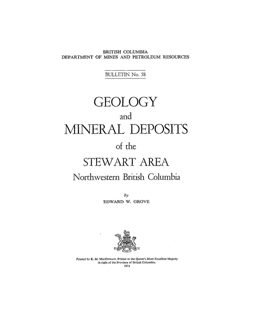
E.W. Grove
Bulletin 58 describes the Stewart map area, one of the major metal-mining districts in western Canada, which is located 100 miles north of Prince Rupert, and covers an area of about 220 square miles in the Boundary Ranges in northwestern British Columbia. It lies within a terrain of Mesozoic rocks across the contact between plutonic rocks of the Coast Crystalline Belt and the west-central portion of the Bowser Basin. The purpose of this study was to determine the lithological and structural relationships of these rocks to the younger mineral deposits and to obtain background information essential to the study of the Stewart Complex.
The oldest Mesozoic rocks in the district are non-marine Hazelton volcanic epiclastics and sedimentary strata that constitute part of a thick-layered Lower Jurassic succession. This succession is overlain by predominantly marine sedimentary Bowser strata of Middle to Upper Jurassic age. The two assemblages are separated by lower Bowser rhyolite flows, limestones, littoral materials, and red beds that mark the onset of basin subsidence and rapid, dominantly marine sedimentation.
A variety of intrusive rocks comprising part of the Coast Crystalline Belt cut all the layered rocks of the district. Individual plutons range in composition from augite diorite to quartz monzonite and in size from discrete dykes and stocks to extensive batholiths. Plutons of the Coast Crystalline Belt have been shown to represent at least two episodes of intrusion in the Stewart area. One is represented by the Mesozoic Texas Creek granodiorite and the second by the Tertiary Ryder quartz monzonite. The dyke swarms, which have been divided into four textural and compositional groups, represent the latest phases of igneous activity in the area.
The Mesozoic rocks are folded along arcuate northerly trending nearly horizontal axes. The major fold involving Hazelton rocks is an upright, broad anticline upon which Bowser rocks are preserved as structural remnants. The major fold in the Bowser rocks is an upright, canoe-shaped syncline that bisects the map area. The majority of minor folds and the cogenetic lineations in the Hazelton rocks are nearly at right angles to the major structure. Minor folds in the Bowser rocks include styles varying from simple to complex or confused, which express deformation resulting from gravity sliding and from extensive igneous intrusion.
Cataclasites form extensive northerly trending zones cutting Hazelton volcanic epiclastics. The major Cascade Creek zone has been intruded and altered by igneous material and extensively mineralized. Numerous extensive fractures which cut all the country rocks and major structures have been grouped into four major systems along which most of the known vein deposits have been localized. The mechanical competency of the lithologic units has been examined in terms of structural studies and certain volcanic conglomerates have been shown most favourable to deformation, alteration, and mineralization.
More than 50 properties in the Stewart district produced in excess of 5.6 million tons of gold-silver-lead-zinc ore between 1910 and 1968. Of this total the Silbak Premier mine alone produced over 4.7 million tons and paid in excess of $21 million in dividends. In addition there are at least 100 more known mineral deposits that have not been mined.
The mineral deposits are mainly simple quartz-breccia veins and transitional vein-replacement systems, which contain irregular lenses and shoots of sulphide mineralization. The primary sulphide minerals are pyrite, galena, and sphalerite, with accessory gold and silver minerals. Native silver, electrum, and gold are locally important and contributed significantly to mine production. The veins and vein systems form three well-defined groups related to well-defined fracture systems in both Hazelton and Bowser rocks.
Wallrock alteration related to the mineral deposits includes simple silicification, carbonatization, and pyritization, as well as examples of propylitization, hornblendization, and potassium feldspar alteration. Country rock alteration patterns are generally simple and relate to igneous intrusion and low-grade deformation coupled with crystalloblastesis, as well as to the mechanical nature of the materials involved. Variable induration, silicification, pyritization, hornblendization, and potassium feldspar alteration are common contact and shear-zone effects. Evidence for regional metamorphism is slight and consists of rare, sporadic fine-grained andalusite developed in certain Bowser siltstone units, as well as extensive medium-grained hornblende developed in Hazelton volcanic conglomerates spatially unrelated to known or visible plutons. This suggests a lower amphibolite facies environment but may imply selective metasomatism.
This study of the Stewart area has revealed in part the complex interplay between elements of the Coast Crystalline Belt and the Bowser Basin and the relationship of mineral deposits to specific structural and lithological situations in that environment.
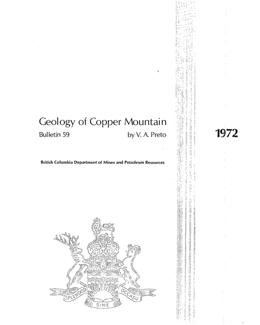
V.A. Preto
Bulletin 59 describes the geology of a 50-square-mile area centered on Copper Mountain, 10 miles south of Princeton, British Columbia.
Particular attention is paid to the structure, stratigraphy, and alteration of volcanic and sedimentary rocks of the Nicola Group, to the Copper Mountain intrusions, which cut them, and to the setting of copper deposits in this environment.
Nicola Group rocks consist of a volcanic succession that includes massive flow units, coarse to very fine-grained pyroclastic units and some pillow lava, and of a sedimentary succession that includes siltstone, argillite, conglomerate, and some reefoid limestone. The volcanic rocks are generally andesite to basaltic andesite in composition. Their age, as indicated by fossils, is Upper Triassic.
The Copper Mountain intrusions cut the Nicola rocks and consist of a series of differentiated quartz-poor calc-alkalic rocks that range in composition from pyroxenite to syenite. These intrusions include the Copper Mountain, Smelter Lake, and Voigt stocks and the Lost Horse intrusions, and have been dated radiometrically at 193±6 million years.
Copper deposits are found near Copper Mountain in a narrow belt of strongly altered and fractured Nicola rocks that is bounded on the south by the Copper Mountain stock and on the north by the Lost Horse intrusions. Mineralization is controlled by faulting and fracturing, suitable alteration, and, in most cases, by the proximity of rocks of the Lost Horse intrusions, which appear to have been the immediate source of hydrothermal and mineralizing fluids. The copper deposits are regarded by some as being pyrometasomatic, and by others as being partly skarns (Ingerbelle) and partly complex porphyry copper gold deposits (Copper Mountain). Typical rock alteration includes an early development of biotite followed by extensive albite-epidote replacement and later veining by potash feldspar and scapolite.
Post-mineral intrusions include a quartz monzonite mass that has been radiometrically dated at 99.5±4 million years and a later swarm of northerly trending felsitic dykes.
Middle Eocene sedimentary, volcanic, and intrusive rocks of the Princeton Group unconformably overlie and cut all the previously mentioned rock units.
Deformation in the area consisted of mostly broad northerly to northwesterly trending folds, and intense faulting. At Copper Mountain faults may be separated into distinct sets which, in order of decreasing relative age, trend east-west, northwest, and northeast. Later northerly trending normal faults dissected the area and divided it into two distinct blocks, the western of which has been downdropped and appears to be devoid of intrusive rocks of the Copper Mountain type at the present level of erosion.
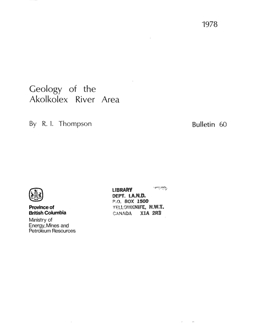
R.I. Thompson
Bulletin 60 reports the structural history and exploration potential for lead-zinc-silver mineral deposit in the Akolkolex River area, which encompasses approximately 200 square miles on the western margin of the Selkirk Mountains of British Columbia. It forms the northwestern limit of the Kootenay Arc, a narrow arcuate belt of severely deformed sedimentary and volcanic rocks, and is part of the structural-metamorphic transition between the Shuswap Metamorphic Complex to the west and the Selkirk Mountain Fold and Thrust Belt to the east.
Two structural levels are evident in the Akolkolex River area. They are separated by the Standfast Creek fault, a low-angle fault that cuts obliquely upward through the stratigraphic succession from southwest to northeast. The upper structural level contains quartzite, calcareous phyllite, limestone, and carbonaceous phyllite and argillite of Early Paleozoic age that can be regionally correlated with the Hamill Group, Mohican Formation, Badshot Formation, and Index Formation of the Lardeau Group respectively. This succession has been deformed into a pair of large recumbent folds: the Akolkolex anticline and the Drimmie Creek syncline. These nappe-like structures have an amplitude approaching 4 miles, have a relatively constant interlimb thickness of 2,500 feet or less, and occupy approximately 40 per cent of the area mapped. They are nearly cylindrical in form and plunge gently in a southeasterly direction. The lower structural level contains quartzite and pelitic schist, which appear to be part of the Hamill Group and possibly part of the Horsethief Creek Group of Hadrynian age.
Individual structures are difficult to define due to the lack of distinctive stratigraphic markers; however, a large recumbent fold, like that in the upper structural level, is inferred from structural and stratigraphic data. Granodioritic gneiss , which forms a nearly conformable subhorizontal limit to the stratigraphic succession established in the map area, contains local tightly appressed infolds of the overlying metasedimentary rocks.
Folds are cylindrical throughout the map area, and a statistical analysis of the orientation of fold axes shows a pervasive southwesterly trend and low plunge which changes progressively to a west-northwesterly trend in the northwestern part of the area. Although the map area is on the southern flank of the Clachnacudainn salient, a domal culmination of high regional metamorphic grade, fold orientation, and style appear little influenced by it.
Metamorphic grade increases from chlorite-bearing phyllites in the upper structural level, to staurolite and kyanite-bearing schists close to the gneiss. A large temperature interval at pressures above the alumino-silicate triple point is indicated. Synkinematic metamorphic textures are present throughout much of the lower structural level.
Lead-zinc mineralization in the area is restricted to the thickened hinge zone of the Drimmie Creek syncline. Most mineral showings are on the Wigwam property, located on the north slope of the Akolkolex River. Pyrrhotite, pyrite, galena, and dark brown sphalerite occur as lenses in close association with fine-grained silicified zones within the limestone. Severe folding and local attenuation obscure definition of the lateral extent of the sulphide mineralization.
The main structures of the Akolkolex River area appear to be the result of vertical shortening and horizontal extension, like those in the Shuswap Complex, and are in contrast with the upright folding and high-angle faulting of the Selkirk Mountains and Kootenay Arc; however, the grade of regional metamorphism is typical of that in the Selkirk Mountains. Deformation at a deeper structural level may account for the contrast in structural style with adjacent areas to the east and south.
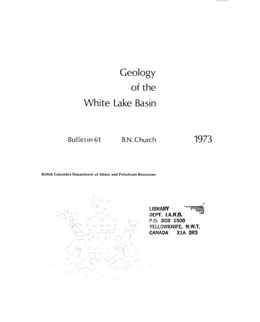
B.N. Church
Bulletin 61 describes the volcanic geology of the White Lake basin. The object of this study was to establish the stratigraphy, structure, and petrology of Early Tertiary rocks in the White Lake area near Penticton, British Columbia.
This was achieved by field mapping and laboratory work performed mainly as a thesis study for the Department of Geology, University of British Columbia.
Early Tertiary rocks of the White Lake area consist of five main stratigraphic subdivisions, which are from the base as follows:
- discontinuous beds of basal breccia and conglomerate,
- a thick and widely distributed succession of volcanic rocks of diverse composition - mainly phonolite, trachyte, and andesite lavas,
- discontinuous volcanic beds - mainly rhyodacite lava,
- locally thick volcanic sandstone and conglomerate beds interdigitated with lahar and pyroclastic deposits,
- local deposits of slide breccia and some volcanic rock overlain by fanglomerate beds.
The maximum aggregate thickness of the sequence is about 12,000 feet, and it is all believed to be of Eocene age. Each subdivision rests with some angular or erosional unconformity on older rock. The preservation of the sequence from erosion is partially explained by regional downfaulting. The greatest downward movement is near the Okanagan Valley where it is estimated that basal beds locally exceed depths of 5,000 feet below mean sea level. In general, beds are tilted easterly as if rotated downward forming a trap-door-like structure. Locally, folds are developed but these are without regional pattern and may be the result of simple flexures in the basement rocks.
Petrographic and chemical data indicate a three-fold division of igneous rocks: 'A' series - mainly plagioclase porphyries; lavas of rhyodacite and andesite composition. 'B' series - mainly two-feldspar porphyries with co-existing plagioclase and sanidine; lavas of trachyte and trachyandesite composition. 'C' series - mainly anorthoclase porphyries; lavas of phonolite composition and some tephrite. Phase diagrams and subtraction plots indicate that 'A' and 'C' series rocks were probably formed by crystal fractionation. In the case of 'A' series, precipitation of mainly plagioclase and pyroxene from andesite produces rhyolite; and for 'C' series, precipitation of mainly pyroxene and some biotite from tephrite produces phonolite. Rocks of 'B' series are intermediate in composition to 'A' and 'C' and were probably formed by mixing of magmas.
The Dusty Mac gold-silver prospect is the main mineral deposit in the area. A detailed investigation shows that mineralization of the White Lake Formation near Okanagan Falls accompanied a pulse of silicification prior to a period of movement and brecciation on faults and shear zones.
Study of the volcanic rocks of the White Lake Basin leads to consideration of general problems of classification of volcanic rocks, particularly fine-grained rocks, and hence a new classification scheme is presented.
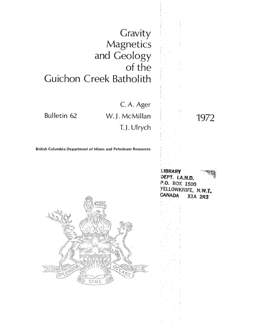
C.A. Ager, W.J. McMillan and T.J. Ulrych
Bulletin 62 summarizes the results of a detailed gravity survey of the metal-rich Guichon Creek batholith in south central British Columbia. Gravity measurements were taken at half mile intervals along three lines across the batholith. Elevation control was provided by triple leveling the lines. Density terms used in the interpretation were derived from nearly 1500 specific gravity measurements made on rock samples collected throughout the batholith. From the data, the three dimensional geometry of the batholith was interpreted.
Gravity anomalies are located at the coordinates of the observation station. They are not reduced to any datum, but have been corrected for effects down to a datum. It is therefore clear that the anomaly values are located on an irregular surface, and any mathematical treatment of the data must consider this point. This is of special importance in mountainous regions.
The use of linear filter operators on potential fields greatly enhances the interpretation of the data and provides a useful means of anomaly separation. This is most clearly evident on the filtered magnetic map where regional magnetic features are highly resolved.
Another use of filtering is to define the second vertical derivative gravity map from which the configuration of the boundary of the source may be inferred. In particular, the second derivative map suggests that the batholith terminates with a vertical contact to the north, where it underlies the Kamloops volcanic rocks.
On the basis of the gravity and density data, only two subdivisions of the batholith can be made:
- The Hybrid phase and country rock, and
- The Highland Valley, Bethlehem, and Bethsaida phases.
An estimate of the average depth of the Tertiary Kamloops volcanic rocks overlying the north edge of the batholith was made from the regional ?g map. Using ? = 2.60 gm/cm3, a depth of 1.0 kilometre was determined.
Interpretation of the gravity data led to a density model for the batholith. Its gross shape can be likened to that of a flattened funnel-like structure. The axis of symmetry for the model is tilted about 10 degrees from the vertical and plunges in an east-northeast direction. The maximum depth of the central core is more than 12 kilometres.
Probably the most important result of this study in terms of mineral exploration is the striking correlation between the locations of large-scale porphyry copper-molybdenum deposits, such as the Highmont, JA, Lornex and Valley Copper deposits, and the surface projection of the interpreted root zone of the batholith.
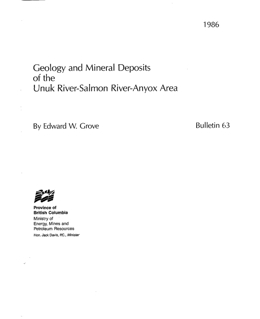
E.W. Grove, 1986 (reprint)
Bulletin 63 represents new data on the geology of the Unuk River-Salmon River-Anyox region, much of which is relevant to the tectonic evolution of the Western Cordillera and to the concepts of metallogenesis in northwestern British Columbia. The study area includes part of the contact of the eastern Coast Plutonic Complex with the west-central margin of the successor Bowser Basin. Sedimentary, volcanic, and metamorphic rocks bordering the Coast Plutonic Complex range in age from Paleozoic to Quaternary. Geologically, geographically, and economically the country rocks of the area form a well-defined entity that the writer has called the Stewart Complex. Mineral exploration in the area is for vein, massive sulphide and porphyry deposits. The most important metals sought are gold, silver, lead, zinc, copper and molybdenum.
Several distinct periods of metamorphism, plutonism, volcanism, and sedimentation marked by deformation and erosion have been identified. The intensity of deformation has apparently decreased since the mid-Triassic Tahltanian orogeny although plutonism has increased in activity since the Triassic and reached a climax in the Tertiary along the eastern margin of the Coast Plutonic Complex. Neogene volcanic activity marked by alkali olivine basalt flows has occurred periodically along major north-south, northeasterly, and east-west fractures.
Within this orogenic cycle metallogenesis is related to volcanic, sedimentary, and plutonic processes during each major tectonic phase, and these processes have combined to produce broad mineral zoning and a large array of mineral deposits that characterize this portion of the Western Cordillera. The numerous fissure vein and replacement vein deposits in the Stewart Complex, including the Silbak Premier mine, comprise a common group of simple ore and gangue minerals. The major massive sulphide deposits include the Granduc property at Granduc Mountain, and the Hidden Creek, Double Ed, Redwing, and Bonanza properties at Anyox. Porphyry deposits include the molybdenum deposit at Kitsault and the copper-molybdenum property at the Mitchell-Sulphurets Creeks.
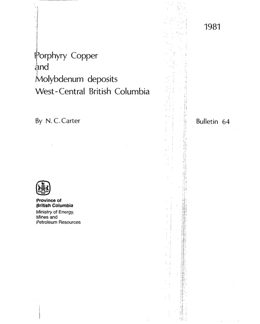
N.C. Carter
Bulletin 64 describes porphyry copper and molybdenum deposits in west-central British Columbia that are associated with plutons of Late Cretaceous and Tertiary age that intrude Mesozoic volcanic and sedimentary rocks of the Intermontane Tectonic Belt. The porphyry deposits are contained in an area bounded on the west by granitic rocks of the Coast Plutonic Complex, and on the east and southeast by a belt containing Mesozoic granitic stocks and an extensive area of Tertiary volcanic rocks.
The porphyry intrusions take the form of small stocks, plugs, dykes, and dyke swarms generally not exceeding one square mile in surface area. The intrusions are commonly multiple and range in composition from quartz diorite to granite. Copper and molybdenum sulphides occur as fracture fillings and as veinlet stockworks within and adjacent to the intrusive bodies. Sulphide and alteration minerals exhibit concentric zoning patterns. Volcanic and sedimentary rocks marginal to the intrusions are thermally metamorphosed to biotite hornfels. These intrusive contacts, mineralized fractures, alteration patterns and contact metamorphism provide important mineral exploration guidelines.
Results of potassium-argon dating indicate four crudely parallel north to northwest-trending belts of porphyry intrusions, each being distinctive in age, rock composition, and contained metallic mineralization. From west to east these include: (1) Alice Arm intrusions - 50 m.y. molybdenum-bearing quartz monzonite and granite intrusions; (2) Bulkley intrusions - 70 to 84 m.y. copper-molybdenum and molybdenum-bearing porphyries of granodiorite to quartz monzonite composition; (3) Nanika intrusions - 50 m.y. copper-molybdenum and molybdenum-bearing intrusions of quartz monzonite composition; (4) Babine intrusions - 50 m.y. copper-bearing intrusions of quartz diorite and granodiorite composition.
Potassium-argon analyses were carried out mainly on biotite separates from the mineralized porphyry phases within the deposits. Dating of intermineral and postmineral porphyry phases, common at many of the deposits, yielded ages equivalent to, or 2 to 3 m.y. younger than, the mineralized phases, indicating that the age of mineralization is essentially synchronous with the age of intrusion. Limits of analytical errors in these potassium-argon analyses are within 3 per cent of the calculated ages.
The distribution of potassium-argon ages for porphyry deposits in west-central British Columbia does not fit well the plate tectonic theories proposed for the origin of similar deposits elsewhere in the Cordillera of North and South America, in which deposits are progressively younger in a given direction. Here, four crudely parallel belts of porphyry intrusions display a reversal in age from 50 m.y. to 70-64 m.y. to 50 m.y. in an eastward direction. This distribution of ages may have been caused by periodic movement from Late Jurassic to Tertiary time along a subduction zone beneath the Coast Plutonic Complex that forms the west border of the area containing the porphyry deposits.
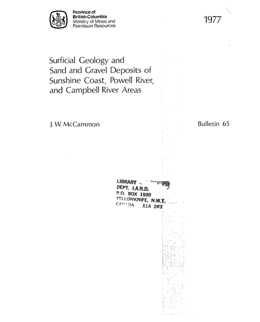
J.W. McCammon
Due to the decline in available supplies of sand and gravel in the Vancouver area and increasing demand, recently there has been considerable interest in possible new sources of these materials. The Geological Survey of Canada has published various maps and bulletins that provide information on much of the Georgia Strait region but not for the Sunshine Coast from Howe Sound to Lund not for the area north of Campbell River. Accordingly, a program to map these areas was initiated in 1974 and completed in 1975. The results of the survey are presented in this bulletin in three sections: Sunshine Coast area, Powell River area, and Campbell River area.
In the Sunshine coast area, the survey reviewed only the area below 300 metres elevation. Unconsolidated materials are of glacial, glaciomarine, marine and fluvial origin. Postglacial sea level was at least 180 metres above the present level. Of the 35 gravel pits examined, one is in glaciofluvial material, six are in pre-Vachon beds and the rest are in Capilano fluvial sands and gravels. The survey indicates that most of the gravel sources in this area are being exploited. The major undeveloped source is the delta complex at the mouth of Chapman Creek.
In the Powell River area, the same survey strategy was followed. A variety of unconsolidated materials left by glaciers, streams and the sea mantle the area. Most pits in the area are small. In the 38 examined, sand is more abundant than gravel. In the east, the aggregates are in Capilano fluvial deposits, in the west they are in pre-Vachon materials. It is unlikely that large undiscovered deposits occur in the area surveyed; good gravel deposits are scarce but sand is abundant.
In the Campbell River area, the survey area is within the Nanaimo Lowland. The highest point of land is at 319 metres. Glaciers moved southeast and left a mixed variety of debris, normally till above 189 metres elevation. Below 180 metres, the ground is covered with unconsolidated glacial, glaciomarine, marine and fluvial deposits. The study examined 35 pits. Twelve of these, including the largest, are in the large glaciofluvial delta east of McIvor Lake. The largest apparent concentration of gravel in the area surveyed is in the glaciofluvial delta across the east end of Campbell Lake.
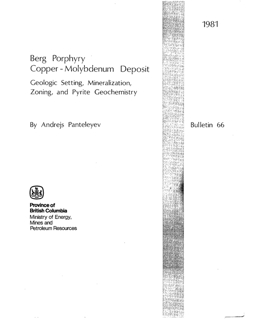
A. Panteleyev
Bulletin 66 describes the geologic setting, mineralization, zoning, and pyrite geochemistry of the Berg porphyry copper-molybdenum deposit, which is in mountainous terrain of the Tahtsa Ranges in west-central British Columbia. Of the major porphyry copper-molybdenum prospects discovered in the Canadian Cordillera (see Sutherland Brown, 1976) it is the one that possibly most closely resembles the idealized porphyry copper model of Lowell and Guilbert (1970). The deposit is found in thermally metamorphosed and hydrothermally altered Jurassic Hazelton volcanic rocks and Tertiary quartz diorite adjacent to a weakly mineralized Eocene stock. The stock is about 640 metres in diameter and consists of four quartz monzonitic phases. A major intrusive breccia body is associated with the stock. Weakly mineralized volcanic rocks and barren sedimentary strata of the Lower Cretaceous Skeena Group crop out east of the deposit.
These are overlain to the north by rocks of the Upper Cretaceous Kasalka Group. Hydrothermal alteration and sulphide minerals are arranged in concentric, annular zones around the composite stock. From the interior outward pervasive alteration zones are potassic, phyllic, biotitic and propylitic. Argillic alteration is rare. The biotitic zone surrounding the stock is a thermal aureole (biotite hornfels) that has been enhanced by an overlapping hydrothermal biotite overprint. A multistage vein stockwork is superimposed on the pervasively altered rocks. Early veins, both with and without alteration envelopes, were deposited from saline fluids at temperatures in excess of 400 degrees Celsius. Later veins were deposited from cooler, less saline fluids and commonly have retrograde alteration envelopes or bleached margins. A gypsum-filled subhorizontal fracture cleavage cuts all alteration minerals and veins. The molybdenite zone (>0.05 per cent MoS2) closely follows the intrusive contact where quartz stockworks are well developed. Chalcopyrite is most abundant outside the stock in the zone of biotitic alteration. Pyrite is concentrated 200 to 300 metres from the intrusive contact but is abundant throughout a broad halo that extends outward from the stock for at least 600 metres. Leaching and supergene mineralization cause pronounced vertical zoning in the deposit. In the leached capping copper has been removed to a depth of 36 metres but molybdenum remains and is locally concentrated in limonite. In the supergene zone, which overlies the entire deposit and is as much as 91 metres in thickness, copper is enriched by a factor of 1.25 over primary grade. Supergene mineralization is a contemporary ongoing process that was initiated after Pleistocene glaciation. Minor elements in pyrite are concentrated in disseminated pyrite from the zone of best copper mineralization.
Pyrite from all veins, including early molybdenum-bearing veins, has less minor element concentration. This bimodal distribution can be demonstrated by univariate and bivariate statistical analyses and implies a different origin for vein as opposed to disseminated pyrites. Zoning patterns of minor elements in disseminated pyrite are similar to alteration and sulphide zoning around the composite stock. Q-mode factor analysis duplicates individual element zoning patterns and, more significantly, accentuates the well-mineralized zone.
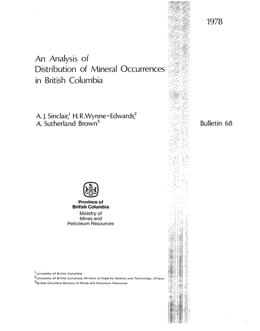
A.J. Sinclair, H.R. Wynne-Edwards and A. Sutherland Brown
Bulletin 68 deals with distribution of mineral occurrences in British Columbia recorded in an extensive computerized file. The data are displayed graphically and treated statistically and analytically. The authors then discuss, in a tentative way, the meaning of the data to them. The Bulletin includes in its appendices a series of computer-generated maps and an
output of all occurrences used as a basis for the maps by commodities and National Topographic System sheet number.
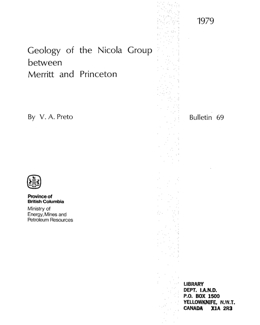
V.A. Preto
Bulletin 69 outlines the geology of the central part of the Upper Triassic Nicola Group between Nicola Lake and Princeton. The study area covers approximately 650 square kilometres and extends from latitude 49 032' 00" north to 50 007' 30" north and from longitude 120 030’ 00’’ west to 120 041’00’’ west.
Within this area the Nicola Group consists of three north-trending structural belts bounded by major faults and including rock units of varied lithology but similar composition and mode of origin. The rocks have exploration potential for vein, porphyry and skarn deposits.
The Central Belt, exemplified by subaerial and submarine assemblages in the Aspen Grove area, comprises extensive pyroxene and plagioclase-rich andesitic and basaltic flows, breccia, conglomerate, and lahar deposits. Comagmatic intrusive rocks are mostly diorite with subordinate syenite.
The Eastern Belt consists of submarine volcanic sedimentary rocks in the north but is dominated in the south by extensive lahar deposits, some basaltic flows, and high-level syenitic stocks.
The Western Belt consists of flow and pyroclastic rocks ranging in composition from andesite to rhyolite and interbedded with limestone, volcanic conglomerate, and sandstone which contain marine fossils of Lower and Middle Norian age.
Central and Eastern Belt rocks include both alkalic and calc-alkalic suites, which were derived from comagmatic intrusions within these belts. Western Belt rocks, though mapped only in limited extent, appear to be distinctly calc-alkaline and derived from sources outside the study area.
Younger stratified rocks, ranging in age from Lower-Middle Jurassic to Recent, lie either in fault contact with Nicola strata or overlie them unconformably. The most conspicuous of these later suites is a succession of Lower Cretaceous intermediate to acid continental volcanic rocks with associated sedimentary and intrusive rocks, which correlates with the Kingsvale Group.
Most Nicola rocks are massive, non-foliated, and weakly metamorphosed. Metamorphic assemblages range from the quartz-prehnite subfacies of the prehnite-pumpellyite facies, locally transitional to greenschist facies, to rocks, which are barely altered. Analcite phenocrysts are still preserved in some trachybasalt flows.
The structure of the study area is dominated by two major fault systems: the Alleyne-Summers Creek system to the east and the Allison system to the west. These faults are interpreted to represent an ancient, long-lived rift system that determined the extent and distribution of Nicola rocks and along which basins of continental volcanism and sedimentation formed in Early Tertiary time.
Copper mineralization is widespread in Nicola rocks and all deposits of economic importance are considered to be related to these strata in their origin. Within the study area, the Central Belt is the richest in mineral occurrences, though appreciable mineralization is also found in the southern part of the Eastern Belt. Eleven groups of mineral occurrences and deposits, separated on the basis of mineralogy, host rocks, and mode of occurrence, are outlined in this report.
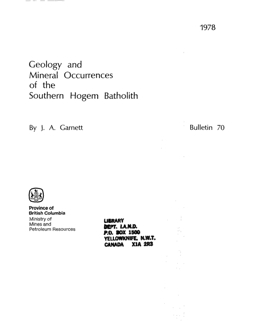
J.A. Garnett
Bulletin 70 describes the geology and mineral potential of the Hogem batholith, which is the largest intrusive body within the Swannell Ranges, a subdivision of the Omineca Mountains. The batholith is a Mesozoic intrusion located within the island arc environment of the Quesnel Trough. To the west, older, uplifted Cache Creek Group rocks are separated from this belt by the Pinch fault zone. To the east, the Manson fault zone separates this volcanic belt from the older, uplifted Wolverine Complex. The current structural setting of the Hogem batholith and the intruded Takla Group volcanic rocks is therefore best explained by vertical tectonics associated with graben development.
Detailed mapping in the southern section of the Hogem has documented a complex intrusive history spanning a much larger time interval than previously thought. It is a composite intrusion, containing three, and probably four, partial plutons with distinctive petrographic and chemical compositions.
Geochronologically, emplacement can be separated into three distinct phases. Phase I, chemically divided into the Hogem basic suite and the Hogem granodiorite, yields K/Ar dates within the limits 176 Ma to 212 Ma, and volumetrically represents the main intrusive event. The Phase II Duckling Creek and Chuchi syenite bodies yield K/Ar dates within the limits 162 Ma to 182 Ma and, although there is some age overlap with Phase I, are interpreted as distinctly younger on the basis of field observations. Phase Ill granite yields K/Ar dates within the limits 108 Ma to 126 Ma, and occurs as relatively small isolated bodies at four localities within the southern Hogem batholith.
The Phase I Hogem granodiorite and the Phase Ill granite fall within the calc-alkaline (sub-alkaline) petrogenic suite. The Phase I basic suite plots close to the alkaline/sub-alkaline boundary but is predominantly alkaline. The Phase II syenite falls well within the alkaline field.
The Hogem batholith has been subjected to considerable mineral exploration over this century, most recently during the period 1969-1975. Currently, there are no economically viable mineral deposits in the Hogem, although several interesting prospects have been developed. On the basis of field mapping, a clear relationship between the intrusive phases and certain types of mineralization has been established. Only minor pyrite/chalcopyrite/magnetite mineralization is associated with Phase I basic rocks, either as local disseminations or within volcanic contact aureoles adjacent to this phase. With the exception of local pyritized zones, the Phase I Hogem granodiorite is essentially barren of metallic mineralization.
Significant occurrences of copper (chalcopyrite, bornite, chalcocite, malachite, associated with magnetite and minor pyrite) are spatially associated with Phase II syenitic rocks and their related potash feldspar alteration zones. Such mineralization and alteration occurs where syenites intrude Phase basic intrusive or Takla volcanic rocks. The majority of known copper occurrences in the southern Hogem batholith are in the immediate vicinity of the Duckling Creek Syenite Complex. To a lesser extent, similar copper occurrences have been documented in and near the Chuchi syenite body to the south. Minor gold values are commonly associated with this mineralization.
Copper/molybdenum mineralization is spatially associated with Phase Ill granitic bodies. Chalcopyrite and/or molybdenite are associated with quartz flooding in altered, fractured zones near contacts and in and near aplitic and alaskitic dykes cutting both intrusive and volcanic rocks.
The best known ‘porphyry copper' mineralization within the Hogem is associated with Phase II syenites. However, the environment in which this occurs differs significantly from the major ore deposits in plutonic rocks of the alkaline porphyry suite elsewhere in British Columbia. The Hogem occurrences show little or none of the classic alteration, high level fault control, or porphyry dyke/breccia pipe development common elsewhere. There are no known volcanic equivalents to the Phase II syenites in the general vicinity of the southern Hogem batholith. The tentative conclusion of this study is that erosion has removed the contemporaneous, localized volcanic piles along with their characteristic subvolcanic copper mineralization. The existing syenitic copper occurrences represent lower level, primary intrusive remnants of such deposits. Since there are also no known volcanic equivalents to the Phase Ill granites, a similar history can be attributed to the existing copper/molybdenum mineralization associated with this calc-alkaline intrusive event.
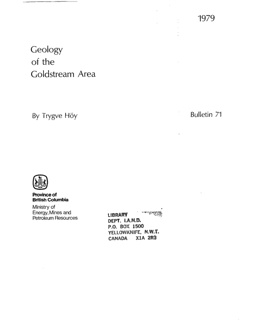
T. Höy
Bulletin 71 describes the geology and mineral deposits of the Goldstream area, which includes about 400 square kilometres of mountainous terrain in the northern Selkirk Mountains of southeastern British Columbia.
The geology of the area consists of intensely deformed Late Proterozoic/Early Paleozoic metasedimentary and metavolcanic rocks, which have been intruded by a number of granitic plutons. The metasedimentary and metavolcanic rocks comprise a heterogeneous package of quartzites, schists, phyllites, calc-schists, and carbonates, interlayered with greenstone and chloritic phyllite.
The greenstones and chloritic phyllites are metamorphosed equivalents of tholeiitic flows and basic tuffs. Derivatives of more acid volcanic rocks may now be preserved as quartz-sericite phyllite, quartz-augen phyllite, quartz-feldspar-sericite-chlorite phyllite, and perhaps some of the 'grit' unit.
The structure of the area is dominated by tight to isoclinal, north trending Phase 2 folds. These folds are interpreted to have developed in an initially inverted panel of rocks, which may be the underlimb of an earlier (Phase 1) nappe.
The most important mineral deposits of the area are stratabound copper-zinc deposits. They include Standard, in a basic volcanic pile, and Montgomery and Goldstream, contained in metasedimentary rocks.
Goldstream is a sheet of massive sulphides (dominated by pyrrhotite, sphalerite, and chalcopyrite) 3 to 4 metres thick, 500 metres wide, and at least 1 200 metres long. It occurs within a quartz-rich phyllite that is structurally overlain by a spessartine-chlorite phyllite and chert unit, which in turn is overlain by 220 metres of dark calcareous phyllite. The massive sulphide layer and quartz-rich phyllite are underlain by a grey limestone.
Massive sulphide deposits in the Goldstream area are similar to the 'bedded cupriferous iron sulphide' or 'Besshi' deposits. They are commonly bed-like in form, are composed primarily of iron sulphide/chalcopyrite ore, and occur in geosynclinal crystalline schists associated with basic submarine volcanism.
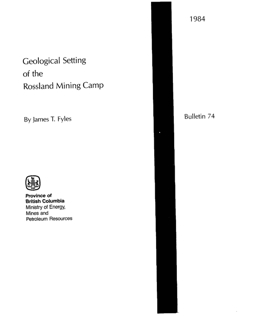
J.T. Fyles
Bulletin 74 summarizes geological work near the city of Rossland in the West Kootenay district of southeastern British Columbia carried out by the writer mainly between 1967 and 1970. The purpose of the work was to clarify the geological setting of the molybdenum deposits on Red Mountain.
In the Rossland area Upper Paleozoic and Lower Jurassic volcanic and sedimentary rocks are intruded by plutons of monzonite, granodiorite and syenite, and many dykes of related composition. The Carboniferous Mount Roberts Formation consists of grey siltstone, sandstone, conglomerate, and minor limestone. The Rossland Group is mainly andesitic volcanic breccia, sandstone and conglomerate, and lenses of grey to black siltstone. These rocks are folded, faulted, and variably metamorphosed and intruded by the Rossland monzonite, the Trail pluton of granodiorite, and the Coryell batholith of syenite.
The map-area contains two structural domains separated by an irregular line of intrusions and faults trending east-northeast and referred to as the Rossland break. The southern domain contains northeasterly trending structures whereas the northern domain, in which the major mineral deposits occur, contains northerly trending structures.
Two well-defined steeply dipping fracture sets occur throughout the area; one, referred to as the fault-dyke set, trending northward and the other; the vein set, trending eastward. The fault-dyke set consists of extension fractures containing Tertiary dykes with dominant fault movements down on the west. The vein set, which contains the copper-gold veins of the old Rossland camp, includes conjugate fracture sets dominated by attitudes of north 60 to 70 degrees east and north 60 degrees west with east-west fractures between these directions, all with steep northerly dips.
Three types of mineral deposits have been mined in the Rossland area: (1) copper-gold veins with minor lead and zinc, (2) gold veins, and (3) molybdenum deposits.
The copper-gold veins are composed of pyrrhotite and chalcopyrite in a gangue of more or less altered wallrock with local lenses of quartz and calcite. They formed by replacing wallrock along well-defined fractures and by filling fractures and fault zones. Between 1894 and 1941 a total of 5 600 000 tonnes of ore with an average grade of 13 grams gold per tonne, 17 grams silver per tonne, and 1 per cent copper was produced from these veins; there has been no production since.
The gold veins, which are discontinuously mineralized faults and fractures southwest of Rossland, contain small shoots of spectacularly high-grade gold mineralization. Between 1899 and 1974, 10492 tonnes of ore was produced from these veins with an average grade of 101 grams gold per tonne and 14 grams silver per tonne.
Molybdenum produced by Red Mountain Mines Limited between 1966 and 1972 amounted to 1 652 970 kilograms from almost a million tonnes of ore. The ore zones consist of molybdenite with very minor amounts of scheelite along fractures in a breccia complex composed mainly of hornfelsic siltstone. The mineralization was derived from the Trail pluton and associated dykes and apophyses. New age determinations based on a sample of zircon from the pluton 1.5 kilometres northeast of the mine give concordant uranium-lead dates of 159 and 162 Ma. Geological relationships, as well as potassium-argon dating of dykes, indicate that the copper-gold mineralization is younger than the molybdenum; at least in part it is Tertiary.
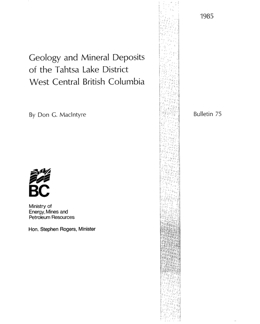
D.G. MacIntyre
Bulletin 75 describes the geology and mineral deposits in the vicinity of Tahtsa Lake, West Central British Columbia. The study area covers approximately 1 000 square kilometres and extends from latitude 53 degrees 30 minutes north to 53 degrees 52 minutes north and from longitude 127 degrees west to 127 degrees 30 minutes west. The study area is part of the Whitesail Lake map sheet (NTS 93E).
Within the map-area deformed andesitic volcanic and sedimentary rocks of the Early to Middle Jurassic Hazelton Group and successor basin deposits of the Late Jurassic and Early Cetaceous Bowser and Skeena Groups are unconformably overlain by continental volcanic rocks of Late Cretaceous age. These rocks constitute the Kasalka Group as defined in this study.
Kasalka Group rocks are preserved in a fault-bounded structural depression that is interpreted to be a cauldron subsidence complex of Late Cretaceous age. Within the area of subsidence, the Kasalka Group is over 1 000 metres thick and includes a lower felsic fragmental unit that is overlain by units of porphyritic andesite, lahar, and columnar jointed basalt. These units thin rapidly away from the area of subsidence and are succeeded to the north by younger rhyodacite flows.
Several small porphyritic andesite, microdiorite, dacite porphyry and rhyolite porphyry dykes, sills, plugs, and laccoliths are peripheral to and within the area of subsidence; these intrusions are interpreted to be comagmatic with the volcanism. Potassium argon isotopic age dating indicates that rocks of the Kasalka Group range in age from 105 to 87 Ma. Granitic intrusions are divisible into two age groups - 83 to 75 Ma and 58 to 49 Ma. All rocks are cut by late northwest-trending dyke swarms.
Granitic intrusions of Late Cretaceous and Tertiary age are unroofed outside the area of subsidence. Porphyry copper and molybdenum deposits are associated with porphyritic phases of these intrusions. Veins containing lead, zinc, and silver am also present. Berg, Huckleberry, and Ox Lake are the most economically significant deposits discovered to date.
This study suggests that emplacement of granitic intrusions and hydrothermal activity post-dated cauldron subsidence by several million years. However, ring and radial fractures generated during the early stages of subsidence may have controlled the location of later intrusive centres and their associated hydrothermal systems.
Bulletin 76-100
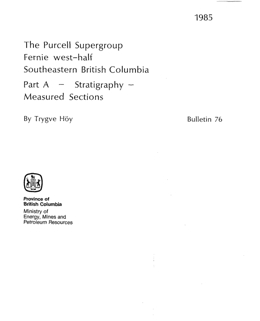
T. Höy
Bulletin 76, part A, focuses on measured sections through the Purcell Supergroup in the Fernie west-half map sheet (82G/W1/2), which straddles the Rocky Mountain Trench in southeastern British Columbia. The area is generally rugged, with the Purcell Mountains exposed in the western half of the sheet and the Kootenay Ranges of the Rocky Mountains in the eastern half. The Purcell Supergroup, a thick accumulation of dominantly clastic rocks of Helikian age, forms the core of the Purcell Mountains and is exposed in thrust sheets along the western edge of the Kootenay Ranges. Its base is not exposed. The Purcell Supergroup is onlapped unconformably by Hadrynian rocks at the north end of the Fernie map sheet, and by Cambrian or Devonian rocks in the southern half.
This report, Part A of Bulletin 76, includes 26 measured sections of the Purcell Supergroup, and one section of the overlying Cranbrook Formation. The location of the measured sections is shown on Figure 1 and their extent in the Table of Formations on Figure 2. Part B of Bulletin 78 comprises text, maps, and diagrams describing the stratigraphy, sedimentology, structure, and contained mineral deposits of the Purcell Supergroup in Fernie west half. It is scheduled for publication in 1988.
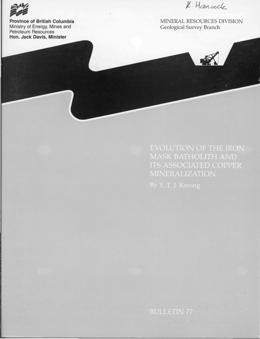
Y.T.J. Kwong
Bulletin 77 is a synthesis of studies completed on the Iron Mask batholith and the Afton deposit up to 1987. Emphasis is placed on geochemical and mineralogical aspects of the batholith and the copper-gold deposit, that shed light on their derivation and evolution. Through theoretical modelling with pertinent thermodynamic data, the unique suupergene alteration features of the Afton orebody are explained. Applications of the major findings of this study are briefly disucssed with respect to other copper +/- gold occurrences in the batholith.
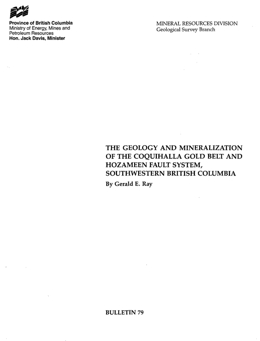
G.E. Ray
Bulletin 79 and the accompanying maps describe the geology, gold deposits, mineral occurrences and exploration criteria adjacent to the Hozameen fault system and Coquihalla serpentine belt in southwestern British Columbia. The map area covers 170 square kilometres within parts of the Hope (92R/6), Spuzzum (92H/l I) and Boston Bar (92H/l4) map sheets.
The northerly trending Hozameen fault is associated with both the Coquihalla serpentine and Coquihalla gold belts, and separates two distinct crustal units. East of the fault are greenstones of the Early Triassic (?) Spider Peak Formation, which forms a basement for the Jurassic to Middle Eocene turbidite and successor basin deposits of the Methow-Pasayten trough. The Jurassic Ladner Group, the oldest sedimentary rocks in the trough, unconformably overlies the Spider Peak Formation and contains a locally developed basal coarse clastic unit that hosts many of the mineral occurrences in the Coquihalla gold belt, including the Carolin deposit. Recently discovered Late Jurassic Buchia fossils in the Ladner Group succession suggest the group extends beyond its formerly accepted age of Early to Middle Jurassic. West of the Hozameen fault, the Permian to Jurassic Hozameen Group is interpreted as a highly deformed, dismembered ophiolite suite comprising ultramafic rocks of the Petch Creek serpentine belt at the base, stratigraphically overlain in turn by volcanic greenstone and chert units. Volcanic greenstones on either side of the Hozameen fault are geochemically distinguishable. Those in the Spider Peak Formation represent sodic, ocean-floor, subalkaline basalts probably formed in a spreading-ridge environment, while the volcanic rocks in the Hozameen Group include both arc tholeiites and oceanic island-seamount subalkaline basalts.
Farther west, the major, northerly trending and easterly dipping Petch Creek fault separates the Hozameen Group from the Custer-Skagit gneiss. This fault is associated with the lowest recognized stratigraphic section of the Hozameen Group the Petch Creek serpentine belt, and is believed to be a northern extension of the Ross Lake fault in Washington State.
The evolution of, and relationships between, the Hozameen Group, the Spider Peak Formation and the Methow-Pasayten trough are still controversial. One possibility is that they were all deposited within a single long-lived basin that evolved from a multi-rifted, marine back-arc basin into a narrow, nonmarine trough. Alternatively, it can be argued that the contrasting geochemical signatures of the volcanics in the Spider Peak Formation and the Hozameen Group suggest they were not closely associated prior to Middle Jurassic time.
The relationship between the Hozameen Group and the Custer-Skagit gneiss to the west is also uncertain, primarily because of transcurrent and vertical movements along the Petch Creek fault. Closure of the Methow-Pasayten trough during Cretaceous to Middle Eocene time resulted in easterly overthrusting of the Hozameen Group onto the Methow-Pasayten strata along a westerly dipping thrust plane that was a precursor to the Hozameen fault. Up thrust ultramafic material from beneath the Spider Peak Formation now forms the Coquihalla serpentine belt. Both the thrust and ultramafic belt were later tilted into their present subvertical attitudes. Together the Coquihalla serpentine belt and Spider Peak Formation represent steeply inclined or overturned basement to the Methow-Pasayten trough.
The Petch Creek and Coquihalla serpentine belts are dissimilar and unrelated. The Petch Creek belt mainly comprises olivine-bearing serpentinite and is not associated with gold or listwanites. The much wider and extensive Coquihalla serpentine belt is an ophiolite that is spatially associated with gold mineralization; it includes early serpentinite, later gabbroic intrusions and minor tectonic slices of listwanite. Textures suggest both serpentine belts were derived from ultramafic cumulates.
A felsic dyke swarm, possibly related to the Middle Eocene Needle Peak pluton, intrudes the rocks of the Methow-Pasayten trough, but is absent in the Hozameen Group. It is postulated that this is due to later offset by regional dextral strike-slip movement along the Hozameen fault.
The Coquihalla gold belt shows similarities in its geological setting, mineralogy and alteration assemblages to the Bridge River camp of British Columbia and the Mother Lode district of California. It comprises five past-producing mines (Carolin, Emancipation, Aurum, Pipestem and the Ward mine) as well as at least 25 minor gold occurrences. Total production from the belt was 1473 kilograms of gold from just over 800 000 tonnes of ore mined, although over 90 per cent of this came from the Carolin mine. Three forms of epigenetic mesothermal gold-bearing mineralization are recognized:
- Fracture-related quartz-carbonate vein systems that host the majority of the minor occurrences as well as the mineralization at the Emancipation and Pipestem mines.
- Sulphide-rich albite-quartz-carbonate-gold mineralization within folded sedimentary rocks in the basal portion of the Ladner Group. The Carolin deposit is representative of this type.
- Native gold hosted in talcose shears adjacent to the faulted eastern margin of the Coquihalla serpentine belt. The only documented example of this type is the Aurum mine.
The source and age of the gold mineralization in the belt is unknown. The Hozameen fault probably played an important role as a conduit for ore-forming fluids; most of the occurrences are hosted by the Ladner Group and lie close to the Hozameen fault. However some gold mineralization is hosted by the Spider Peak Formation or is associated with a suite of small sodic felsic intrusions of uncertain age that cut the Ladner Group. Significant spatial relationships exist between gold mineralization, the Hozameen fault, ultramafic rocks of the Coquihalla serpentine belt and the basal Ladner Group unconformity. Over 99 per cent of the gold production from the belt took place to the east and within 200 metres of the Hozameen fault, the serpentinite and the unconformity.
Limited isotopic and fluid inclusion data suggest the ore-forming fluids in the Coquihalla gold belt were highly evolved meteoric waters that were greatly enriched in 18O during deep circulation. Mineralization is believed to have occurred at temperatures of 350 to 3800C at pressures of 750 to 1250 bars, and at depths of 1 to 3 kilometres (Nesbitt et al., 1986).
There is potential for the discovery of more auriferous mineralization in the Coquihalla gold belt, particularly deposits of the Carolin type. Other mineral potential in the district includes volcanogenic massive sulphide mineralization in the Hozameen Group and base metal and gold-bearing systems associated with the intrusion of the Needle Peak pluton. The reported occurrence of placer platinum in Sowaqua Creek raises intriguing possibilities that the Coquihalla serpentine belt represents an exploration target for platinum-group elements.
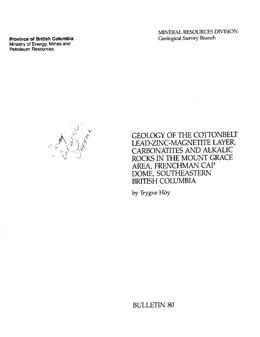
T. Höy
Bulletin 80 covers the Mount Grace area, which includes approximately 200 square kilometres of subalpine to alpine terrain in the Monashee Mountains northwest of Revelstoke. It is on the northwestern flank of Frenchman Cap dome on the eastern margin of the Shuswap Complex between the Columbia River fault on the east and the Monashee décollement on the west.
The area is underlain by paragneiss and orthogneiss of probable Aphebian age in the core of the dome, unconformably overlain by a heterogeneous platformal succession of quartzite, pelitic schist and gneiss, calc-silicate gneiss and marble, referred to as the autochthonous cover succession. Within and part of the succession are the Cottonbelt lead-zinc-magnetite layer and the Mount Grace carbonatite tuff.
The area has undergone intense polyphase deformation at high grades of regional metamorphism. Early Phase I isoclinal folds, including the Mount Grace syncline, dip west to northwest and plunge variably to the west. Phase 2 folds, with axes parallel to the prominent west-plunging mineral lineation, formed during the highest grades of metamorphism. They are most conspicuous in the Perry River area to the south where they are the earliest folds recognized. Phase 3 folds are upright, north-trending structures developed after the metamorphic culmination; they form a prominent embayment in the dome in the Perry River area.
Pelitic and calc-silicate mineral assemblages and fabrics record the culmination of regional metamorphism at temperatures of 650 to 7000C and pressures of approximately 7 kilobars during and after Phase 2 deformation. Overprinting of retrograde metamorphic minerals, formed at temperatures of 500 to 6000C but pressures less than 3.5 kilobars, indicates continued thermal metamorphism after tectonic uplift and removal of up to 15 kilometres of overlying rocks.
The Mount Grace carbonatite is a thin, laterally continuous marble layer traced and projected from the Perry River area to Kirbyville Lake, 60 kilometres to the north. It contains high values of niobium, barium, strontium, manganese and the rare earth elements. Lack of contact fenitization, widespread occurrence of included exotic clasts, and its tremendous lateral extent indicate a pyroclastic origin. At least three vent areas are identified, characterized by increasing number and size of clasts and by greater thickness and number of tuff beds. Intrusive carbonatites and nepheline syenites are recognized (McMillan and Moore, 1974) in the Perry River area.
Base and precious metal deposits in the area include a massive, stratiform lead-zinc-magnetite layer, disseminated copper in quartzite, disseminated copper with minor lead and zinc in calcareous rocks, disseminated lead in marble, and molybdenite in syenite. Most exploration has been directed toward the lead-zinc-magnetite layer, referred to as Cottonbelt and Bass on the west limb of the Mount Grace syncline, or Complex-McLeod on the east limb. It is an unusual lead-zinc-iron formation, several metres thick and several kilometres in length that contains an average of 5 to 6 per cent lead, 2 per cent zinc and 50 grams silver per tonne. Although it has many similarities with other stratabound lead-zinc deposits in the Shuswap Complex, including Jordan River, Ruddock Creek, Big Ledge, Colby and CK, noticeable differences in their tenor, mineralogy, host, and stratigraphic and structural settings are apparent.
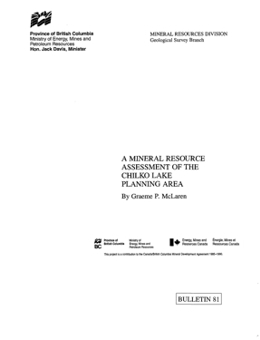
G. McLaren
Bulletin 81 covers the Chilko Lake Planning Area, which encompasses a portion of the transition zone between the rugged mountains of the Coast Ranges and the rolling terrain of the Interior Plateau in south-central British Columbia. It comprises an area of scenic beauty with high wildlife and recreational resource values that has long been studied as a candidate for a provincial park. However, it also covers a region of high mineral potential. This mineral resource assessment was undertaken to determine the mineral potential of the planning area in detail, in order that informed decisions can be made regarding the boundaries of any future provincial park proposal. A program of 1:50 000-scale geological mapping, detailed stream-sediment sampling, and prospecting with extensive rock chip sampling was conducted to identify the mineral potential.
Two broad geologic assemblages are present in the Chilko Lake Planning Area; an intrusive assemblage related to the Coast Mountains extends across the south and southwestern border of the area while a volcanic-sedimentary assemblage underlies the remainder. Diverse geological environments, typical of the convergent plate margin setting of western North America, are present in the two broad assemblages. These environments developed in response to terrane collisions and subsequent uplift of the Coast plutonic complex. The stratigraphy of the area records a predominantly Early Cretaceous volcanic island arc environment that interfingers with the clastic sedimentary environment of the Tyaughton trough. The products of widespread Late Cretaceous volcanism overly the older rocks. This succession has been truncated by the Coast Mountain intrusions on the southwest as well as by numerous smaller intrusive stocks and dikes. Extensive northwest-trending transcurrent fault zones, some with displacements measuring tens of kilometres, transect the map area. Northeast-trending faults are younger and have limited displacements. Northeasterly-directed thrust faults and high-angle reverse faults may be related to uplift of the Coast Mountains.
Stream-sediment geochemical data for the area are characterized by distinct populations from the volcanic/sedimentary succession and the Coast plutonic complex. Anomalous metal concentrations, determined by probability plot analysis, successfully identified known mineralization as well as other zones worthy of follow-up exploration. These anomalous zones generally follow structural or intrusive trends, that is, those zones most favourable for metallogenic processes. Lithogeochemical data acquired from mineralization or associated alteration assemblages were classified by mode of occurrence of the material sampled and further characterized metallogenic models applicable to the area. The geochemical data, in conjunction with the geological mapping, give strong indications that structurally controlled precious metal vein deposits, intrusion-related porphyry copper or molybdenum deposits, and volcanogenic massive sulphide deposits may be present in the area. Limited data also suggest the potential for copper-tungsten skarn deposits.
Metallogenic environments typical of a convergent plate margin setting are found throughout the Chilko Lake Planning Area. Mesothermal and epithermal precious metal vein mineralization related to the Coast Range intrusives is well documented, as at the Pellaire occurrence, and in the major structural zones, as at the Vick and Charlie gold occurrences, the Alexis mercury-copper occurrences, and the Twin Creek arsenic and copper-gold occurrences discovered during the course of this project. The exploration for similar vein deposits currently being conducted in the adjacent Taseko River to Gold Bridge area provides an incentive for locating new precious metal vein deposits in the correlative but less explored rocks of the Chilko Lake study area. Porphyry copper-molybdenum (± gold) mineralization, similar to the Fish Lake deposit immediately adjacent to the study area, is known at the Charlie occurrence and at the newly discovered Tarn Creek occurrence. Similar minor mineral showings suggest a wider potential for this type of deposit. Copper-tungsten skarn mineralization is known at the Daisie occurrence. Gossanous zones with minor copper mineralization in rhyolitic volcanic horizons indicate the potential for volcanogenic massive sulphide mineralization in rocks thought to be correlative with those hosting the Britannia mine orebodies near Squamish.
The mineral potential of the planning area is believed to be relatively high. The area lies along the trend of numerous mineral occurrences that follows the border of the Coast plutonic complex through British Columbia. Surveys conducted in this project have confirmed this high potential; four significant new mineral showings and a number of new minor occurrences have been discovered. A mineral potential classification utilizing the three types of data determined in this project (geological, geochemical and mineral occurrence) has been developed and provides a semiquantitative measure of the relative mineral potential within the map area. Qualitative descriptions of the mineral potential levels identify the degree of confidence underlying the mineral potential classes and provide an indication of expected future exploration in an area. Zones of high potential are confidently defined in the vicinity of known mineral occurrences. Surrounding these, zones of moderate potential are outlined by the presence of geochemical anomalies and geological/metallogenic trends that are favourable for mineral occurrences. Areas of either favourable geological or geochemical indicators suggest a low to moderate potential, but require further prospecting before this designation can be made with certainty. A limited area has been designated as having a low mineral potential.
Economic conditions often focus mineral exploration on certain commodities, such as the present emphasis on gold, and this is reflected in the designations of mineral potential. Currently, the greatest potential for an economic mineral discovery lies in locating precious metal vein deposits, however porphyry and possibly skarn deposits, if they contain sufficient gold, are also viable exploration targets. Volcanogenic massive sulphide deposits are not known in the area; however, there is a moderate potential for these occurrences in certain zones. Zones where the currently less attractive exploration targets, such as base metal porphyries, skarns and the massive sulphide environments are indicated should be inventoried for possible future industry evaluation. Overall the Chilko Lake Planning Area has a sufficiently high mineral potential to warrant continued mineral exploration; further new mineral discoveries can be expected to follow.
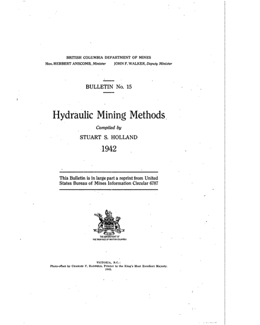
D.A. Grieve
Bulletin 82 discusses the Elk Valley coalfield, which is one of three structurally separate coalfields in southeastern British Columbia. Total potential in situ coal resources are a minimum of 7.8 billion tonnes.
The coal-bearing Mist Mountain Formation ranges from less than 425 to approximately 700 metres in thickness in the study area. An average of approximately 10 per cent of its total thickness is composed of coal seams, which range up to 13 metres in thickness. The basal 20 metres of the formation, referred to informally as the “basal coal zone", consistently contains coal and other carbonaceous strata. The “Imperial seam", in the lower half of the formation, is correlated laterally in drill core and surface exposures over a distance of approximately 17 kilometres.
Lithologies in the Mist Mountain Formation form a Markov chain. The data confirm a general fining-upward sequence typical of fluvial-alluvial depositional systems. The coal-forming environment is believed to have been relatively isolated from sources of clastic material. In terms of statistical sequence modeling, the lower half of the Mist Mountain Formation is not significantly different from the upper half.
Tonsteins are found throughout the Mist Mountain Formation. Lateral continuity of tonsteins over a distance of 1.4 kilometres is documented in two cases. The tonsteins are believed to represent volcanic ash, possibly reworked. All are kaolinite rich, and one example is also rich in the phosphate mineral gorceixite.
Vitrinite is the most abundant maceral in coals from the study area, comprising 51 to 93 per cent of total organic material. In general, the amount of vitrinite increases up-section. Semifusinite is the most abundant inertinite maceral and its concentration is inversely related to that of vitrinite. Liptinite is generally rare or nonexistent, although coals in sections of predominantly high-volatile rank contain 1 to 5 per cent liptinite. Petrographic indices suggest vegetation was deposited in situ, although there is some indication that the relative amount of movement of vegetation prior to deposition decreased up-section. It is also apparent that the height of the water table generally increased higher in the stratigraphy.
The major structure of the Elk Valley coalfield is the Alexander Creek syncline. Overall it has a north-northwest trend, and no net plunge; locally its plunge is subhorizontal to gentle. It is generally asymmetric, open, and has an upright to steeply inclined axial plane. Thrust faults, including the Ewin Pass fault, are more common on the east limb than on the west. Other major structures in the coalfield are the Greenhills syncline, which is separated from the Alexander Creek syncline to the east by the west-dipping Erickson normal fault, and the Bourgeau thrust fault, which marks the western boundary of the northern part of the coalfield.
Based on mean maximum vitrinite reflectance (meanRmax) coal ranks in the Mist Mountain Formation generally range from low-volatile to high-volatile A bituminous, with a few instances of high-volatile B bituminous. Reflectance gradients within measured stratigraphic sections range from 0.057 to 0.119 per cent per 100 metres, with no systematic geographic variation. At most locations, the lower part of the formation contains coals of medium-volatile bituminous rank, typically with reflectance values of 1.3 to 1.4 per cent. At three locations (Crown Mountain, Mount Banner and Weary Creek) the coals in the lower part of the formation are of low-volatile rank. At one location (Bleasdell Creek), the entire formation contains high-volatile coals.
Determination of the principal axes of the reflecting indicating surface (RIS) of coal samples suggests that all coals in the study area are biaxial. Values of Rst, the reflectance parameter which represents the style of the RIS, range from - 16.537 (biaxial negative) to +5.209 (biaxial positive) and, for the most part, do not vary systematically. All of the following reflectance parameters are effective indices of rank variation: Rmax, Rm (mean random reflectance), Rev (the radius of a sphere of volume equal to that of the RIS) and Rmax (the magnitude of the maximum axis of the RIS).
There is no firm evidence of down-dip rank increases indicating the occurrence of post-folding coalification in the Elk Valley coalfield. However the RIS analysis suggests that coalification was at least partly concurrent with compressional deformation, and other aspects of the rank distribution suggest that it continued after the compressional deformation stage. On balance, it is believed that coalification occurred before, during and after compressional deformation, but completely predated the later extensional phase.
A wide spread of bituminous coal quality is available in the coalfield. Volatile matter content (dry. ash-free) in selected raw bulk-sample analyses from three properties ranges from 20.9 to 30.9 per cent. Ash content in the same samples varies from 6.5 to 33.1 per cent, while sulphur values are all less than or equal to 0.7 per cent. Current products from the coalfield include coking coals of varying volatile matter content, semicoking coals and thermal coals.
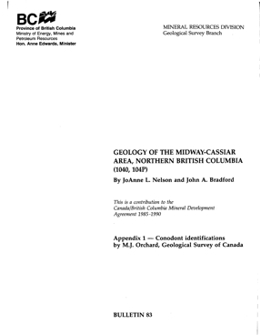
J.L. Nelson and J.A. Bradford
Bulletin 83, which covers the Midway-Cassiar project area, located in the Cassiar Mountains of far northern British Columbia, spans two distinct but inter-related terranes, the pericratonic Cassiar Terrane and the Slide Mountain Terrane, represented by Sylvester allochthon, a large, complex eugeosynclinal klippe. Cassiar Terrane exposures are of platformal to continental slope, deep-water strata that range from late Proterozoic to Early Permian in age. These units have widespread correlatives along the ancient North American continental margin.
In the project area, the Sylvester allochthon comprises three structurally stacked divisions, each of which represents a separate late Paleozoic tectonic and depositional environment. Upper Triassic sediments are restricted to the highest structural level in Division II. It is suggested that they correlate with autochthonous Triassic strata in the Rocky Mountains and Selwyn basin. Division I, the lowest and therefore assumed to represent the facies originating closest to the late Paleozoic continental margin, is primarily a sedimentary sequence with strong similarities to the Earn Group and overlying Mississippian to Early Permian chert and argillite which occurs at the top of the Cassiar Terrane stratigraphic succession. Division II is an ophiolitic assemblage. It contains fragments of oceanic, ultramafic-gabbroic basement and stratified early Mississippian to Early Permian sequences of interbedded basalt, sediments and diabase sills. Significantly, siliciclastic units identical to Earn Group sandstones are intimately interbedded with basalt flows and tuffs in Division II.
Division III is a late Paleozoic island-arc package that resembles Yukon Tanana and Harper Ranch Terrane assemblages, rather than the Slide Mountain Terrane. It contains three suites: a pyroclastic-epiclastic sedimentary sequence with interbedded continentally derived sandstones, that is intruded by an early Mississippian pluton; a widespread Pennsylvanian-Permian island-arc edifice with fringing reefs and chert-limestone-epiclastic marginal facies; and an Early Permian intermediate pluton with a later potassium-rich volcanic suite.
Geochemical data reflect a mid-ocean-ridge signature for Division II igneous rocks and an island arc signature for Division III, in keeping with their lithologic character and associations. It is believed that Divisions I and II developed within a small, marginal ocean, which opened initially during a Devono-Mississippian rifting event that affected the entire North American continental margin, and continued to spread slowly behind the developing arc of Division III. The fusulinids in Division III resemble those in other marginal terranes from Mexico to northern Washington State, rather than those on the North American craton. The paleogeographic significance of this persistent east-west provinciality remains unclear.
The diverse geology of the Midway-Cassiar project area is reflected in its metallogeny and mineral potential. Deposits include Devono-Mississippian exhalites in the Earn Group and Sylvester allochthon, the Cassiar and McDame asbestos deposits in Sylvester serpentinites, the Erickson and Taurus gold deposits in mesothermal quartz veins, and silver-lead-zinc mantos, tungsten skarns and porphyry molybdenum deposits. The single-phase carbonic fluid types that generated the gold-quartz veins were introduced at 1.4 to 2.2 kilobars (140-220 MPa) total pressure and a temperature of 350 to 4000C, while the mantos resulted from two phases introduced within a temperature range of 280 to 3400C. There are strong geological ties between the Midway silver-lead-zinc manto deposit and Late Cretaceous intrusions, porphyry deposits and skarns.
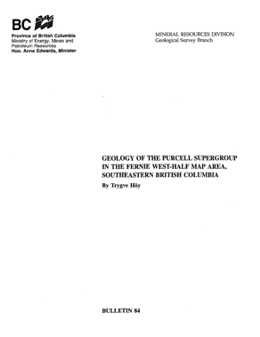
T. Höy
Bulletin 84 covers the Fernie west-half map area, which is underlain by Middle Proterozoic Purcell Supergroup, Late Proterozoic Windermere and Paleozoic miogeoclinal rocks. The Purcell Supergroup, the main focus of this study, has been affected by tectonic events in Middle and Late Proterozoic, Early Paleozoic and Mesozoic time.
The Purcell Supergroup comprises a thick accumulation of clastic and carbonate rocks that are interpreted to have been deposited in a large intracratonic basin. The northeastern margin of the basin is exposed in the northern part of the Fernie west-half sheet. It developed by growth faulting and is characterized by rapid and pronounced facies and thickness changes, in contrast with more subtle changes that occur elsewhere in the basin.
Moyie sills form an extensive suite of basaltic rocks that intruded the Aldridge and Fort Steele formations, the lower part of the Purcell Supergroup. Many of these sills were intruded at very shallow depths in unconsolidated, water-saturated sediments. Hence a Middle Proterozoic date of 1445 Ma from one of the sills defines the minimum age of deposition of lower and basal middle Aldridge, and of stratiform mineral deposits such as the Sullivan orebody.
Sullivan, a massive sulphide lead-zinc-silver deposit in Aldridge Formation turbidites, is the largest mineral deposit in the area. It has produced in excess of 125 million tonnes of ore from an original deposit of about 160 million tonnes. Other deposits in the Purcell Supergroup include lead-zinc replacement deposits in Upper Purcell carbonates and numerous lead-zinc-silver and copper veins. Exploration focus has been on finding new sedimentary exhalative deposits of the Sullivan type, but there is also potential for polymetallic vein deposits.
This report describes in detail the stratigraphy, depositional environment and tectonic setting of the Purcell Supergroup. It also describes the Moyie sills and presents evidence that they record a magmatic event during deposition of the host Aldridge and Fort Steele formations. Granitic rocks are described, and the structure and tectonic history of the area. Mineral deposits are classified and described and the controls of mineral deposition, including both the synsedimentary tectonic setting and later tectonic events, are outlined.
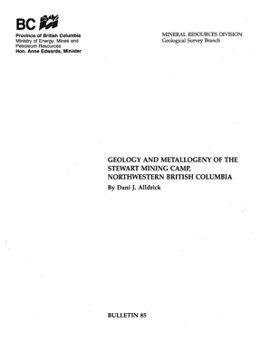
D.J. Alldrick
Bulletin 85 discusses the Stewart mining camp in northwestern British Columbia, which is underlain by an Upper Triassic to Lower Jurassic island-arc complex. The subaerial volcanic pile is constructed of calcalkaline basalts, andesites and dacites with interbedded sedimentary rocks. Lateral variations in volcanic rock textures indicate that the district was a regional paleotopographic high with a volcanic vent centred at Mount Dilworth. Early Jurassic calcalkaline homblende granodiorite plutons of the Texas Creek Plutonic Suite represent coeval, epizonal subsidiary magma chambers at depths of 2 to 5 kilometres below the stratovolcano. From these plutons, late-stage two-feldspar porphyritic dikes cut up through the volcanic sequence to feed surface flows. Following subsidence this succession was capped by Middle Jurassic marine-basin turbidites.
Mid-Cretaceous tectonism was characterized by greenschist facies regional metamorphism, east-northeast contraction, and deformation. It produced upright north-northwest-trending en echelon folds and later east-verging, ductile reverse faults and related foliation.
Mid-Tertiary calcalkaline biotite granodiorite of the Coast Plutonic Complex intruded the deformed arc rocks. The batholith, stocks and differentiated dikes of the Ryder Plutonic Suite were emplaced over a 30-million-year period from Early Eocene to Late Oligocene.
The 200 mineral occurrences in the district formed during two mineralizing events that were characterized by different base and precious metal suites. One ore-forming episode occurred in Early Jurassic time and the other in the Eocene. Both metallogenic epochs were brief, regional-scale phenomena. Some deposits from the younger mineralizing episode were emplaced adjacent to older deposits.
All Early Jurassic deposits were emplaced in andesitic to dacitic host rocks at the close of volcanic activity, about 185 million years ago. They have regional zoning patterns that are spatially related to plutons of the Texas Creek suite and to their stratigraphic position within the volcanic-sedimentary sequence. The Early Jurassic hydrothermal system acquired its characteristic suite of silver, gold, zinc, lead and copper from magmatic fluids. Early Jurassic deposits include gold-pyrrhotite veins, veins carrying silver, gold and base metals, and stratabound pyritic dacites. Gold-pyrrhotite veins formed adjacent to the subvolcanic plutons during late magma movement. Epithermal base and precious metal veins and breccia veins were formed along shallower faults and shears, and in hydrothermal breccia zones along the contacts of subvolcanic dikes. Stratabound pyritic dacites are barren fumarole and hotspring-related deposits that formed on the paleosurface from shallow groundwater circulation within hot dacitic pyroclastic sheets.
Tertiary silver-rich galena-sphalerite veins are related to intrusion of Middle Eocene biotite granodiorite stocks of the Coast Plutonic Complex. All deposits are localized in brittle faults or fractures; most have southeast trends and subvertical dips. Likely sources for the silver in these Tertiary deposits are turbidite sequences within the Unuk River Formation and thicker, infolded turbidites of the Salmon River Formation. Tertiary skarns and porphyry molybdenum deposits are also genetically related to the Middle Eocene plutons.
All these deposit types can be selectively explored for by using diagnostic features such as stratigraphic and plutonic associations, alteration assemblages, gangue mineralogy and textures, sulphide mineralogy and textures, precious metal ratios and lead isotope signatures.
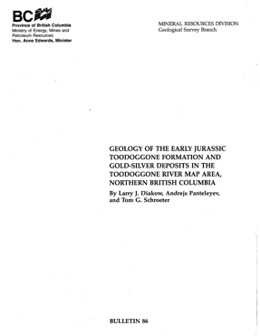
L.J. Diakow, A. Panteleyev, T.G. Schroeter
Bulletin 86 discusses the Early Jurassic Toodoggone Formation, which is a new stratigraphic division of the Hazelton Group in the Toodoggone River map area, north-central British Columbia. The Toodoggone Formation consists of six lithostratigraphic members comprising high-potassium (3.1% K20 at 57.5% SiO2), calcalkaline latite and dacite subaerial volcanic rocks. Hornblende-biotite-quartz±sanidine phenocrysts and metamorphic minerals indicative of the zeolite facies characterize the volcanic rocks. Basalt and rhyolite occur only as rare, late dikes and sills. Toodoggone extrusive and intrusive magmatism is intimately associated with the structural development of an elongate, regional volcano-tectonic depression. Basal strata of the Toodoggone Formation unconformably overlie submarine island-arc volcanic rocks and sediments of the Permian Asitka and Upper Triassic Takla groups and, in turn, are capped unconformably by Cretaceous continental clastic rocks of the Sustut Group.
Potassium-argon and argon-argon dates from the Toodoggone Formation span about 7 Ma between late Sinemurian and early Pliensbachian time; they define two discrete eruptive cycles with an intervening brief period of uplift and erosion. Shallow-marine clastic rocks with middle to late Toarcian fossils were deposited locally after volcanism ceased. The lower cycle began with widespread plateau-forming eruptions of dacitic ash-flow and air-fall tuffs. These were in part synchronous with and superseded by latite flows and lahars that formed constructional point-source volcanoes. Comagmatic plutons, emplaced during this early eruptive period, were partly unroofed and eroded prior to inception of the upper volcanic cycle. The upper cycle began with mainly explosive, dacite pyroclastic eruptions. Volcanism culminated with voluminous outpourings of ash-flow tuffs within an asymmetric collapse feature - the central Toodoggone depression.
Toodoggone Formation lithologies provide a record of island-arc magmatism but both the style of volcanism and major element compositions suggest a continent-margin arc setting. A thick, "continent-like" substrate might underlie the Toodoggone area. It perhaps extends beneath much of the ancestral Hazelton island-arc system that presently occupies the northeastern margin of Stikinia. The arc segment in the Toodoggone area appears to be east facing and related to steep, oblique, westward subduction that initiated synvolcanic intra-arc extension and shallow crustal subsidence.
Hydrothermal circulation and the formation of a variety of mineral deposits are related to the extensional tectonic setting and the protracted magmatic history of the Toodoggone arc. Gold and silver in the Toodoggone district are most commonly found in quartz veins with associated adularia, sericite and calcite. Locally gold-barite veins cut clay-altered volcanic rocks containing varying proportions of fine-grained silica, dickite and natroalunite.
Fluid inclusions in quartz from the precious metal vein deposits are typical of epithermal environments. They contain low temperature, dilute hydrothermal fluids of predominantly meteoric origin (Th <200 - 3000C and approximately 3 equivalent weight per cent NaCl). Light stable isotope analyses show marked 18O enrichment of about + 8 per mil in the volcanic hostrocks, hydrothermally altered rocks and mineralized vein quartz (with adularia or sericite). The isotopic composition of the hydrothermal fluid is calculated to be about 0 per mil 18O. These hydrothermal fluids are isotopically evolved mixtures of meteoric and magmatic waters with possible metamorphic input.
Potassium-argon age determinations on alunite from several zones of intensely acid-leached rocks suggest that an early mineralizing episode occurred around 190 Ma or earlier. This hydrothermal event coincides with uplift and cooling of the Black Lake and possibly other stocks. Potassium-argon dates on adularia and sericite from precious metal bearing quartz veins, some of which are found in volcanic rocks of the upper cycle, suggest that there was also a younger mineralizing event. Argon step-heating dates indicate that the major gold-silver vein deposits with adularia-sericite range from 189.7±2.6 Ma to l86.7±1.7 Ma (Clark and Williams-Jones, 1991). This closely follows the latest stages of Toodoggone volcanism and fault-block subsidence.
A depth zoning model for mineralization illustrates two types of epithermal regime: adularia-sericite and acid-sulphate (alunite-kaolinite). Gold-barite in the extensive, advanced argillic and argillically altered zones at the Al deposit represent near-surface acid-sulphate alteration formed on the flanks of a stratovolcano. The advanced argillic altered zone at Silver Pond, next to the major Lawyers adularia-sericite deposit, represents a downfaulted acid-leached outflow (i.e. the upper steam-heated portion of the Lawyers hydrothermal system). The Lawyers deposit and most of the other occurrences are adularia-sericite type deposits formed at slight depth. These deposits all occur in grabens or half-grabens within the central Toodoggone depression, a synvolcanic structure nested within a broader, segmented volcanic field.
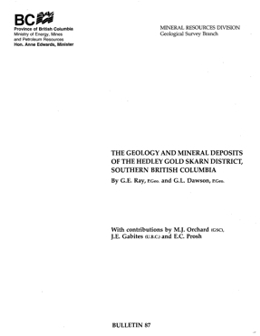
G.E. Ray and G.L. Dawson
The Hedley mining district of British Columbia described by Bulletin 87 lies within the allochthonous Quesnel Terrane of the Intermontane Belt. It is situated at the eastern edge of the Upper Triassic Nicola Group, close to the group's contact with Paleozoic and Triassic oceanic rocks of the Apex Mountain Complex.
The Nicola Group is a westerly thickening, late Carnian to late Norian calcareous sedimentary and arc-related volcaniclastic sequence that was deposited on a tectonically active, west-dipping paleoslope. Sedimentary facies changes and paleocurrent indicators suggest that the sediments in the group were derived largely from an eastern source. The Nicola Group in the Hedley area was laid down across a structural hinge zone that marked the rifted margin of the westerly deepening, shallow-marine Nicola basin.
A sedimentary succession is recognized in the Nicola Group. This includes an upper, widely developed and thick (at least 1200m) unit, the Whistle Formation, which consists largely of alkalic and subalkalic tuffs and tuffaceous sediments. The base of the formation is marked by an extensive limestone-clast-bearing unit, the Copperfield breccia, which reaches 200 metres in thickness and 16 kilometres in strike length. The unit is an important stratigraphic marker horizon in the district, and is believed to represent a gravity-slide megabreccia deposit.
The Whistle Formation is underlain by a succession in which four sedimentary facies are distinguished: from east to west, the thin (up to 200m), shallow-marine. limestone-dominant French Mine Formation; the thicker, siltstone-dominant Hedley and Chuchuwayha formations in the central part of the area; and the thick (up to 2200m), deeper water and argillite-dominant Stemwinder Formation. Conodonts from the French Mine, Hedley and Chuchuwayha formations indicate they are Late Triassic (Carnian-Norian) in age. The sedimentary facies were separated from one another by long-lived faults that marked syn-sedimentation scarp slopes related to rifting along the Nicola basin margin.
The Chuchuwayha, Hedley and French Mine formations are underlain by a sequence of mafic tuffs with minor flows, limestone and chert-pebble conglomerate, the Oregon Claims Formation. The age of this unit and its contact relationship with the overlying rocks are uncertain. The formation may represent the oldest exposed section of the Nicola Group, but it is more likely to be an older basement, and it may represent a western extension of the Apex Mountain Complex.
A newly recognized mid-Jurassic unit, the Skwel Peken Formation, overlies the Nicola Group. It consists of a 1900-metre succession of calcalkaline andesitic to dacitic tuffs with minor amounts of epiclastic sediments, and pyroclastic surge deposits. It was laid down in a non-marine, subaerial to shallow water environment and is believed to represent volcanism related to the mid-Jurassic plutonism represented by the Cahill Creek and Lookout Ridge plutons.
Minor amounts of Cretaceous Spences Bridge Group and the Eocene Springbrook and Marron formations are also present in the area.
Several episodes of plutonism are recognized. The oldest resulted in the quartz dioritic and gabbroic Hedley intrusions that are associated with widespread gold skarn mineralization. Equivocal radiometric U-Pb dating and field evidence suggest they were intruded during Late Triassic to Early Jurassic time (219-194 Ma). The intrusions occur as large and small stocks, as abundant sills, or as rare dikes; the sills are preferentially developed in the thinly bedded Chuchuwayha and Hedley formations.
A slightly younger intrusive episode produced the large, granodioritic Bromley batholith and a related marginal body, the granodioritic to gabbroic Mount Riordan stock. The latter is genetically associated with the Mount Riordan (Crystal Peak) skarn that is being evaluated as a potential industrial garnet deposit. A radiometric U-Pb zircon age of 194.6±1.2 Ma (Early Jurassic) is indicated for the Mount Riordan stock, and a similar age has been obtained from the Bromley batholith.
A subsequent phase of granodioritic to quartz monzonitic magmatism is represented by the Lookout Ridge and Cahill Creek plutons; the latter, which commonly separates the Nicola Group to the west from the Apex Mountain Complex farther east, yielded a U-Pb zircon date of 168.8±9 Ma (mid Jurassic). These high-level plutons are spatially related to a suite of aplites and quartz porphyry minor intrusions that yielded a U-Pb zircon date of 154.5+8-43 Ma (Late Jurassic).
The youngest major intrusion in the district, the Verde Creek stock, is coeval with the Early Cretaceous Spences Bridge Group; it intrudes the Nicola Group in the western part of the district. A rare suite of leucocratic, calcalkaline minor intrusions (or possible volcanic flows) is spatially associated with the Skwel Peken Formation. These rocks contain magmatic garnet phenocrysts with almandine-rich cores and spessartine-rich margins that are chemically distinct from the grossular-andradite garnets in the gold skarns.
Two deformational episodes are identified in the Apex Mountain Complex, the first and predominant of which resulted in tight to isoclinal folds with moderate to strong penetrative axial planar fabrics.
Two structural phases are also recognized in the Nicola Group, neither of which produced dominant penetrative fabrics. These predate both the Skwel Peken Formation and the Cahill Creek pluton, which suggests they are pre mid-Jurassic in age. A younger phase of folding has gently deformed the Skwel Peken Formation. The first phase, which was only locally developed in the Nicola Group, produced minor flexure folds that were probably related to the forcible emplacement of the Hedley intrusions. At Nickel Plate, these structures partly controlled the gold skarn mineralization.
The second deformational phase to overprint the Nicola Group was the dominant structural event in the district. It resulted in overturned minor and major asymmetric folds, including the large Hedley anticline. The youngest (post mid-Jurassic) fold phase has only been identified in the Skwel Peken Formation; it produced open minor flexure folds.
The Hedley district has important skarn deposits as well as some minor gold-bearing quartz-carbonate veins. The skarns are separable into two types, the most important being gold skarns which are characteristically pyroxene dominant. The second and less common type is garnet dominant and contains some tungsten and copper but little or no gold; the Mount Riordan skarn represents the largest of this second type.
Between 1904 and 1991 the gold skarns produced over 62 tonnes of gold from 8.4 million tonnes of ore mined, of which over 97% was won from the Nickel Plate deposit; lesser amounts were recovered from gold skarns at the French, Canty and Good Hope mines. The overall gold grade of all the gold skarn deposits mined (by under-ground and open pit) in the district is 7.43 grams per tonne.
The gold skarns are genetically and spatially related to the dioritic stocks and sill-dike swarms of the Hedley intrusions. Economic gold skarns are hosted only by the Nicola Group and are structurally, stratigraphically and lithologically controlled; they favour areas where the Hedley intrusions cut the calcareous, shallower marine sedimentary facies rocks of the Hedley and French Mine formations.
Skarn alteration varies from narrow zones less than 10 metres wide to large envelopes hundreds of metres thick. The largest skarn envelope is at Nickel Plate where it outcrops over 4 square kilometres. Prograde skarn development is characterized by an early phase of K-feldspar-biotite-albite alteration, which is replaced subsequently by pyroxene-garnet-carbonate-scapolite assemblages. Mineralogical zoning is present in both the mineralized and barren skarns; this zoning generally consists of coarser grained garnet-rich proximal assemblages and finer grained pyroxene-rich distal assemblages. Gold-pyrrhotite-arsenopyrite mineralization is preferentially developed in the distal, pyroxene-dominant skarn.
Bizmuth tellurides, arsenopyrite and high pyrrhotite/ pyrite ratios characterize the auriferous ore, and the gold-sulphide mineralization is generally coeval with widespread scapolitization. The close temporal and spatial association between gold and scapolite suggests that chorine-rich fluids may have been important in the transportation and precipitation of gold.
The proposed model for the Nickel Plate deposit involves the injection of large volumes of magmatic fluid derived from the Hedley intrusions into the calcareous sediments to produce an early, high-temperature mineral sequence of biotite and orthoclase, followed by manganese-poor clinopyroxene and finally grandite garnet. The overall compositional zoning in the Nickel Plate garnets is from grossularitic cores to andraditic margins. Subsequently, sulphides, gold and scapolite were introduced at lower temperatures. Fluid inclusion studies (Ettlinger, 1990a) at Nickel Plate indicate the main pyroxene-garnet skarn formed at temperatures between 4600 and 4800C with average fluid salinities of 18.3 and 9.7 wt% NaCl equivalent for garnet and pyroxene respectively.
The Hedley intrusions, compared to other magmatic rocks related to base metal skarns, have the lowest amounts of total alkalis and silica, and the highest amounts of calcium, magnesium and iron. Low Fe2O3/FeO ratios and the presence of ilmenite and pyrrhotite in the unaltered Hedley intrusions, and abundant pyrrhotite in the ore suggest the skarns formed in a strongly reduced environment.
Skarn overprinting of the intrusions to produce endoskarn was accompanied by an increase in the potassium content and declines in total iron and the Fe2O3/FeO ratios. Initial skarn alteration of the sediments, to produce weakly altered exoskarn, was accompanied by gains in potassium, sodium and iron, with crystallization of K-feldspar, biotite, albite and minor pyroxene. As exoskarn alteration became more intense, the early minerals were replaced by hedenbergitic pyroxene and andraditic garnet, with corresponding losses of potassium, sodium, silica and aluminum and continuing gains in iron. It is believed that the breakdown of the ferromagnesian minerals in the endoskarn was the source for much of the iron enrichment in the exoskarn.
It is postulated that a large thermal cell formed around the Nickel Plate skarn. This probably resulted in the influx of meteoric waters into the base of the system, which mixed with the magmatic fluids and resulted in the deposition of sulphides and gold. Consequently, ore horizons are preferentially developed close to the base and lateral margins of the alteration envelope. By contrast, the upper and interior portions of the skarn tend to be barren. This zoning has relevance regarding future exploration of other, apparently barren, skarn outcrops that may mask mineralization at depth.
A district-wide, east-to-west change in the metallogeny, mineralogy and oxidation state of the skarns is suggested. Pyroxene-dominant and highly reduced skarns containing gold, arsenopyrite and bismuth tellurides occur in the west and central parts of the district, while more oxidized tungsten-bearing and garnet-dominant skarn such as the Mount Riordan skarn occur in the east. This zoning is partly due to the different sedimentary protoliths of the various skarns, which reflects the original sedimentary facies changes in the Nicola Group across the district. It is also related to the different ages and compositions of the associated intrusions.
The district has good exploration potential for new gold-skarn discoveries, and the deposit model and ore controls postulated for the Hedley district are applicable to other areas of the Cordillera.
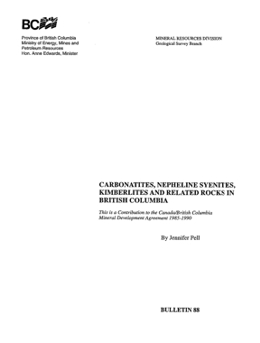
J. Pell
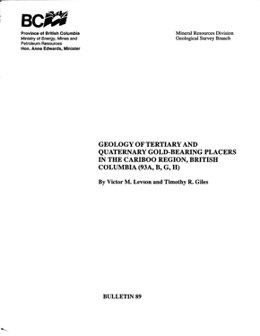
V.M. Levson and T.R. Giles
Bulletin 89 discusses stratigraphic, sedimentologic and geomorphic data collected from man-made and natural exposures at 6l placer gold mining and exploration sites in the Cariboo region of British Columbia that have been used to develop a geologic classification of productive placer settings. These are: Tertiary and pre-Late Wisconsinan paleochannel and paleofan settings; Late Wisconsinan glacial and glaciofluvial environments and; Holocene high and low terrace; colluvial and alluvial fan settings. Differences in the geologic characteristics of the placer deposits in these settings have direct effects on mining and exploration activities. Placer deposits that underlie till of the last glaciation are invariably the most productive as they accumulated over relatively long periods of time. The precise age of many of these pre-Late Wisconsinan deposits is unknown due to the lack of dateable materials. Although many are believed to be Pleistocene interglacial deposits, some may be Tertiary. The main difficulty in locating, evaluating and mining these deposits is a result of the overlying Quaternary sediments, which obscure and commonly deeply bury them.
Five main auriferous lithofacies, distinguished by differences in grain size and sedimentary structures, have been recognized. In order of decreasing importance these include (with inferred depositional environments): a) massive to crude, sub-horizontally stratified gravel with weak imbrication (shallow, gravel-bed stream deposits; mainly longitudinal bar deposits); b) clast-supported, matrix-filled gravel and gravelly diamicton with coarse-clast clusters (sediment-rich flood-flow and noncohesive debris-flow deposits); c) large-scale, trough crossbedded gravels (channel-fill deposits); d) planar cross bedded gravels (transverse bar deposits); and e) massive, fine-grained; matrix-supported diamicton (cohesive debris-flow deposits). Regardless of the dominant lithofacies, gold concentrations are invariably high along well developed erosional unconformities, particularly those over bedrock or clay-rich sediments.
Placer deposits known to be of Tertiary age occur mainly west of the Cariboo Mountains in the Quesnel Trough. They are typically buried by thick sequences of Quaternary sediments. Sedimentary structures, such as well developed stratification and imbrication, and the high textural maturity of the gravels, indicate deposition in well developed fluvial systems, usually large, braided or wandering gravel-bed rivers. The distribution of these ancient channel systems is apparently largely structurally controlled, not having been influenced by glaciation. Sites along major thrust faults separating the Quesnel, Barkerville and Cariboo terranes, specifically the Spanish, Eureka and Pleasant Valley thrusts, are good exploration targets for buried Tertiary deposits. Mining of these normally cemented gravels has been productive only in a few locations in the Cariboo. Locally, however, they can contain significant gold concentrations, warranting further exploration.
Four different types of pre-Late Wisconsinan paleochannel placer settings, distinguishable mainly by paleostream gradient, present topographic position and deposit size, are recognized:
- high gradient narrow valley settings referred to as paleogulches,
- abandoned, high level valleys of intermediate size and channel gradient,
- broad (hundreds of metres wide), abandoned trunk valleys with relatively low channel gradients, and
- channels buried in modern alluvial valleys with stream gradients similar to the modern channels.
The first two settings are dominated by low sinuosity single-channel, autochthonous placer deposits whereas the latter two are characterized by both autochthonous and allochthonous placers deposited in braided streams and, to a lesser extent, wandering gravel-bed river environments. Gold-bearing deposits typically consist of imbricated, moderately to well-stratified and sorted, pebble to 'cobble gravels interpreted as fluvial channel lag and longitudinal bar deposits. More poorly sorted and stratified deposits, interpreted as high discharge, sediment-rich, flood and debris-flow deposits, also occur but are less common.
Buried trunk valley and high level valley systems may have little relation to modern drainage patterns. These placers are most commonly exploited in areas where they have been partially exposed by erosion, as thick overburden is a major obstacle to mining. Paleochannel placers buried below modern alluvium have the additional problem of water drainage. These mining problems are somewhat offset by the potential richness and large volume of these placers.
Placer deposits in paleogulch settings are different from other paleochannel deposits in that they generally consist of poorly sorted, cobble to boulder-sized fluvial gravels with interbedded debris-flow deposits. The sedimentary characteristics of these deposits vary widely from bed to bed. Paleogulch placers also are generally smaller than other buried valley placer deposits but they often contain significantly higher gold concentrations. Historically they have been the richest gold producers in the Cariboo with most operations mining deposits where modern gulch-channel erosion has removed some of the overburden. Present mining operations are focused mainly on remnant paleogulch gravel left by previous hydraulic mining operations. There is good potential for the discovery of new high-grade buried paleogulch channels, especially in high relief areas such as along the upper reaches of Lightning, Antler and Cunningham creeks.
Paleoalluvial fan and fan-delta deposits comprise a significant part of the gold-bearing strata at two of the largest mines in the Cariboo (Spanish Mountain and the Ballarat mines). These placers are large in volume but generally are lower grade than fluvial paleochannel placers of similar age.
They consist of poorly sorted, debris-flow deposits interbedded with lenses of fluvial sands and gravels. Large foreset beds and other structures indicative of subaqueous deposition at the Baflarat mine lead to the inference that sedimentation occurred in a fan delta environment. Like paleochannel and paleogulch placers, paleofan deposits are difficult to locate and mine because of thick overburden.
Glacial and glaciofluvial placers deposited during the last glaciation are relatively rare and lower grade than older fluvial placers. Economically viable quantities of gold contained within till occur locally where glaciers overrode preexisting, relatively rich fluvial placers. Similarly, gold-rich glaciofluvial deposits are mined where older gold-bearing gravel has been eroded by glacial meltwaters. These placers are typically poorly sorted and commonly contain clasts up to large boulder size. Although Late Wisconsinan glacial and glaciofluvial placers generally have relatively low gold grades, they occur near the surface and therefore have minimal overburden removal costs.
Mines exploiting Holocene deposits, particularly terrace placers, are common in the Cariboo. Terrace deposits are dominated by imbricated, moderately to well stratified and sorted, pebble to small cobble gravels with interbedded sand lenses, of fluvial channel and bar origin. Gold generally is distributed throughout the gravels, but may be concentrated in specific facies such as bar-head and channel-lag gravels. Other deposits such as overbank sand facies generally have low gold concentrations. High level terrace gravels, deposited in proximal, aggradational, braided streams shortly after deglaciation, typically are larger in volume, more poorly sorted and lower grade than low terrace placers. The latter are frequently mined on the downstream reaches of streams, like Lightning Creek and the Quesnel and Cottonwood rivers, where mainly fine-grained gold is recovered. Productive Holocene colluvial and alluvial fan placers are relatively rare in the Cariboo. They characteristically consist of interbedded diamicton and poorly sorted gravel deposited under paraglacial conditions. Holocene placers, of all types, are most common where gold has been reconcentrated from underlying Tertiary or interglacial placer sources.
The potential for discovery of new placer deposits is good in the Cariboo. Although there is potential in all of the geologic settings identified, preglacial and interglacial fluvial and alluvial deposits are the best targets. Based on the results of this study, large volume, preglacial, paleochannel deposits in the Quesnel Terrane in the west part of the study region are considered to have the best placer potential. The paleogeography of these channels is believed to be largely related to the distribution of regional faults such as the Spanish and Eureka thrusts. There is also good potential for the discovery of buried placers, especially paleogulch deposits, in the Quesnel Highland in the eastern part of the study area.
Due to burial by glacial and postglacial deposits, air photo and satellite data, geophysical studies (including shallow reflection and refraction seismic, ground-penetrating radar, magnetometer, electromagnetic. resistivity, and induced polarization) and drilling programs are needed to locate and evaluate pre-Late Wisconsinan paleochannel placers. In contrast, most Holocene placers are more readily evaluated and mined due to the absence of a surficial cover; generally low gold grades require that successful ventures rely on detailed sedimentologic and geomorphic information, such as large-scale surficial geology map data, during both the exploration and mining phases. An understanding of the sedimentary origin of existing placers is needed to identify new sites where gold-bearing placers have been deposited and preserved. For example, geologic studies of existing exposures help us understand the paleodrainage patterns of ancient fluvial systems and thereby identify exploration targets. Similarly, stratigraphic and sedimentologic data, providing information on the thickness, depth and geometry of strata, channel orientation and paleoflow direction, are required to locate and trace gold-bearing units. Information presented in this paper improve this database and will assist in the identification of new potential placer sites.
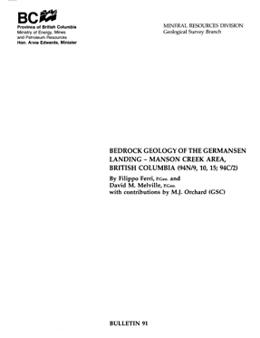
F. Ferri and D.M. Melville
The Germansen Landing-Manson Creek area, which is located within the southern Omineca Mountains of north-central British Columbia, is the subject of Bulletin 91. This region straddles the Intermontane-Omineca Belt boundary and encompasses rocks from five tectonostratigraphic terranes and subterranes. These are: North American siliciclastics and carbonates of the Cassiar Terrane, represented by the Upper Proterozoic Ingenika Group through to the Devonian to Permian Big Creek group; pericratonic clastics of the Kootenay Terrane, comprised of the Upper Proterozoic to Paleozoic(?) Boulder Creek group; the oceanic Slide Mountain Terrane, which is made up of deep water argillites, cherts and basalts of the Mississippian to Permian Nina Creek group, arc volcanics and sediments of the Triassic to Jurassic(?) Takla Group of the Quesnel Terrane; and the Harper Ranch Subterrane, represented by Mississippian (?) to Permian arc volcanics and sediments of the Lay Range assemblage.
These rocks were polydeformed and strongly metamorphosed beginning in the Mesozoic as a result of collision and obduction of exotic terranes from the west. Middle Jurassic, northeast-verging D1 deformation was accompanied by regional metamorphism, which reached sillimanite grade within the Wolverine Metamorphic Complex. Rocks of the Nina Creek group were imbricated and emplaced on top of North American rocks during this time period. Middle to Late (?) Jurassic D2 deformation refolded these rocks into upright to northeast and southwest (?) -verging structures. D3 deformation broadly warped and uplifted these rocks during the Early to Middle Cretaceous. Late Cretaceous to Tertiary right-lateral movement along the Manson fault zone was accompanied by dip-slip motion on the brittle-ductile, southwest-side-down Wolverine fault zone in response to uplift of metamorphic rocks within the Wolverine Complex. Rapid uplift of these rocks is recorded by early Tertiary K-Ar cooling dates. Rocks in the hangingwall of the Wolverine fault zone cooled relatively early in the deformational sequence (Middle Jurassic).
The map area contains a wide variety of mineral occurrences that reflect the long and complex history recorded by these rocks. The most abundant are polymetallic veins genetically related to the Manson fault zone and spatially related to strongly altered ultramafic bodies. Stratabound carbonate-hosted lead-zinc mineralization in the Otter Lakes group is locally important. Placer gold was mined in the district dating back to the late 1800s. Carbonatites form sill-like bodies along the Wolverine fault zone that locally have anomalous niobium values, and younger alkalic intrusives have anomalous REE concentrations.
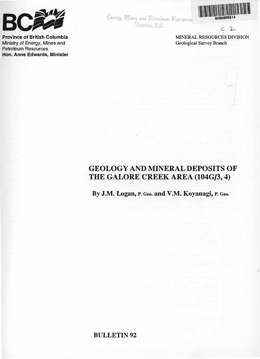
J.M. Logan and V.M. Koyanagi
Bulletin 92 describes the Galore Creek area, in northwestern British Columbia, which straddles the western boundary of the Intermontane Belt and Coast Belt and is underlain by rocks of the Stikine Terrane. Northwestern Stikinia is a composite allochthonous terrane made up of an amalgamation of volcanic island arcs ranging in age from mid-Paleozoic through Middle Jurassic, and intruded along its western margin by Jurassic to Paleocene plutons of the Coast Plutonic Complex.
At this latitude basement to Stikinia is an Upper Paleozoic primitive island arc assemblage, known as the Stikine assemblage. It consists of Permian, Carboniferous and Devonian calcalkaline and bimodal flows and volcaniclastics, silicic intrusions, interbedded carbonate, minor shale and chert. Macro- and microfossil ages and isotopic dating indicate a composite stratigraphic sequence which includes: Devono-Carboniferous island arc volcanic and plutonic complex; middle Carboniferous carbonate and Late Carboniferous basaltic and dacitic volcanic and volcaniclastic apron; and the hallmark of the Stikine assemblage, a regionally extensive Early Permian carbonate slope deposit.
A Permo-Triassic (Tahltanian) period of uplift and erosion of Late Permian rocks is recorded by Early and Middle Triassic starved-basin sedimentary rocks or Late Triassic Stuhini Group volcaniclastic rocks nonconformably overlying Early Permian limestone of the Stikine assemblage.
The Upper Triassic marked renewed volcanism and a cessation of pelagic sedimentation. The Upper Triassic volcano-plutonic complex at Galore Creek consists of a lower (Carnian to Norian) assemblage of plagioclase and clinopyroxene-phyric calcalkaline basaltic and andesite breccias and lesser volcaniclastic sedimentary rocks. Orthoclase porphyry syenites, shoshonitic basalts and alkali-enriched pyroclastic rocks (208 Ma) overlie these and indicate a late stage alkalic magmatic event. Stuhini Group volcanic rocks are chemically similar to rocks of the Takla Group. Plutonic rocks are coeval calcalkaline, ultramafic and intermediate plutons, and alkaline, shoshonitic intrusives. Early Jurassic Hazelton Group sediments and felsic tuffs overlie Upper Triassic volcanic conglomerates in apparent conformity.
Structural style at Galore Creek is dominated by brittle deformation and faulting and controlled by competency contrasts between volcanic and sedimentary rocks of the arc assemblage. Three or possibly four episodes of deformation have been recognized, but ages are poorly constrained. The earliest structures are synmetamorphic, pre-Triassic, possibly Carboniferous (?) age. These structures, and related northeast-striking penetrative foliations, are deformed by west-trending post-Triassic (?) folds. Two post-Early Jurassic events are recognized, one is characterized by north-trending southwest-verging folds and reverse faults; and the younger is characterized by northeast-verging kink folds.
Similarities between Stikinia and the northern Sierra-Eastern Klamath terranes of northern California include close faunal affinities of Permian corals and fusulinids, Devono-Carboniferous plutonism, Carboniferous and Permo-Triassic deformation and uplift events. These are all components of an Upper Paleozoic paleo-Pacific fringing arc system developed outboard of the cratonic shelf and now preserved as a disrupted, faulted belt of rocks extending the length of the North American Cordillera.
Metallogeny in the Galore area is related to plate boundary subduction processes and two separate mineralizing events, one in the latest Late Triassic and one in the Eocene. Each is characterized by a different base and precious metal suite. A Late Triassic to Early Jurassic alkalic volcanic centre at Galore Creek hosts ten synvolcanic copper-gold deposits. The largest, the Stikine Copper Limited central zone contains 125 000 000 tonnes of material with an estimated grade of 1.06% copper, 0.4 gram per tonne gold and 7.7 grams per tonne silver. A similar deposit occurs at Copper Canyon.
Pervasive potash metasomatism and retrograde calcsilicate alteration characterize the mineralized zones. Smaller tonnage, Eocene silver-rich base metal veins are associated with calcalkaline intrusions and hosted in northeasterly-striking faults at the Trek property and breccia-pipes at the Ptarmigan zone. Alteration and gangue minerals are quartz, sericite, and iron carbonate assemblages. Volcanogenic massive sulphide deposits (e.g., Tulsequah Chief) are an untested but viable exploration target in the Paleozoic Stikine assemblage rocks.
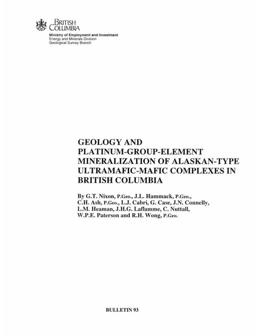
G.T. Nixon, J.L. Hammack, C.H. Ash, L.J. Cabri, G. Case, J.N. Connelly, L.M. Heaman, J.H.G. Laflamme, C. Nuttall, W.P.E. Paterson and R.H. Wong
Alaskan-type ultramafic-mafic complexes are potentially one of the most important hosts for economic concentrations of platinum-group elements (PGEs) in the Cordillera. Bulletin 93 summarizes the geology and noble metal geochemistry for most of the major Alaskan-type intrusions in British Columbia, including the Tulameen, Polaris, Lunar, Wrede, Johanson, Menard, Gnat Lakes and Hickman bodies. New U-Pb zircon dates and analytical data for the PGEs are presented in addition to revised geological maps (1:10 000-1:20 000 scale, in colour) for the Tulameen, Polaris, Lunar and Wrede complexes.
A case study of the platinum-group-element mineralogy and associated oxide and silicate minerals forming PGE-chromitite occurrences in the core of the Tulameen complex, and impure platinum nuggets in nearby placers, establishes a first-order genetic link despite fundamental differences in the speciation of the PGE. The geochemical signature of PGE derived from Alaskan-type intrusions is distinctive and sufficiently robust to serve as a valuable exploration tool, and should encourage the careful analysis of panned concentrates in prospecting for PGE.
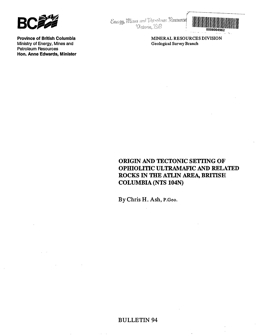
C.H. Ash
Bulletin 94 indicates that Mesothermal gold-bearing quartz veins throughout the Atlin placer camp of northwestern British Columbia are contained within or marginal to carbonate-altered ultramafic rocks (listwanites). These ultramafic rocks comprise individual thrust slices which form part of an imbricated package of late Paleozoic oceanic crust and upper mantle lithologies referred to as the Atlin ophiolitic assemblage. This ophiolitic assemblage was obducted onto a subduction-related accretionary complex, the Atlin accretionary complex, during the Middle Jurassic collision of Stikinia with North America.
Ultramafic rocks include both foliated harzburgite with subordinate dunite pods and peridotite cumulates, most likely wehrlite, that form individual thrust slices. The harzburgite is characterized by a medium to coarse-grained porphyroclastic texture, a well-developed primary foliation fabric (S1), and compositional banding with isoclinal folding of both banding and pyroxenite dikes. These features are widely accepted as indicating ductile deformation at subsolidus to hypersolidus conditions during and subsequent to mantle partial melting.
Primary silicate phase chemistry of the harzburgite indicates that the unit is highly refractory with a very limited compositional range (Ens87.8-90.2, F089.5-90.7). Chrome spinels in the harzburgite form highly irregular amoeboid shapes and compositionally display a large reciprocal variation of chrome and alumina, which defines a partial melting trend. The texture, structure and the primary phase chemical composition of the harzburgites indicate that they represent metamorphic mantle material formed by partial melting below a paleo-oceanic spreading centre. More specifically, the unit may be characterized as an abyssal peridotite formed within a mid-ocean ridge (MOR) paleotectonic setting as the chrome spinels have low Cr#[(Crx100/(Cr+Al); 23-47] and clinopyroxene contents are locally greater than 5%, indicating relatively fertile depleted mantle.
Whole-rock major, trace and rare-earth elemental (REE) data obtained for the metabasaltic rocks emplaced tectonically with the ultramafics, indicate that they are subalkaline tholeiitic in composition and also suggest a MOR paleo-tectonic eruptive setting for their origin. Petrogenetic modeling of the mantle source region using the basalt chemistry indicates that the basaltic liquids were derived by limited degrees of partial melting (10 to 15%). The ultramafic and metabasaltic rocks are therefore considered to be cogenetic.
The mantle section contains S2 emplacement-related fabrics that are defined by retrograde metamorphic assemblages after primary olivine and orthopyroxene. The distribution and variation in intensity of development of the S2 fabrics indicate that the ultramafic body has been affected by inhomogeneous bulk strain during tectonic emplacement in the solid state. Overprinting of these ductile fabrics by listwanite alteration along the basal thrust fault of the ultramafic body indicated subsequent influx of carbon-dioxide rich fluids.
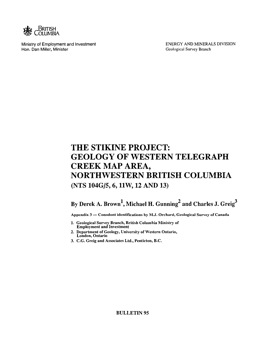
D.A. Brown, M.H. Gunning and C.J. Greig
Bulletin 95 is based on four field seasons of mapping in the western Telegraph Creek map area. The map area is underlain by Carboniferous to Permian Stikine assemblage strata unconformably overlain by unnamed Lower and Middle Triassic sedimentary rocks in isolated localities and by extensive Upper Triassic volcanic rocks of the Stuhini Group. Lower Jurassic volcanic rocks correlated with the Hazelton Group lie unconformably on the Stuhini Group in one area. They, in turn, are overlain unconformably by Upper Cetaceous to Paleocene polymictic conglomerate tentatively included in the Sustut Group. Eocene pyroclastic volcanic rocks and associated sills/flows cap the succession. Five new U-Pb and six new K-Ar dates, together with numerous macro and microfossil age determinations, help refine the stratigraphic successions.
Paleozoic rocks of the Stikine assemblage span about 65 Ma in the study area. Older Devonian strata, as found in the Forrest Kerr Creek area, are unrecognized here. The assemblage, with no exposed base, is divided into Upper Carboniferous tholeiitic volcanic rocks and sedimentary rocks both containing discontinuous limestone intervals (Devils Elbow and Butterfly units), Upper Carboniferous to Lower Permian felsic tuff (Navo formation), thick Permian limestone (Ambition Formation) and tuff, wacke and chert (Scud Glacier formation). The thick accumulation of open-marine limestone suggests a relatively stable tectonic setting for at least 30 Ma. The low-diversity fauna was dominated by benthic organisms. By the Upper Permian, interbedded tuff, repiesenting local calcalkaline pyroclastic volcanism, and chert and argillite were deposited.
Lower and Middle Triassic siltstone, argillite and impure limestone occur as isolated and rare exposures between the Stikine assemblage and Upper Triassic Stuhini Group.
The Upper Triassic (Stuhini Group) records the establishment of extensive submarine arc volcanism with local subaerial conditions and reworking of material by fluvial processes. Coarse breccias indicate significant relief and the diverse clast compositions suggest unroofing of the plutons (e.g. Hickman pluton) synchronous with erosion of the Triassic volcanic pile and some of the Paleozoic strata. The composition. of the flows varies from tholeiitic to calcalkaline. Some of the volcanic rocks have shoshonitic affinity and the commonly contain large augite phenocrysts. The group is divided into several sedimentary and volcanic-dominated facies with Carnian and Norian fossil ages. By the late Norian there was a lull in volcanism and a marine transgression.
An angular unconformity between Upper Triassic strata and Lower to Middle Jurassic Hazelton Group rocks is locally apparent. Folded Norian siltstone and argillite are overlain by subhorizontal Toarcian or older flows in an exposure west of Yehiniko Lake. Interfingering marine and subaerial volcanic rocks comprise this Hazelton Group outlier. Buff-weathering limy wackes with ammonites, belemnites and Weyla fragments illustrate shallow-marine conditions for part of the succession. Nearby, subaerial maroon-weathering hornblende-plagioclase-phyric flow banded dacite and andesite are Toarcian or older. These strata are overlain by submarine amygdaloidal basalt (possibly Bajocian) with interpillow carbonate.
Middle to Upper Jurassic Bowser Lake Group and Cretaceous Skeena Group and lower Sustut Group characterize the northeastern Skeena fold belt, but are absent in the study area, either due to nondeposition or erosion. Upper Cretaceous to Paleocene alluvial fan deposits of the Brothers Peak Formation (Sustut Group) lie unconformably on the Hazelton and Stuhini Groups. The polymictic fanglomerates mark a major erosional event, probably related to uplift of the Coast Belt. The braided alluvial fans also had local boggy sections where coal seams developed. In addition, episodic pyroclastic volcanism blanketed the area with felsic ash tuff. Eocene magmatism is represented by an isolated outlier of Sloko Group continental arc volcanic rocks, and large coeval batholiths that form much of the Coast Belt at this latitude. Flat-lying basalt flows near Latimer Lake are correlated with Neogene volcanic rocks from either the Mount Edziza Complex to the east or Level Mountain shield volcano to the north.
Seven new U-Pb and fourteen new K-Ar age determinations help define eight plutonic suites emplaced during six episodes: Middle to Late Triassic, Late Triassic to Early Jurassic, Early Jurassic. a new late Early Jurassic. Middle Jurassic and Eocene plutonic suites. Two groups of Middle to Late Triassic plutons are defined: small. isolated Alaskan-type ultramafic bodies (Mount Hickman Ultramafic Complex and two smaller bodies) and much larger Stikine suite calcalkaline plutons (e.g. Hickman batholith), both of which are coeval and probably comagmatic with Stuhini Group volcanism. Late Triassic to Early Jurassic alkaline plutons (Copper Mountain suite) have ultramafic and syenite phases and include the Rugged Mountain pluton and Butterfly pluton in the study area and the Galore Creek intrusions with associated Cu-Au mineralization immediately to the south. The Early Jurassic event, genetically related to vein deposits in the Stewart-Iskut area, comprises the Texas Creek suite with large, calcalkaline heteorgeneous plutons (e.g. Limpoke pluton). A new, late Early Jurassic intrusive suite has been proposed based on data for the Cone Mountain pluton; these plutons are coeval with part of the Hazelton Group volcanism. Middle Jurassic plutons (Three Sisters suite) includes the Yehiniko pluton that is bordered on the north and south by Late Triassic plutons. The lack of Cretaceous plutons and volcanic rocks in the area reflects a prominent magmatic hiatus. Much of the western part of the map area is underlain by Eocene plutons of the Hyder suite, with extrusive equivalents represented by the Sloko Group. The chemistry of the plutons shows a temporal progression from metaluminous low-silica quartz diorite to granodiorite in the Late Triassic to more evolved peraluminous granite by the Middle Jurassic and Eocene.
The study area lies between three regionally extensive fault systems: King Salmon fault (100 km north). Sumdum-Fanshaw fault (75 km southwest) and Skeena fold belt (125 km east). In this area, four episodes of deformation are defined: pre-Late Triassic contraction (D1). and structural culmination development (D2, Tahltanian orogeny); post-Late Triassic to pre-Toarcian contraction (D3); and Middle Jurassic to Cretaceous contraction (D4). The earliest episode was synmetamorphic and produced chlorite-sericite foliation (S1) and rare isoclinal folds (F1) in Carboniferous rocks. S1 was folded during D2 into open to tight chevron style folds (F2). Evidence for the timing of D2 remains equivocal. Open folds, overturned bedding and reverse faults, possibly north-east directed, developed during D3, and the younger age limit is an angular unconformity at the base of the Lower Jurassic Hazelton Group. D4 produced crenulations in phyllitic Carboniferous strata, tight folds in Permian limestone and mylonitic foliations of a late Early Jurassic Cone Mountain pluton. The paucity of Jurassic or younger strata prevents unequivocal assignment of features to specific deformational episodes.
The contrast in structural trends of Paleozoic and Triassic strata is noteworthy. North of the Stikine River, folds and faults trend northeast and east, but to the south, they trend north and northwest. The orientations of Permian limestone massifs delineate these trends most clearly. They are partially controlled by contraction faults (e.g. Cone Mountain and Jimjack faults). The bend from northwest to east-trending southwest of the Chutine River remains enigmatic, partly because the closure is intruded by an Eocene pluton. Four structural culminations (Little Tahltan Lake, Barrington River. Chutine River and Missisjay Creek) cored by Paleozoic strata display more penetrative fabrics than surrounding Mesozoic rocks.
The map area lies within an important metallogenic belt encompassing active mines and past producers between Stewart and Tulsequah, British Columbia. The potential for undiscovered mineral occurrences remains very high but potential for economic deposits is probably moderate; exploration targets include: porphyry deposits in Mesozoic and Cenozoic rocks (e.g. Galore Creek, Schaft Creek and Ben showing); volcanogenic massive sulphides in the Devonian and Carboniferous part of the Stikine assemblage (e.g. Tulsequah Chief) and Jurassic Hazelton Group (e.g. Eskay creek); shear-hosted gold (e.g. Snip mine along the Iskut River); fault-controlled mesothermal gold (e.g. Golden Bear mine); precious metal veins (e.g. Premier, Sulphurets, Skukum mine).
Alkaline and calc-alkaline porphyry copper deposits and veins developed where plutons intruded active oceanic arcs during the Late Triassic (Stuhini Group) and Early to Middle Jurassic (Hazelton Group). Stuhini Group volcanic rocks and coeval subvolcanic intrusive rocks host the Galore Creek copper-gold and Schaft Creek copper-molybdenum porphyry deposits, and remain unexploited resources; improved infrastructure would facilitate their development. Eocene calc-alkaline porphyry molybdenum systems are also known, for example, the Ben occurrence lies along the eastern flank of the Coast Plutonic Complex. These hydrothermal systems have potential for hosting high-grade silver veins as exploited south of Stewart.
Vein deposits are common in the Lower Jurassic Hazelton Group in the Stewart-Iskut area. The Hazelton outlier near Yehiniko Lake therefore holds potential for additional occurrences. Shear-hosted veins like the Snip deposit are small targets but the spatial (and perhaps genetic?) link to the Red Bluff potassium feldspar megacrystic porphyry provides a guide to exploration. The Rugged Mountain and Limpoke pluton areas have similar porphyries and volcano-sedimentary hostrocks and these areas remain prospective for gold-bearing veins.
Environments favourable for Kuroko-type massive sulphide deposition existed during the Devonian, Carboniferous and Middle Jurassic, when submarine arc volcanism was prevalent. Parts of the Stikine and Hazelton Group have massive sulphide potential, especially where rhyolitic volcanic rocks are deposited on more mafic flows and tuffs.
More evolved, precious metal bearing, silicic porphyry deposits and epithermal veins are associated with Eocene continental volcanism (Sloko Group) and plutonism (Hyder suite).
The Stuhini arc accumulated on a "basement" of Carboniferous and Permian strata of the Stikine assemblage, during subduction of the Cache Creek oceanic crust. The Early Jurassic Hazelton arc formed in a similar manner and overlapped the Triassic arc. By the Middle Jurassic the crust had thickened sufficiently to generate granite plutons (Three Sisters suite) and finally the Cache Creek ocean closed and abducted onto Stikinia. The Cretaceous record is poorly represented in the map area. Amalgamation of the Alexander Terrane and Wrangellia to the North American margin in the Cretaceous may link through basal décollements to the Skeena fold belt. Ductile deformation along the Sumdum and Fanshaw fault systems may represent the underthrusting of Alexander Terrane beneath Yukon-Tanana and Taku terranes. At this time, the study area lay in the less deformed hinterland, between two thrust Systems of opposite vergence, the Sumdum-Fanshaw and Skeena fold belt. By the Late Cretaceous to Paleocene the Coast Range megalineament (Le Conte shear zone) developed west of the study area; it can be traced over 800 kilometres along the west margin of the Coast Belt. The Tertiary saw renewed subduction to produce an extensive magmatic episode, the Hyder plutonic suite and extrusive equivalents, the Sloko Group.
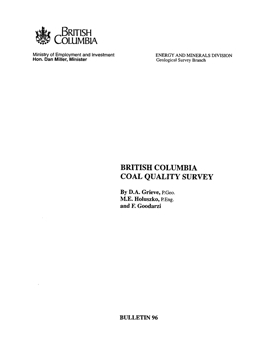
D.A. Grieve, M.E. Holuszko and F. Goodarzi
Bulletin 96 is a general overview of coal quality in all of British Columbia'a major coalfields. It contains compilations of data from two main sources: analysis of raw coal samples collected from active coal mines; and, raw coal analytical data contained in coal assessment reports on file with the Ministry of Employment and Investment. Bulletin 96 is intended to provide a basic, yet thorough, introduction to the subject.
Aspects of coal quality dealt with in this publication include: coal petrography (rank & maceral composition); proximate analysis; ultimate analysis; sulphur and sulphur forms; calorific value; mineral matter; ash chemistry; phosphorus; trace elements; and, caking properties. Note that not all types of data are available for all the coalfields. Geological setting of the various coalfields is provided. There is an emphasis on documenting variations in coal quality parameters, and on determining their interrelationships and controls. Comparisons with world coals are made, and comments on suitability of British Columbia coals for various end users are included.
Bulletin 96 is a companion publication to the previously released Paper 1994-2, "Washability Characteristics of British Columbia Coals" by M.E. Holuszko.
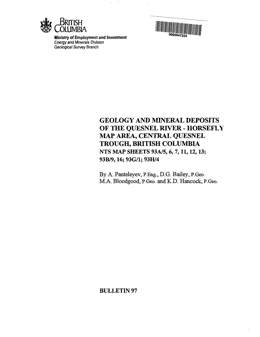
A. Panteleyev, D.G. Bailey, M.A. Bloodgood and K.D. Hancock
Bulletin 97 notes that the Quesnel and Horsefly rivers of central British Columbia traverse the northwesterly trending axis of the central Quesnel belt, also known as the 'Quesnel Trough'. Since 1859 the region has been the site of significant placer gold production including some very large-scale mining operations. The identification of bedrock source areas for the placer gold and definition of the various mineral deposit types in this region are the main objectives of this field study. Recent economic interest has been concentrated on the Mount Polly (Cariboo-Bell) alkalic porphyry copper-gold deposit, the QR intrusion-related propylite-type gold deposit and the Frasergold and CPW (Spanish Mountain) auriferous quartz vein prospects in the black phyllite basal map unit. Recent road building related to ongoing logging in the area provides new bedrock exposures in this region of otherwise sparse outcrop.
Studies in the map area, all within 'Quesnel Terrane', confirm the presence of a regional synclinal structure formed within a Triassic continent-margin basin. It was infilled first with Triassic sediments and then Triassic to Jurassic volcanic rocks. Together these rocks constitute the Quesnel Trough. The basal lithologic units consist of mid-Triassic siliceous rocks to mainly younger pelitic, thinly bedded deposits with overlying, more massive volcaniclastic sediments. The younger epiclastic units pass upward or interfinger with Upper Triassic subaqueous volcanic deposits, mainly volcanic flow and breccia units. They are overlain in turn by subaqueous to subaerial Lower Jurassic volcanic flow and pyroclastic rocks and overlapping lower to Middle Jurassic sedimentary assemblages. The volcanic rocks, and some Early Jurassic plutons, form the extensive magmatic edifice that defines the medial axis of the Quesnel island arc.
The older, submarine lavas, mainly olivine and pyroxene basalts of alkalic basalt to basaltic trachyandesite composition, are overlain by both subaqueous and subaerial, dark green-grey to maroon-purple feldspathic lavas and pyroclastic deposits of trachybasalt to trachyandesite composition, alternatively classified as rocks of the absarokite-shoshonite series or shoshonite association. Many of the lavas are characterized by analcite phenocrysts. Modal quartz does not occur in any of the arc rocks; the majority of chemical analyses reveal alkalic whole-rock compositions with characteristic normative nepheline.
The basal clastic rocks now form a continuous structurally complex black phyllite to metapelite unit along the eastern side of the map area. The rocks are well foliated at deeper structural levels but pass upward into weakly cleaved rocks. They are overlain by thick panels of the extensively block faulted volcanic successions. The basal sedimentary rocks are regionally metamorphosed to greenschist facies in the easternmost part of the map area. Metamorphic grade in the volcanic rocks is subgreenschist, consistent with burial metamorphism. Commonly there is extensive chloritization of mafic minerals; zeolite and calcite fill amygdules and occur in fractures in rocks throughout the region. Some zones of epidote, chlorite, tremolite, calcite and minor quartz represent locally developed propylitic alteration that can be related to nearby intrusive activity. Copper-gold and gold mineralization is associated with a number of the Early Jurassic diorite and zoned alkalic gabbro to syenite stocks that are intruded along the axis of the volcanic arc at intervals of about 11 kilometres.
The predominantly fine-grained elastic basin-fill rocks structurally overlie a thin, tectonically emplaced oceanic crustal slice, the Crooked amphibolite, part of the Slide Mountain Terrane. It defines the terrane boundary with the older metamorphic rocks of the Barkerville Subterrane (a subdivision of Kootenay Terrane) to the east. Middle Jurassic and (?) younger polylithic conglomerate lenses and thinly bedded, fine-grained elastic rocks are preserved in narrow fault-bounded wedges along the western terrane boundary of the Quesnel rocks with Cache Creek Terrane. In addition, a sinuous band of distinctive conglomerates of possible Cretaceous age and fluvial origin overlaps Quesnel arc rocks along Quesnel Lake and Quesnel River in the central part of the map area.
The volcanic rocks, and some Early Jurassic plutons, form the extensive magmatic edifice that defines the well mineralized medial axis of the Quesnel island arc. Copper-gold and gold mineralization is associated with many of the stocks; major deposits are the Mount Polley porphyry copper deposit and QR gold mine. The basal black phyllite assemblage contains gold-quartz veins and is the likely source-area for much of the placer gold in the Horsefly River and upper Quesnel River regions. The potential of the Au-quartz veins has been examined in the past and prospects are now being tested for their bulk-mineable gold potential.
Eocene extensional faulting and magmatism disrupted the Quesnel Trough following a period of deep tropical weathering. Graben development, with attendant ash-flow eruptions and lacustrine deposits, characterizes this time period. Hydrothermal activity, possibly related to subvolcanic intrusions, produced tourmaline-sericite and propylitic alteration (for example, the Megabucks copper-gold prospect). Elsewhere incipient epithermal quartz-carbonate veining is evident. Mid-Miocene and younger basalts covered parts of the Eocene grabens and older arc rocks of Quesnel Terrane, and the tectonic boundary with Cache Creek rocks to the west, a high-angle fault. In places the basalt flows cap older Miocene fluvial systems that contain placer gold. Both preglacial and postglacial rivers flowing out of the metamorphic highlands to the east have transported additional gold. Perhaps more importantly, postglacial rivers and some of the smaller creeks have locally redistributed and concentrated gold from older placer deposits. The main bedrock sources for the placer gold appear to be in the eastern part of the study area where (?) Late Jurassic quartz veins occur in the basal black phyllite unit near the terrane boundary of Quesnellia and the high-grade metamorphic rocks of the Barkerville Terrane.
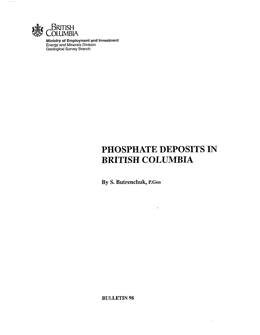
S. Butrenchuk
In the British Columbia Cordillera, sedimentary phosphate beds are reported from 14 stratigraphic units, and range in age from Middle Cambrian to Early Jurassic. The principle focus of this study has been the distribution, and assessment of economic potential for these sedimentary phosphatic occurrences, as well as for igneous phosphate in carbonatites.
This 135 page report contains chapters on B.C.phosphates and describes the stratigraphy, petrography and mineralogy, geochemistry, beneficiation and processing, world supply and demand projections, and assessment of resource potential. Twenty tables, 63 figures and maps, 34 photos and 21 appendices compliment the text of the report.
Deposits of Triassic and Jurassic age offer the best potential for future development in British Columbia. The Fernie basin phosphates of Jurassic age occur over a large area of southeastern B.C. and this study outlines a pattern in chemical composition changes which are considered important for any economic evaluation. The study also identified significant yttrium values which could be a viable by-product to phosphate production. Triassic strata containing phosphates in northeastern B.C. have thickness and grades similar to the phosphates near Fernie. The most promising area is between Watson Peak and Meosin Mountain near Wapiti Lake. In addition a large phosphate resource is present at the Aley carbonatite, and could conceivably be co-produced if a niobium mine is developed.
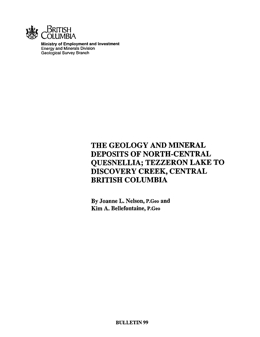
J. Nelson and K.A. Bellefontaine
The Nation Lakes area, located north of Fort St. James in the Quesnel Terrane, contains a cluster of Early Mesozoic alkalic porphyry Cu-Au mineral deposits. The very large Mt. Milligan deposit lies within the project area centred on two minor intrusive bodies, the MBX and Southern Star stocks. This report summarizes the results of 3 years of mapping (1990-92), covering four and a half 1:50 000-scale map sheets. This study is a significant advance in understanding the geology of central Quesnellia. The Late Triassic Group is divided into four separate successions, and some rocks included previously within the Takla Group are demonstrated to be Early Jurassic. Early Jurassic zircon ages clustered around 206 and 189-182 Ma, show that two intrusive/metallogenetic episodes occurred, near the end of Takla Group and Early Jurassic volcanism. Large alteration haloes, associated with the porphyry mineralization have been defined. The report is accompanied by a coloured, 1:100 000-scale geology map.
North-central Quesnellia includes Late Paleozoic island arc and oceanic subterranes, the Lay Range and Slide Mountain, respectively; but its identity is based primarily on the voluminous deposits associated with the Early Mesozoic Quesnel arc, a fossil intraoceanic island arc. The Quesnel arc had two phases of development, Late Triassic and Early Jurassic. Its Late Triassic inception is represented by the Takla Group. In the Takla Group, basal Carnian (to Norian?) basinal sedimentary rocks of the Slate Creek succession are overlain by late Carnian to Norian volcanic and volcaniclastic successions: the Inzana Lake, Witch Lake, Willy George and Plughat Mountain successions. Considerable facies variability within the Late Triassic arc is reflected by the application of these local names, which depict discrete volcanic centres that overlie but also grade laterally into epiclastic deposits. The Triassic early phase of arc development was dominated by augite-phyric basalt and alkalic basalt (shoshonite suite) volcanism, although rocks of more felsic compositions are also present. The Triassic arc volcanic successions are overlain paraconformably by Early Jurassic volcanic suites, the Chuchi Lake and Twin Creek successions. This depositional break corresponds to a volcanic hiatus but not to any discernible deformation. The Early Jurassic suites show much greater compositional heterogeneity than the Late Triassic successions, and also dominance by plagioclase and plagioclase-augite phyric, subalkaline to shoshonitic lithologies. They probably represent a more mature arc developed on thicker crust. A sedimentary interval within the Chuchi Lake volcanic succession is of early to late Pliensbachian age.
The Quesnel arc is important from an economic point of view, due to a rich endowment of alkalic porphyry copper-gold mineral deposits. The very large Mt. Milligan deposit, discovered in 1987, lies within the project area. It centres on two minor intrusive bodies, the MBX and Southern Star stocks, which are crowded-porphyritic monzonites texturally similar to those that host all of the alkalic porphyry deposits of Quesnellia. Mt. Milligan is part of a much more extensive local swarm of porphyry deposits and potassic-propylitic alteration zones, located south of the southeastern end of the Hogem batholith. Early Jurassic zircon ages from intrusive bodies associated with porphyry-style mineralization in this area, clustered around 204 and 189-182 Ma, show that intrusive/metallogenetic episodes occurred during the later history of the Quesnel volcanic arc, near the ends of the two volcanic episodes described above.
Major transcurrent and related faults of Cretaceous and Early Tertiary age transect the Bulletin 99 project area, juxtaposing strata of widely varying ages including Early Tertiary graben fill. Strands of the Manson-McLeod system, the Discovery Creek fault, and one splay of the Pinchi fault are recognized. These faults have made geologic mischief in obscuring previous structural relationships between the Lay Range and Slide Mountain terranes and the Quesnel arc, and in truncating the eastern edge of the Mt. Milligan deposit.
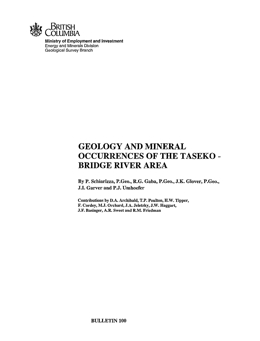
P. Schiarizza, R.G. Gaba, J.K. Glover, J.I. Garver and P.J. Umhoefer
Bulletin 100 describes the geology of a 3200-square-kilometre area covering NTS map sheets 92O/2, 3 and portions of sheets 92O/1, 92J/15, 16, which are mainly within the Chilcotin Ranges of the southeastern Coast Mountains. The area is underlain by late Paleozoic to Tertiary rocks that include the oceanic Bridge River Terrane, the volcanic arc-derived Cadwallader and Methow terranes, ophiolitic rocks of the Shulaps and Bralorne-East Liza complexes, and the Jura-Cretaceous clastic sedimentary rocks of the Tyaughton-Methow basin. These assemblages are juxtaposed across complex systems of contractional, strike-slip and extensional faults of mainly Cretaceous and Tertiary age. This Bulletin describes and defines the major lithotectonic units and the structures that deform and bound them. It also describes the mineral occurrences of the area, which includes the northern part of the Bridge River mining camp, and interprets their genesis in terms of the Cretaceous and Tertiary structural and magmatic evolution of the area. In the final chapter, regional correlations of lithotectonic assemblages and structures are discussed, and an interpretive summary of the tectonic evolution of the southeastern Coast Belt is presented. The report is accompanied by numerous photos, data tables, maps and illustrations, as well as a 1:100 000-scale geological map of the area with interpretive cross-sections.
Bulletin 101-111
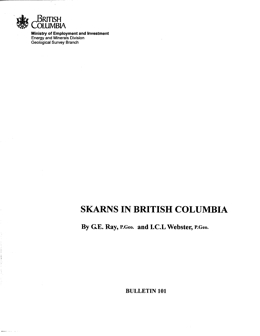
G.E. Ray and I.C.L. Webster
Bulletin 101 discusses skarns in British Columbia. There are at least 735 skarns in BC. They range from small occurrences to extensive skarns that are associated with metal deposits exceeding 30 million tonnes of ore. The overwhelming majority have calcic mineral assemblages (garnet-clinopyroxene-epidote-wollastonite); the rarity of magnesian skarns with olivine-serpentinite-phlogopite gangue assemblages reflects the absence of major plutonism in areas with extensive platformal dolomites in BC.
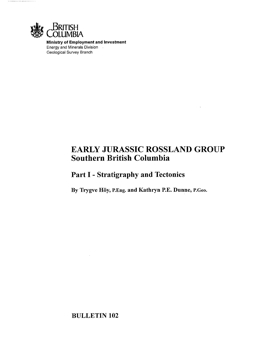
T. Höy and K.P.E. Dunne
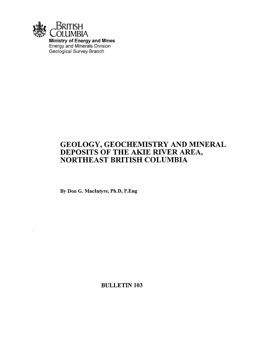
D.G. MacIntyre
The Akie River area of the northeast Rocky Mountains has the potential to be one of the most important future Zn-Pb-Ag producing mineral districts in British Columbia. Here, large tonnage sedimentary exhalative barite-sulphide mineral deposits such as the Cirque, Mt. Alcock, Elf and the recently discovered Akie occur within an 80 kilometre long belt of Late Devonian basinal facies sedimentary rocks of the Kechika Trough.
Bulletin 103 summarizes the results of 3 years of mapping in the districts and covers all or part of the 94F/1,2,7,10 and 11, 1:50,000 scale NTS map sheets. Also included are updates on recent exploration activity and research in the district. The report describes in detail the geology of the district with emphasis on regional stratigraphy and structure. Separate chapters discuss the results of lithogeochemistry and sulphur isotope analyses, important mineral deposits and the regional metallogeny. In addition to the 22 figures, 8 plates and 7 tables that accompany the text, the Bulletin also includes a coloured 1:100,000 scale geological map with interpretive structural cross sections and appendices of geochemical analyses, fossil identifications, and mineral occurrences located during the course of mapping.
Thick westward prograding clastic wedges that were deposited along the margin of ancestral North America from Mid Proterozoic to Mid Paleozoic time. Periodic rifting and tectonic subsidence resulted in the formation of starved sub-basins along this otherwise passive continental margin. These sub-basins host important sedimentary exhalative barite-zinc-lead-silver deposits.
In northeast British Columbia, a thick succession of Paleozoic basinal facies clastic rocks is preserved within the northwest trending, Kechika Trough. Within the trough, sedimentary exhalative barite and barite sulphide deposits occur in starved basin sediments of Middle Ordovician, Early Silurian and Late Devonian age. The latter are the most economically significant and are hosted by carbonaceous cherty argillites and siliceous shales of the Middle to Late Devonian Gunsteel formation of the Lower Earn Group. The largest deposit is the Cirque, with reserves in excess of 35 million tonnes averaging 10 percent combined lead-zinc and 47 grams per tonne silver. Other potentially significant deposits include Driftpile Creek, Bear, Mt. Alcock, Fluke, Pie and Elf. Stratiform barite deposits are also common, particularly near the basin to shelf transition zone.
Late Devonian barite-sulphide deposits are typically zoned with interlaminated barite-sphalerite-galena-pyrite occurring near suspected vent areas and grading outward into bedded barite. Beds of laminar-banded pyrite typically occur in hangingwall siliceous shales, particularly above the inferred vent zone. Epigenetic stringer sulphide zones are not recognized and footwall alteration is generally absent, implying that the deposits formed from ponded brines at relatively low temperature. Away from the main deposits the favourable stratigraphic interval is recognized by the presence of thin beds of nodular and laminated barite and thin laminae of pyrite in the shales. Thin tuff beds also occur locally in this stratigraphic interval and are evidence for a Late Devonian volcanic event.
A paleogeographic reconstruction of the Kechika Trough in Late Devonian to Mississippian time suggests barite-sulphide deposits formed in third order starved basins between uplifted, northwest-trending horst blocks that were capped by shallow water carbonate banks. The presence of intraformational breccias suggests fault movement accompanied barite-sulphide precipitation. This tectonic activity may have allowed the escape of heated, overpressured metalliferous brines from permeable reservoirs within the sedimentary pile. Sedimentary exhalative deposits formed where these brines were exhaled onto the seafloor and ponded in anoxic seafloor depressions.
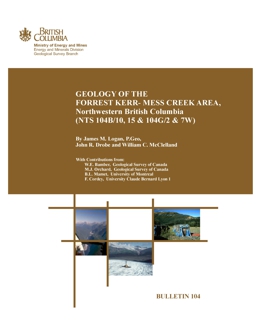
J.M. Logan, J.R. Drobe and W.C. McClelland
Bulletin 104 describes the geology and mineral deposits of the Forrest Kerr-Mess Creek map area, which straddles the boundary between the Intermontane and the Coast belts in northwest British Columbia. This region is underlain by rocks comprising the western boundary of the Stikine Terrane (Stikinia).
At this latitude Stikinia consists of well stratified, middle Paleozoic to Mesozoic sedimentary rocks and volcanic and comagmatic plutonic rocks of island-arc affinity which include: the Early Devonian to Permian Paleozoic Stikine assemblage, the Late Triassic Stuhini Group and the Early Jurassic Hazelton Group. These are overlapped by Middle Jurassic to early Tertiary successor-basin sediments of the Bowser Lake and Sustut Groups, Late Cretaceous to Tertiary continental volcanic rocks of the Sloko Group, and Late Tertiary to Recent bimodal shield volcanism of the Edziza and Spectrum ranges.
Warm-spring, tufa deposits forming in the Mess Creek valley attest to areas of dynamic geological evolution in modern day.
Polyphase deformation affects rocks that are older than Late Cretaceous, and crustal scale faults affect rocks in the area as young as Tertiary. Early and middle Devonian rocks within the map area have been subjected to up to four phases of folding and deformation. Mid-Carboniferous to Early Permian rocks record as few as two phases of deformation, whereas the Late Triassic and Jurassic strata record no more than two phases of deformation and record a regionally important post-Norian unconformity. Mid-Devonian, northeast-verging D1 structures correspond to a northern Cordilleran-wide event correlative with the Antler Orogeny of the southwest United States and Ellesmerian Orogeny in the arctic. Pre-Norian, Permo-Triassic (Tahltanian Orogeny) D2 deformation was accompanied by upper greenschist facies metamorphism. Early Jurassic, D3 (circa 185 Ma) deformation broadly warped and folded the rocks into upright, open structures. Late Jurassic to Tertiary contraction (D4) produced northeast-verging structures related to development of the Skeena Fold and Thrust Belt. The youngest structures record east-west extension and northerly translation, thought to post date the Eocene.
The Late Paleozoic and Mesozoic volcanic and plutonic rocks within the map area are characterized by metal deposits related to island-arc volcanic centres. Mineral production is not recorded within the map area although large copper, gold and molybdenum mineral resources are defined for porphyry deposits at Schaft Creek (971 495 000 tonnes grading 0.298 %Cu, 0.033 % MoS2, 0.14 g/t Au and 1.20 g/t Ag; Spilsbury, 1995) and Galore Creek (Central zone: 233 900 000 tonnes grading 0.67 %Cu, 0.35 g/t Au and 7.0 g/t Ag; Enns et al., 1995). Mineral occurrences and prospects in the Forrest Kerr - Mess Lake area can be grouped into four main categories: calcalkaline Cu-Mo-Au and alkaline Cu-Au porphyries; Cu and Cu-Au skarns; subvolcanic Cu-Ag-Au (As-Sb) fault and shear-hosted veins and carbonate hosted replacement; and, stratiform volcanogenic massive sulphide and carbonate hosted (?Irish-type) Zn-Pb-Ag deposits. Mineral occurrences, within the map area, display (except stratiform types) a direct correlation with north and northeast striking faults and Late Triassic to Early Jurassic intrusive rocks.
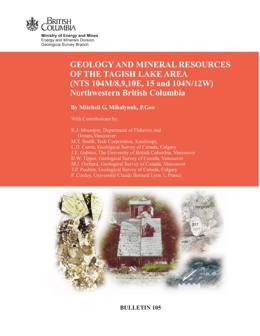
M.G. Mihalynuk
Bulletin 105 is the first comprehensive report published on the rich, metal endowed Tagish area in northwestern British Columbia, and it is the first Bulletin to be produced digitally for Web posting. The Bulletin is accompanied by Geoscience Map 1997-1 at 1:100 000 scale.
Bordered to the north by the Yukon and straddling the Coast - Intermontane Belt contact, the Tagish area overlaps a gold-antimony-arsenic geochemical province which is anomalous on a provincial scale. Bulletin 105 illuminates the tapestry of events that created mineralizing systems and reveals a billion years of geological history within the broader context of Cordilleran evolution. In addition to previously undocumented geological relationships, Bulletin 105 presents critical new data sets including more than 20 new isotopic age dates, 60 new fossil ages, hundreds of analytical results, petrofacies data, paleoflow measurements, age date compilations, and hypothetical crustal cross sections.
Bulletin 105 covers the geology and mineral deposits of the Tagish area, which is located in the northwest corner of British Columbia. The area is bounded by the Yukon border to the north, rugged Coast Mountains to the west, and Atlin Lake, British Columbia’s largest natural water reservoir, to the east. It is an area with a colourful mining history that blossomed during the Klondike gold rush and discovery of the Atlin placers in 1898. It is richly endowed with mineral showings and one mine, the Engineer, having produced over 560 000 grams of gold. A belt of anomalously high regional gold-arsenic and antimony geochemistry extends the length of the area, coextensive with the crustal-scale Llewellyn fault.
Three crustal fragments of strikingly different character that converge in the Tagish area dominate the geology. In the east are weakly metamorphosed, Carboniferous to Triassic oceanic plateau remnants of the northern Cache Creek Terrane, here known as the Atlin complex. In the west are two suites of metamorphic rocks that comprise a polydeformed belt belonging to the Yukon-Tanana Terrane: a pre-Mississippian, quartz-rich clastic succession of pericratonic origin; and a Devonian to Permian, heterolithic suite interpreted to correlate with volcanic arc strata of the Stikine Terrane. Sandwiched in between are Triassic arc, clastic arc apron, and overlying Jurassic basinal strata of the Whitehorse Trough. They are juxtaposed across two crustal-scale faults, the Nahlin to the east and Llewellyn to the west, that brought the crustal fragments together, mainly in Triassic to Middle Jurassic times. Geological interrelationships are complicated by structural intermixing and by voluminous Late Cretaceous and Eocene intrusion of the Coast Plutonic Complex. Pre-Jurassic deformational histories of each crustal fragment are distinctive, but all are affected by early Middle Jurassic, predominantly south and west-verging folds and thrusts that shortened and stacked the fragments. Reactivation of major faults and subsidiary splays is apparent from dextral offsets that affect rocks as young as Eocene.
Quartz-rich clastic rocks of the Yukon-Tanana Terrane are rifted relicts of ancestral North American margin across which the Paleozoic and Mesozoic arc complexes of Stikinia and Quesnellia were linked, similar to the manner in which the Aleutian and Japan arcs are joined across ensialic crust of Kamchatka. Stikinia was rotated counter-clockwise throughout the Early Mesozoic, entrapping relicts of oceanic plateau of the Atlin complex prior to collision with Quesnellia in early Middle Jurassic time. Near orogen-parallel fault displacements modified the terrane distribution into the Early Tertiary.
Yukon-Tanana terrane, Whitehorse Trough and Atlin complex display different styles of mineralization. In the Atlin complex, gold-quartz veins are developed in mafic and ultramafic rocks. Although important placer production has been has been attributed to this source, no significant past gold production has come from lodes. Oceanic mafic rocks are also prospective for Cyprus-type massive sulphide copper-zinc mineralization, but none is known here.
Old Yukon-Tanana Terrane rocks were deposited in part during rifting of the North American continental margin, a setting in which sedimentary exhalative deposits accumulated elsewhere in the Cordillera. Younger Yukon-Tanana terrane rocks were deposited in a volcanic arc environment. The arc package includes felsic submarine volcanics, which may have correlatives in the Tulsequah area where such rocks host Kuroko-style volcanogenic massive sulphide accumulations like at the Tulsequah Chief deposit. Upper Triassic arc rocks of the Whitehorse Trough are lithologically and temporally equivalent to those hosting important copper-molybdenum-gold porphyry deposits in southern British Columbia. Although they are not voluminous, synsedimentary volcanic rocks in the Early Jurassic trough strata may hold potential for shallow subaqueous hot spring deposits rich in gold and silver like those at the Eskay Creek mine.
Cretaceous and younger plutons cross the crustal fragment boundaries. Cretaceous plutons produce copper skarn mineralization where they cut Upper Triassic carbonates in the Whitehorse Copper Belt, and the southern end of the belt may extend into the Tagish area. Tertiary plutons and coeval volcanic rocks are associated with gold skarn mineralization in the northern Tagish area, and with epithermal gold mineralization in both the Tagish area and southern Yukon.
Crustal-scale faults, as well as related secondary faults, provide conduits for pluton emplacement and subsequent mineralizing hydrothermal systems. Thus, they are important environments for thermal aureole gold deposits.
Deep epithermal gold mineralization at the Engineer Mine developed adjacent to splays of the Llewellyn fault, and is probably coeval with a nearby Eocene volcanic centre. High mineral potential exists in the Tagish area for a number of deposit types. Juxtaposition of three disparate crustal fragments has created mineral exploration opportunities as varied and challenging as the geology.
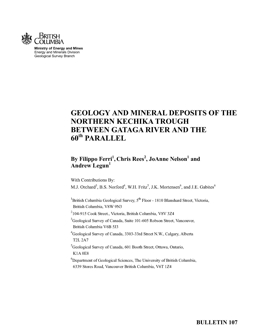
F. Ferri, C. Rees, J. Nelson and A. Legun
Bulletin 107 notes that the Kechika Trough represents a Lower Paleozoic basin developed between the MacDonald Platform to the east and the Cassiar Platform to the west. This basin was well established by Late Cambrian time and ceased to be a depositional entity at the beginning of the Late Devonian. Mapping along the western part of the trough, between the Gataga River and the 60th parallel, encountered layered rocks of Proterozoic to Cenozoic age. These include: Late Proterozoic siliciclastics, carbonates and volcanics; siliciclastics and carbonates of Cambrian age; Late Cambrian to Early Ordovician calcareous argillites and argillites of the Kechika Group; slate, siltstone and minor limestone of the Middle Ordovician to Middle Devonian Road River Group; Late Devonian to Early Mississippian argillite, chert and minor limestone of the Earn Group; chert, tentatively assigned to the Mississippian to Permian Mount Christie Formation; conglomerate and sandstone of possible Tertiary age; and Tertiary to Quaternary mafic volcanics assigned to the Tuya Formation.
Intrusive rocks represent a very minor component of the map area and consist of Early Paleozoic sills and dikes of gabbroic composition, feldspar porphyry dikes of Cretaceous or Tertiary age, and small Early Cretaceous stocks, dikes and sills of broadly granitic composition.
Periodic extensional tectonism during the Paleozoic, which led to the formation and subsequent modification of the Kechika Trough, was followed by intense, easterly directed, compressional tectonics and associated metamorphism of Mesozoic age, resulting in the present structural configuration. Rocks of the trough belong to the Rocky Mountain structural province and structures are dominated by easterly verging folds and thrusts. Thrust faulting predominates in the southern part of the map area where lithologies are dominated by thick, competent Cambrian carbonate and quartzite units. Their disappearance to the north results in a structural style dominated by folding and penetrative cleavage.
Sedimentary exhalative mineralization (sedex) represents the most important mineral deposit type found within the Kechika Trough, ranking it, and the more northerly Selwyn Basin, as one of the most important metallotects of the Canadian Cordillera. These stratiform Zn-Pb-Ag-Ba deposits are found at several stratigraphic levels: Cambrian, Middle Ordovician, Lower Silurian and Upper Devonian. Upper Devonian deposits are by far the most numerous and economically important within the map area, and throughout the Kechika and Selwyn basins. The large Cambrian and Early Silurian deposits found in the Anvil and Howards Pass districts, respectively, highlight the potential that all these horizons have for hosting economically significant sedex deposits. Tungsten-molybdenum porphyry/skarn mineralization related to Early Cretaceous intrusions is the next most important mineral deposit type. Minor lead, zinc and copper-bearing veins are scattered throughout the map area.
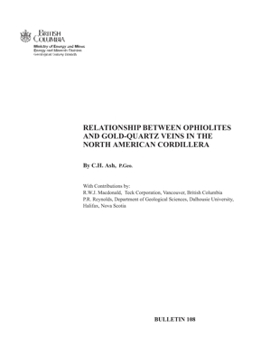
C.H. Ash
The primary topic of Bulletin 108 is ophiolite-related gold quartz veins in the North American Cordillera. It discusses the setting of lode and placer gold occurrences in proximity to ophiolitic rocks not only in British Columbia but also throughout the North American Cordillera. A new mineralization model is presented that concisely defines the characteristics of some gold occurrences associated with mafic-ultramafic rocks in orogenic belts. Details and interpretations of the geology in the Atlin area, within the Cache Creek Terrane, as well as in the Bralorne-Pioneer, Rossland, Barkerville and Cassiar areas of BC are presented, including comparative discussions of the Alaska-Juneau deposit, and California gold deposits such as Grass Valley and Motherlode.
There is an extensive description of ophiolite geology, the tectonic setting and descriptive geology for ophiolite-related deposits. The regional treatment and the detailed deposit geology presented in each chapter is a concise evaluation of the setting, process and deposit features for this distinctive Cordilleran gold deposit type.
This publication also details exploration criteria applicable to finding new occurrences or expanding potential for known deposits. The information presented is applicable to gold exploration in orogenic belts internationally.
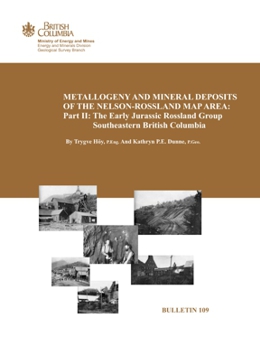
T. Höy and, K.P.E. Dunne
For the past 30 years government geological surveys have been conducting mineral resource assessments to provide information for planning processes about undiscovered mineral endowments. The Mineral Resource Assessments are useful in order to predict where mineral deposits are found and these estimates ensure that informed land use decisions are made. This paper describes the BC methodology and experience.
See GeoFile 2004-2 for a preliminary draft release.

